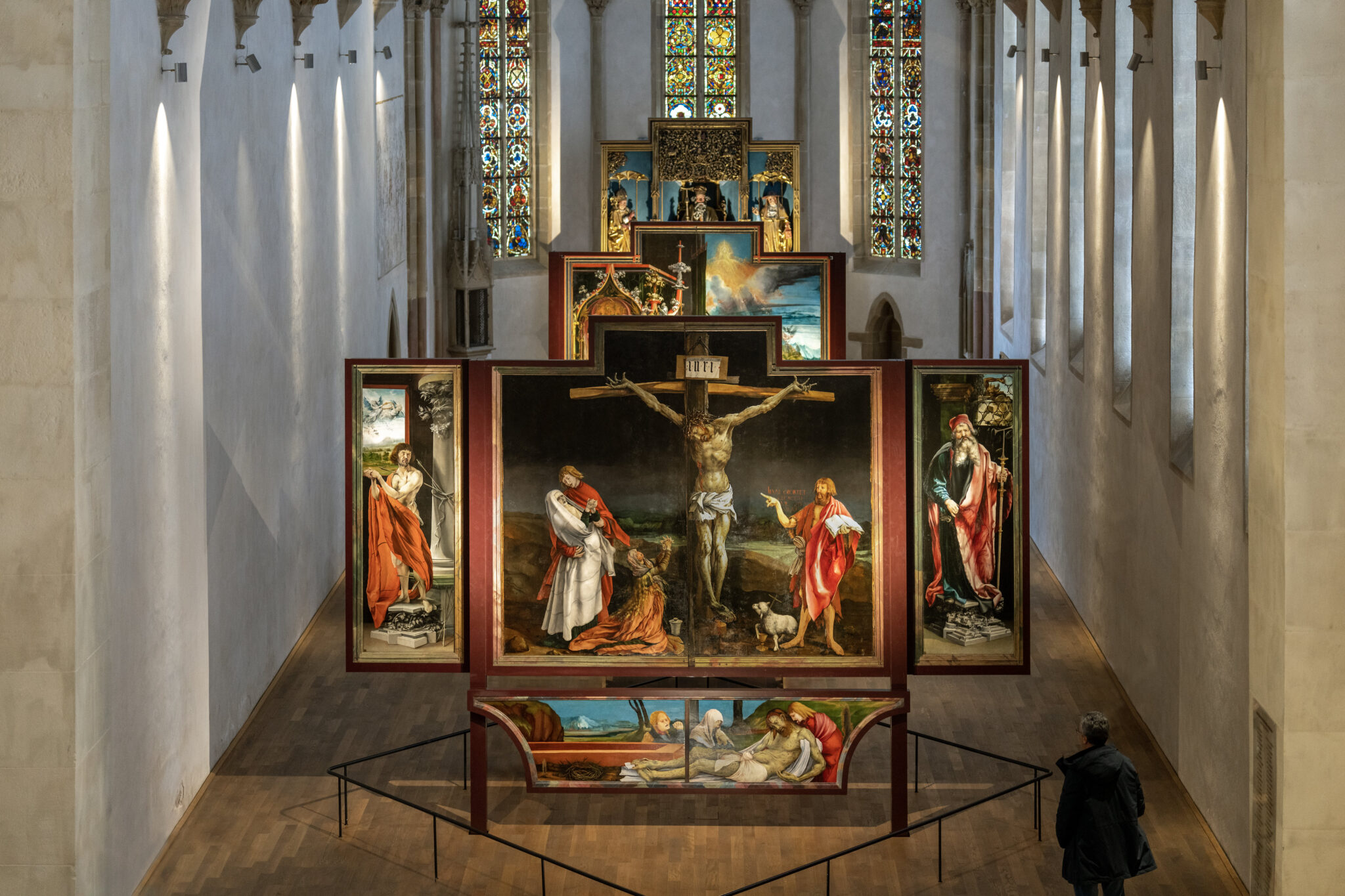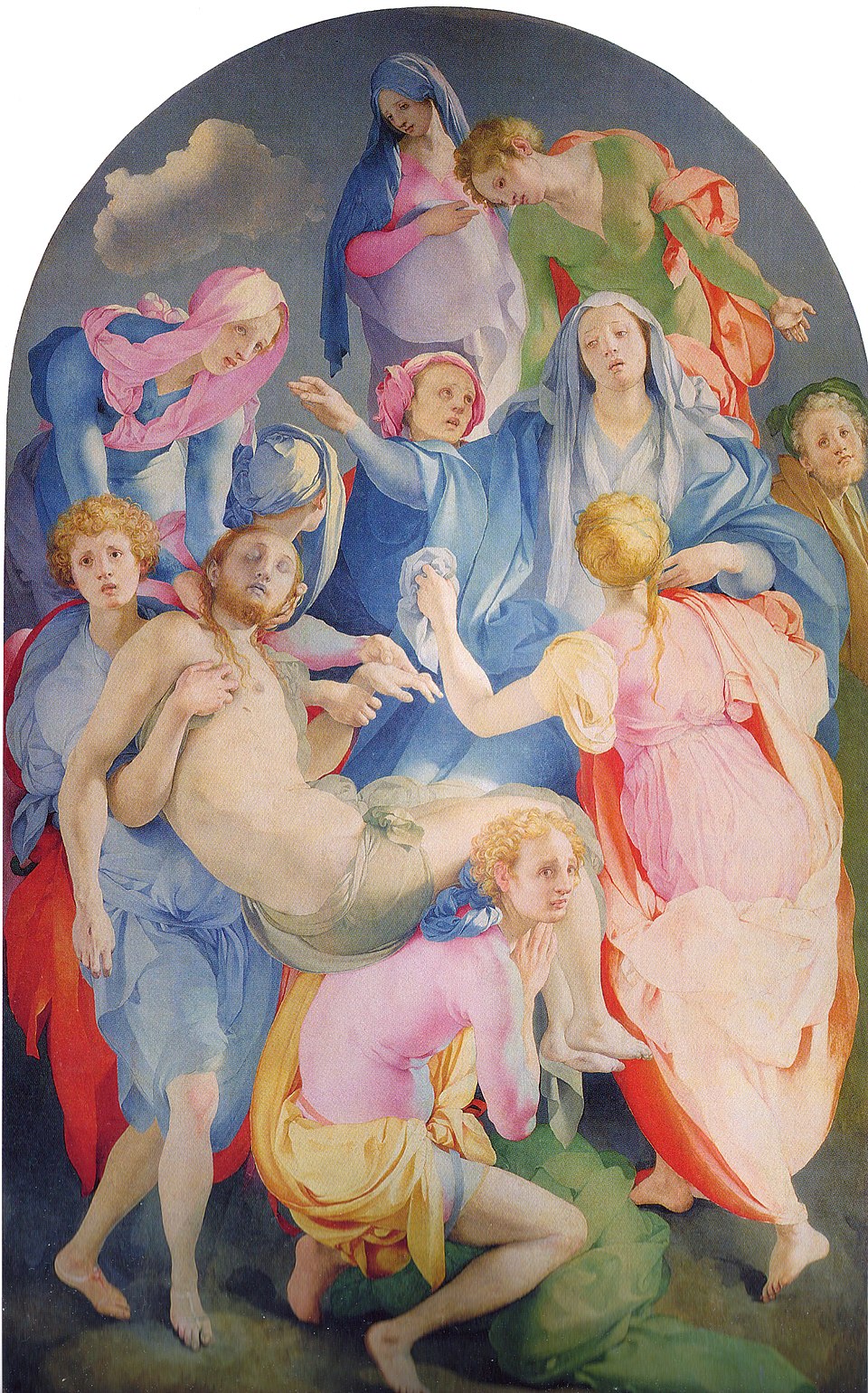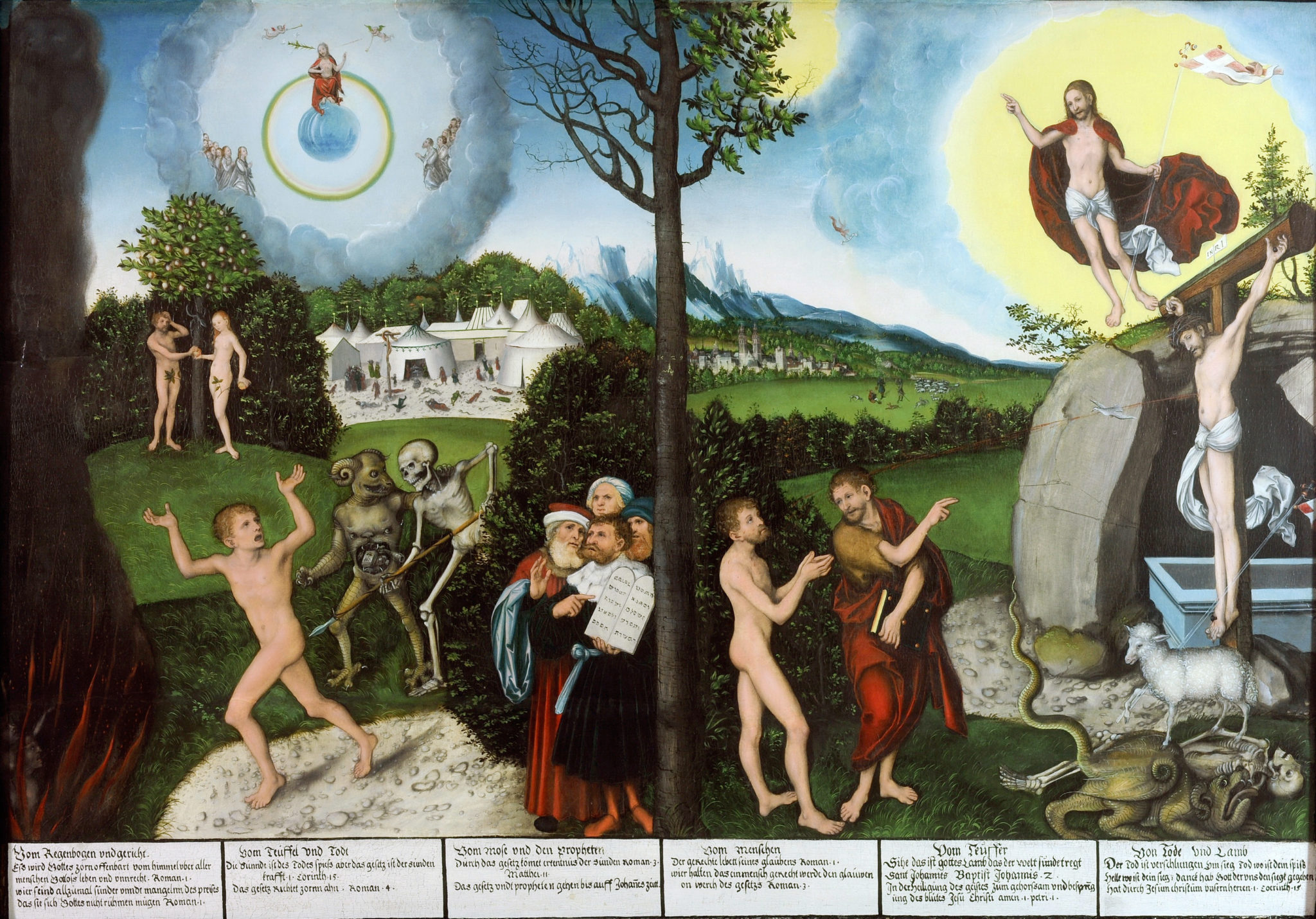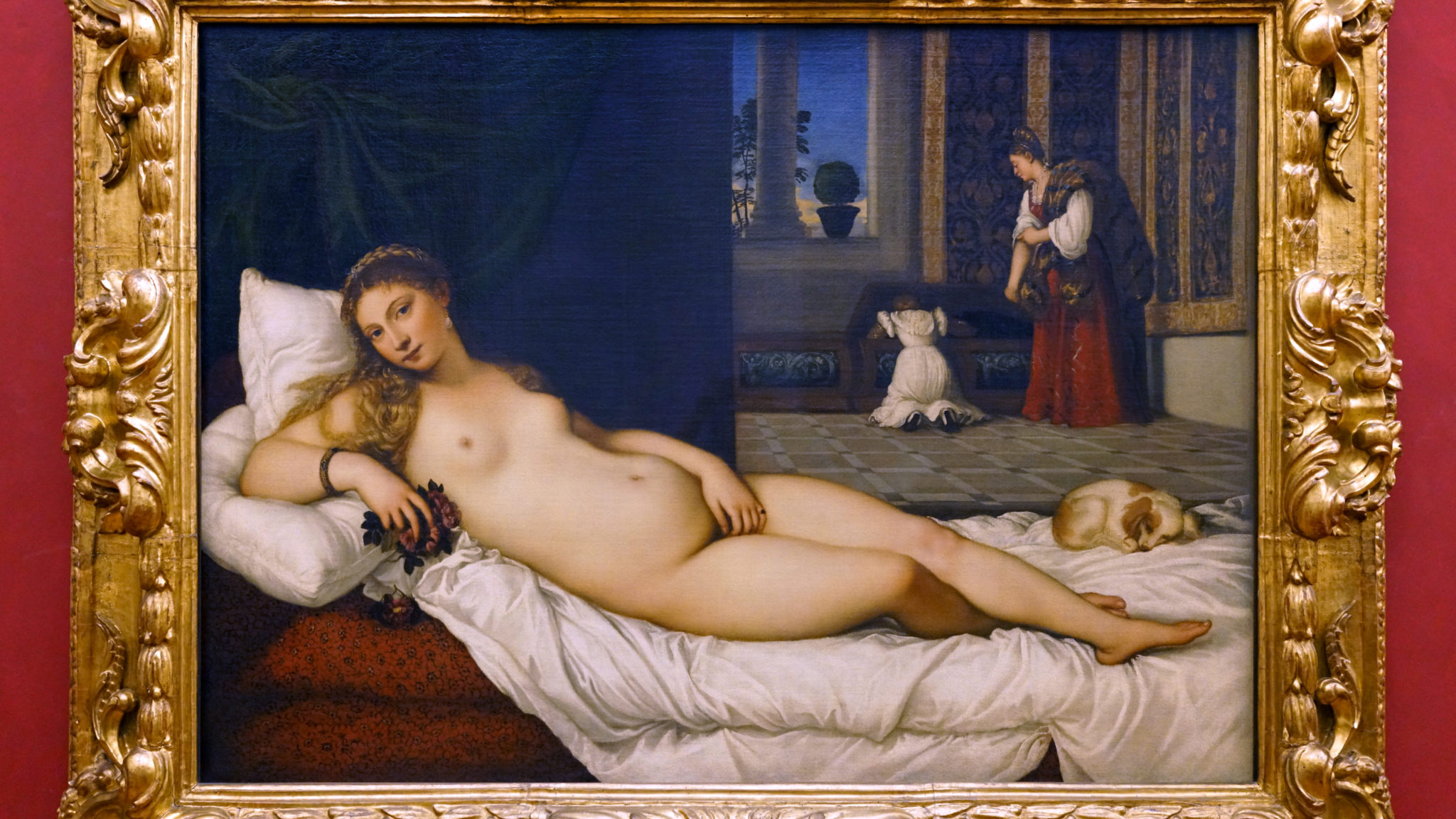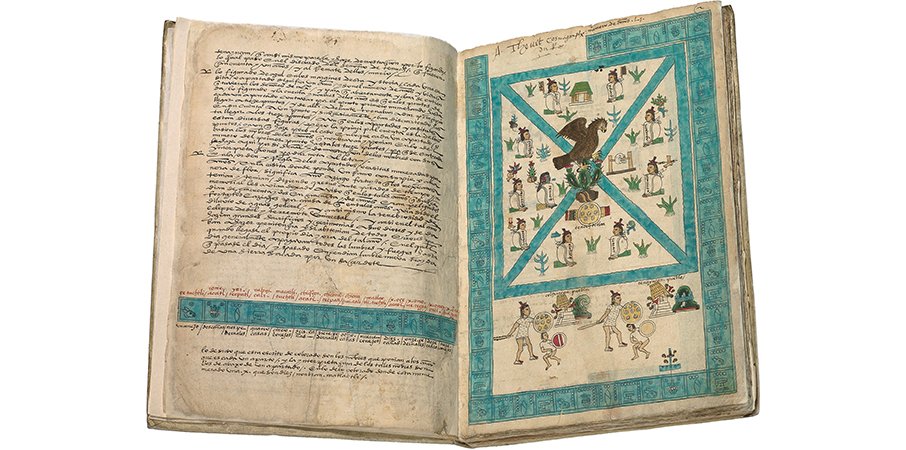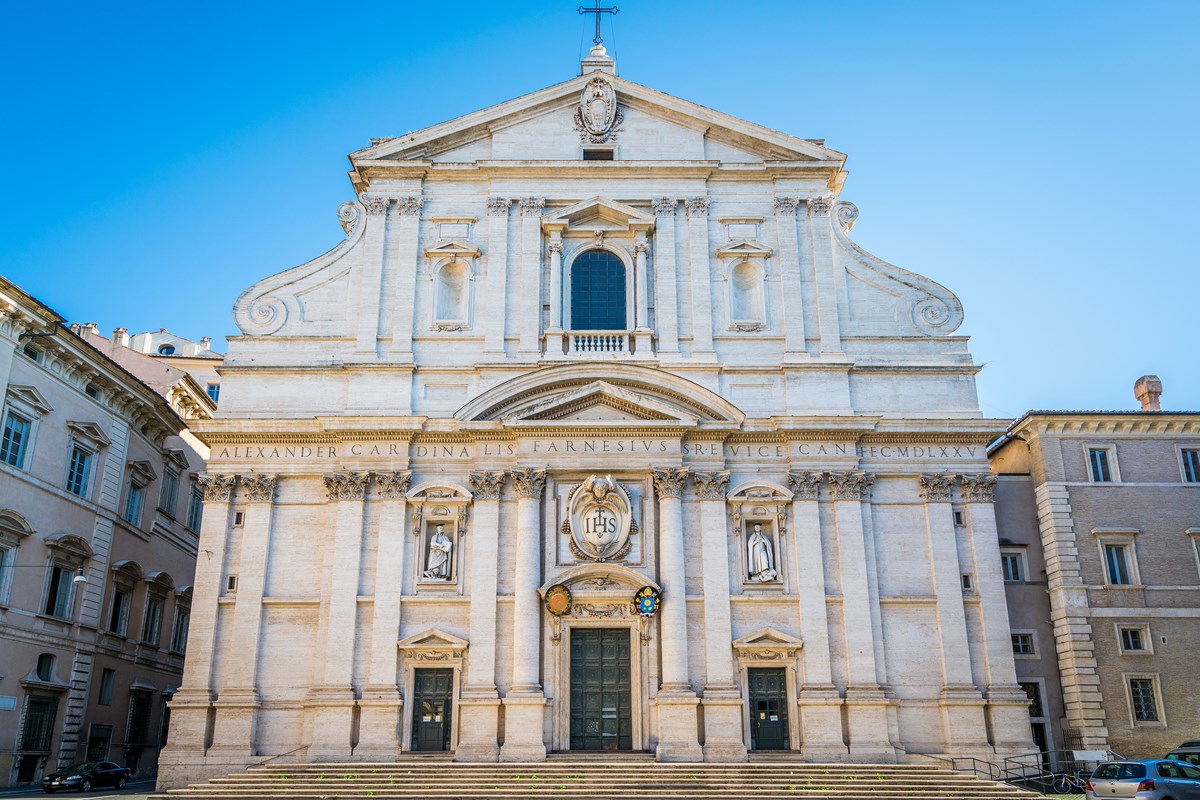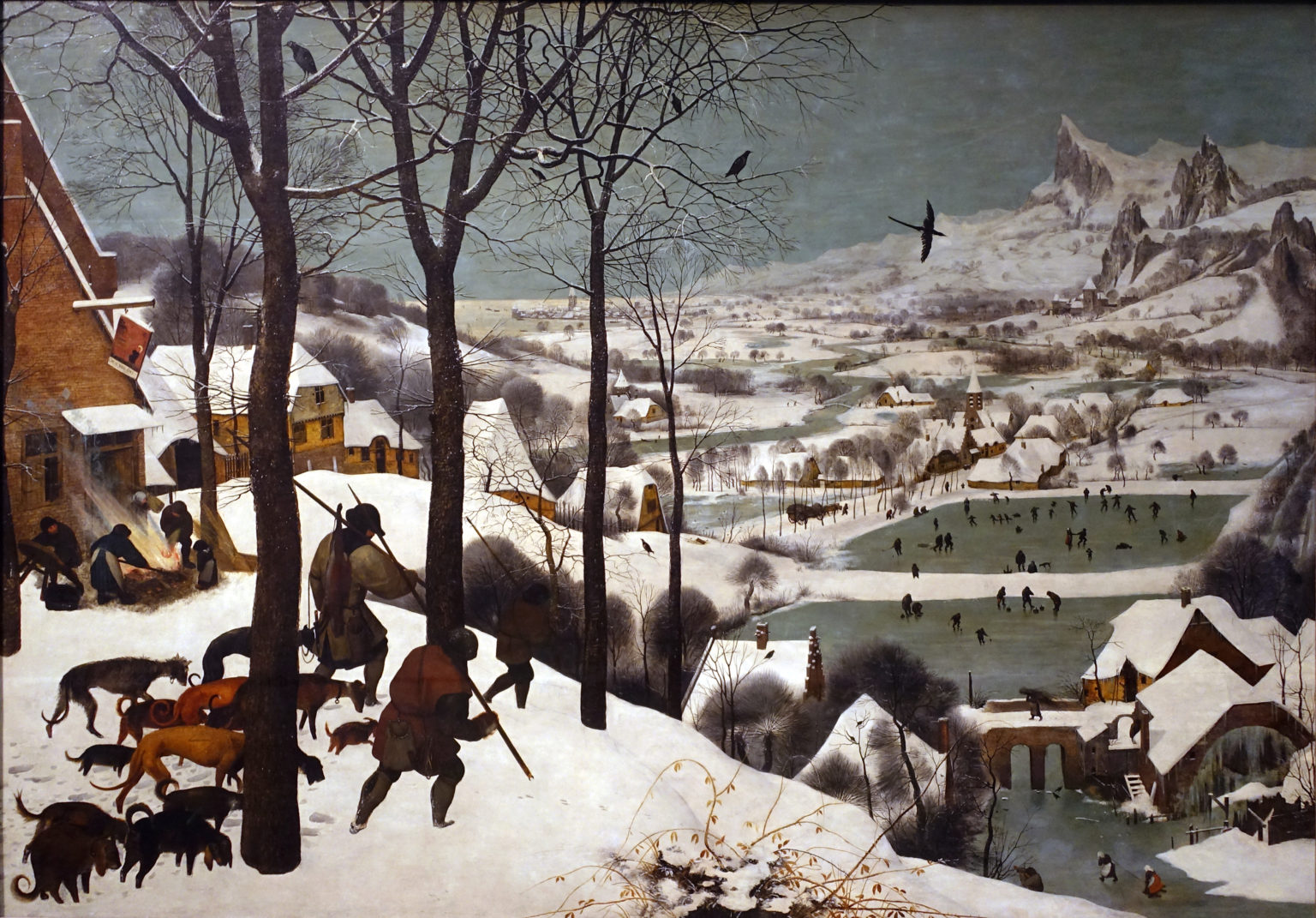AP Art History
1/82
There's no tags or description
Looks like no tags are added yet.
Name | Mastery | Learn | Test | Matching | Spaced |
|---|
No study sessions yet.
83 Terms
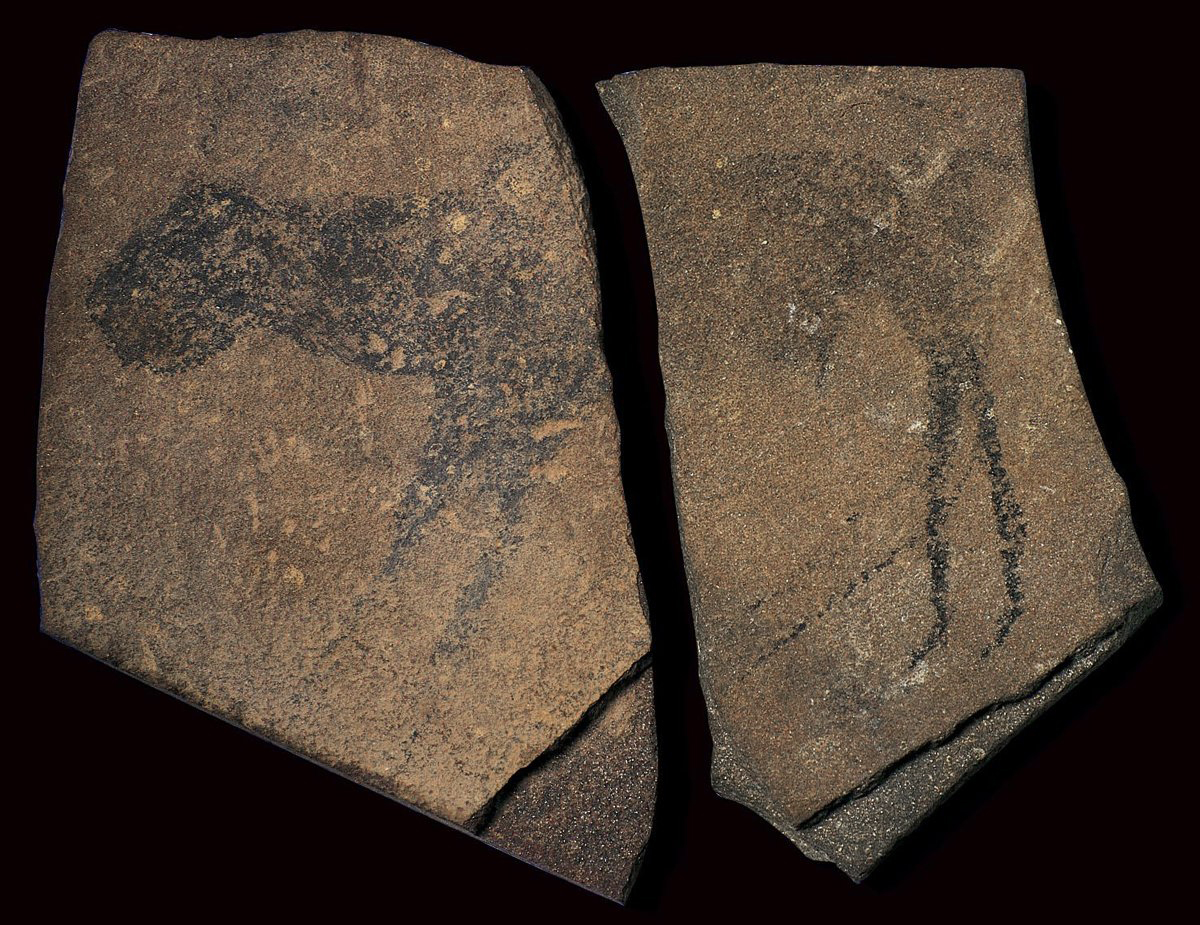
Apollo 11 stones, Namibia, c. 25,500- 25,300 BCE
Form: Charcoal, Hand sized, Brown/Grey quartzite, two stones, mobile art
Content: Animal/human (therianthrope), feline in appearance with human legs added later, Shamanism, other paintings and stones were found
Content: Found by WE Wendt in 1969, named after the Apollo 11 mission, the right half was found 3 years later, located in a dry gorge in Namibia, hunter gatherer society
Function: unknown, before human writing, maybe ritual
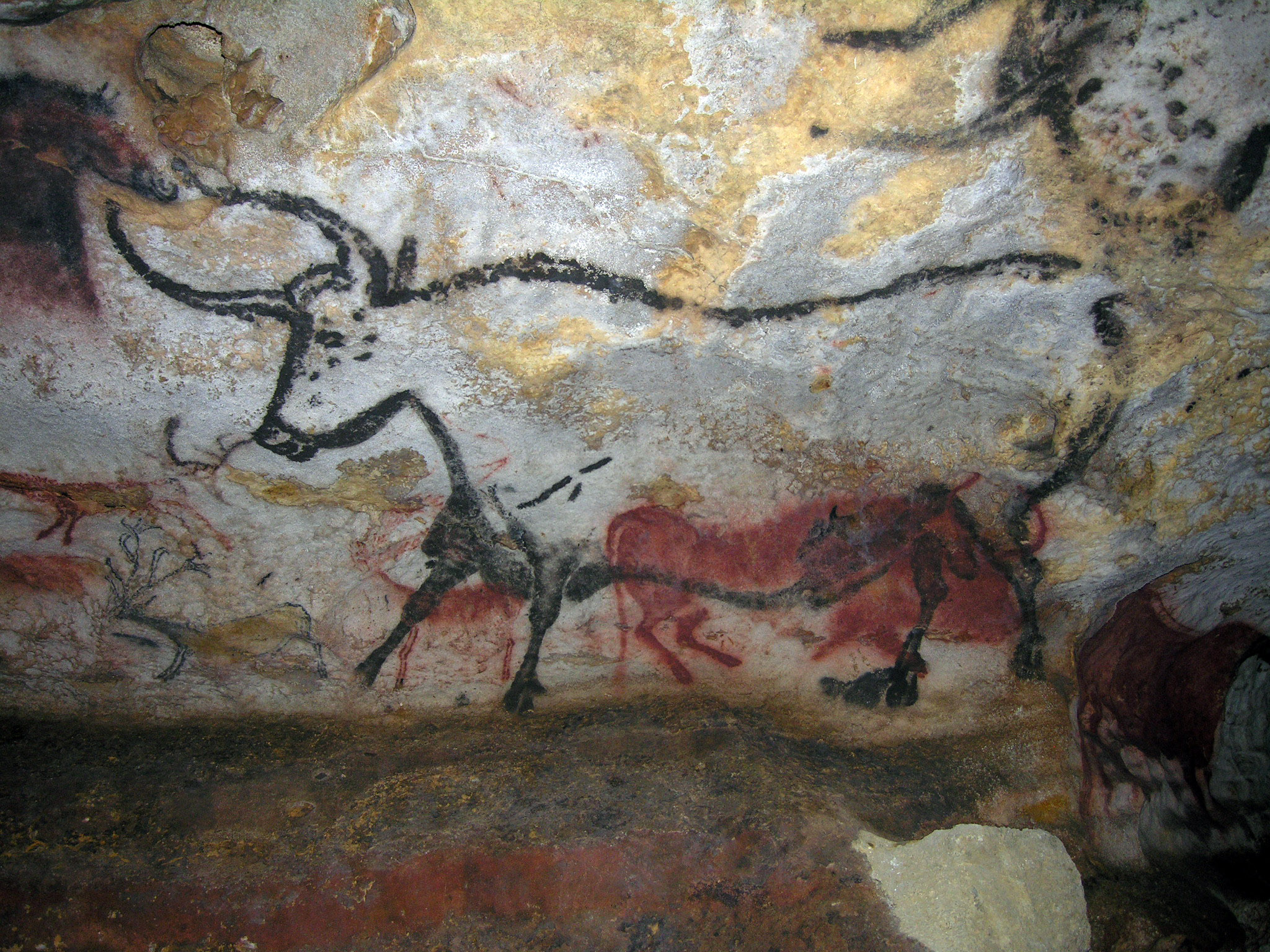
Great Hall of the Bulls, Lascaux France, 15,000-13,000 BCE
Form: Cave, White Calcite, Non-pourus rock, Charcoal, ochre mixed with liquids for paint
Content: loose lines, carvings, twisted perspective, conour of animals, overlapping forms
Context: 350 similar sites, scarce resources, cold climate, unknown number of people who painted, discovered in 1940 by two kids
Function: maybe ritual, images communicate a story, shamanism, hunting magic maybe, they used animal fats to light the cave
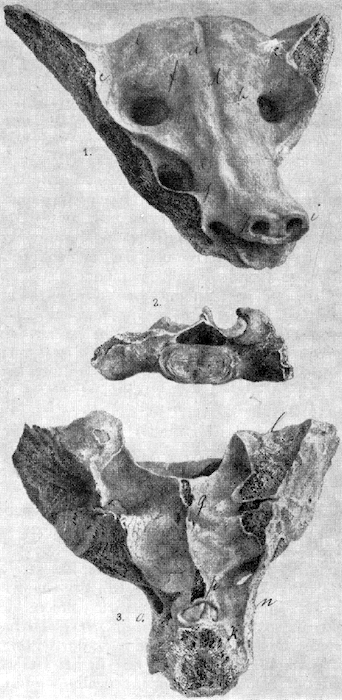
Camelid Sacrum, Tequixquiac Central Mexico, unknown date, maybe 14,000-7,000 BCE
Form: carved bone, sacred bone (near reproductive organs), fossil of a camel or alpaca, 8-10”
Content: Dog faced carved into bone, holes for eyes, nostrils, symmetrical
Context: Discovered by accident in 1870 by an engineer, dont know the date, it was removed from the original site, handmade with a sharp tool, found in modern day mexico city
Function: can’t know
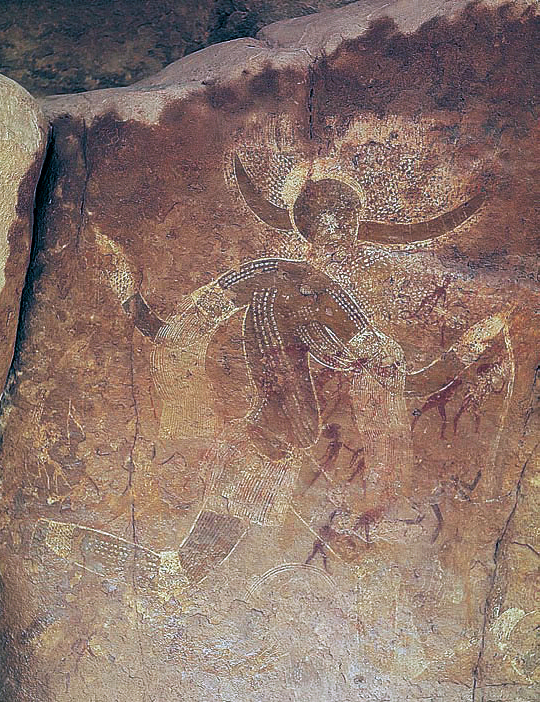
Running horned woman, Tassili n’Ajjer Algeria, 6000-4000 BCE
Form: pigment on rock, caves hollowed out into small shelters
Content: Female running, twisted perspective, silhouette, grain falling from her hands, two horns, body scarification, wearing amulets and garters, people in the background overlap her
Context: found by Lt. Brenans and later studied by Lhote, Tuareg people knew where it was, they even helped the europeans, thought it was inspired by egypt (false), she was special, not something hunter-gatherers would wear
Function: Ritual/ ceremony, place of worship, washing of the rock ruined it
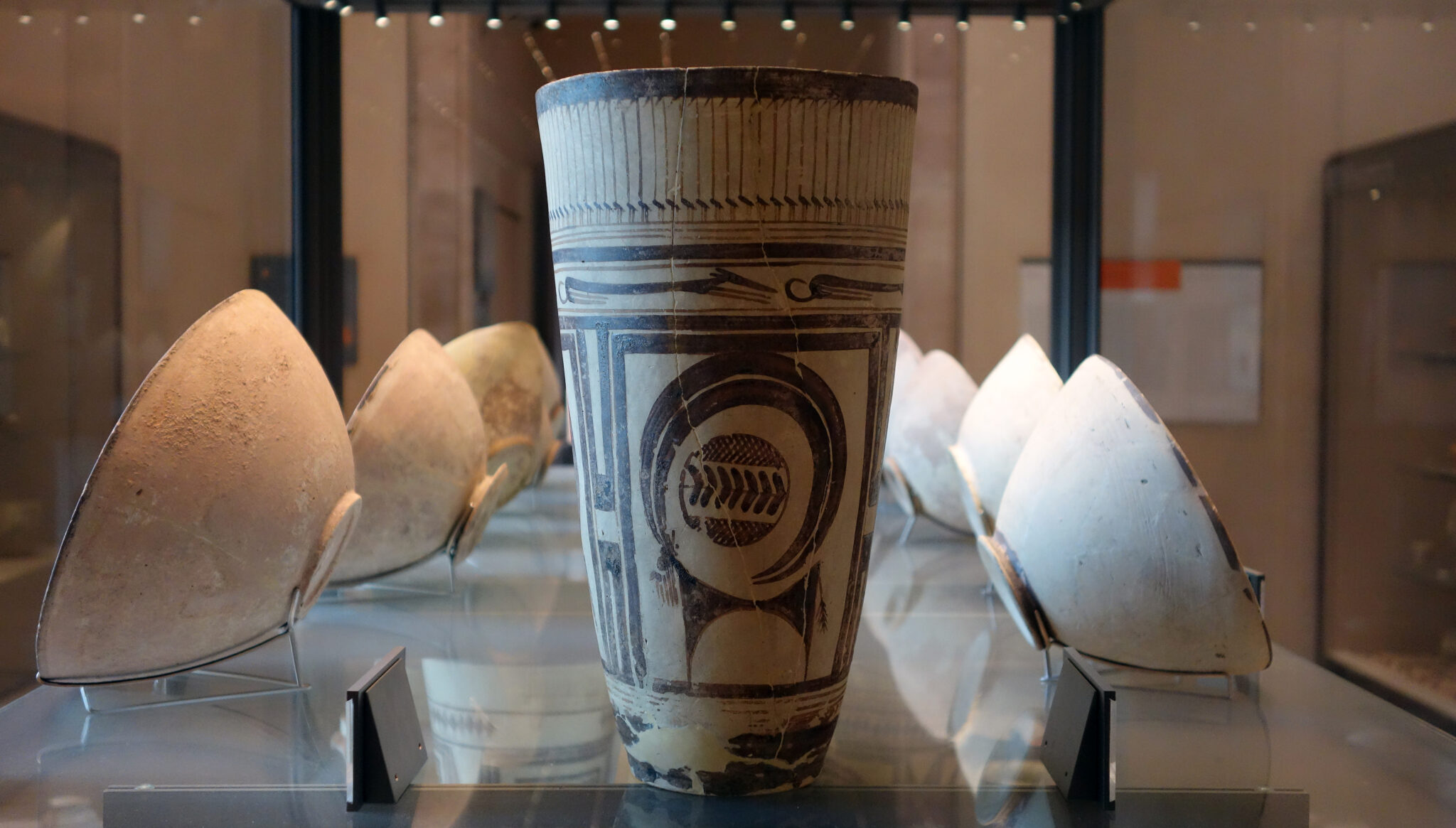
Beaker with ibex motifs, Susa Iran, 4200-3500 BCE
Form: Pottery/ clay, hand built maybe with a slow wheel, hand painted
Content: Mountain Goat, Dogs, Birds, all stylized, geometric elements, bodies wrap around the vessel and go with it
Context: before writing, no record of why they were buried with the dead, these people also built raised mounds with temples
Function: unknown, most likely burial ritual, held decomposed remains sometimes, the animals could be associated with fertility or water
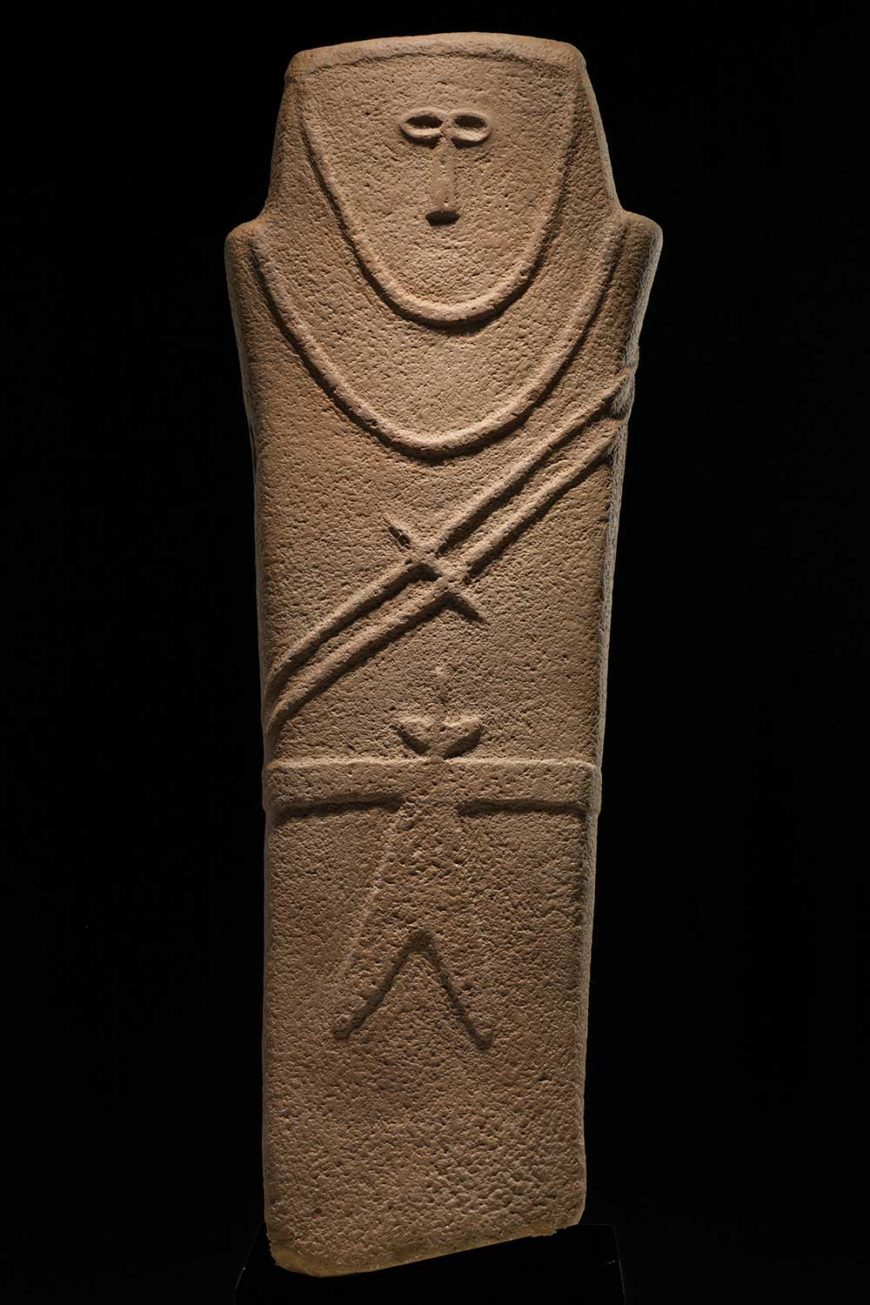
Anthropomorphic Stele, Arabian peninsula, 4,000-3,000 BCE
Form: carved sandstone, a stele is a vertical monument that is inscribed, 3 feet tall
Content: Both sides were carved, closed eyes, flat nose, necklace with two cords with an awl, belt with double bladed dagger, anthropomorphic
Context: one of 3 in the region, neolithic age, caravan trails, hunter gatherers are settling down, pre-islamic arabia had human figures
Function: maybe religious or burial ritual, grave markers, used for dedication or commemoration
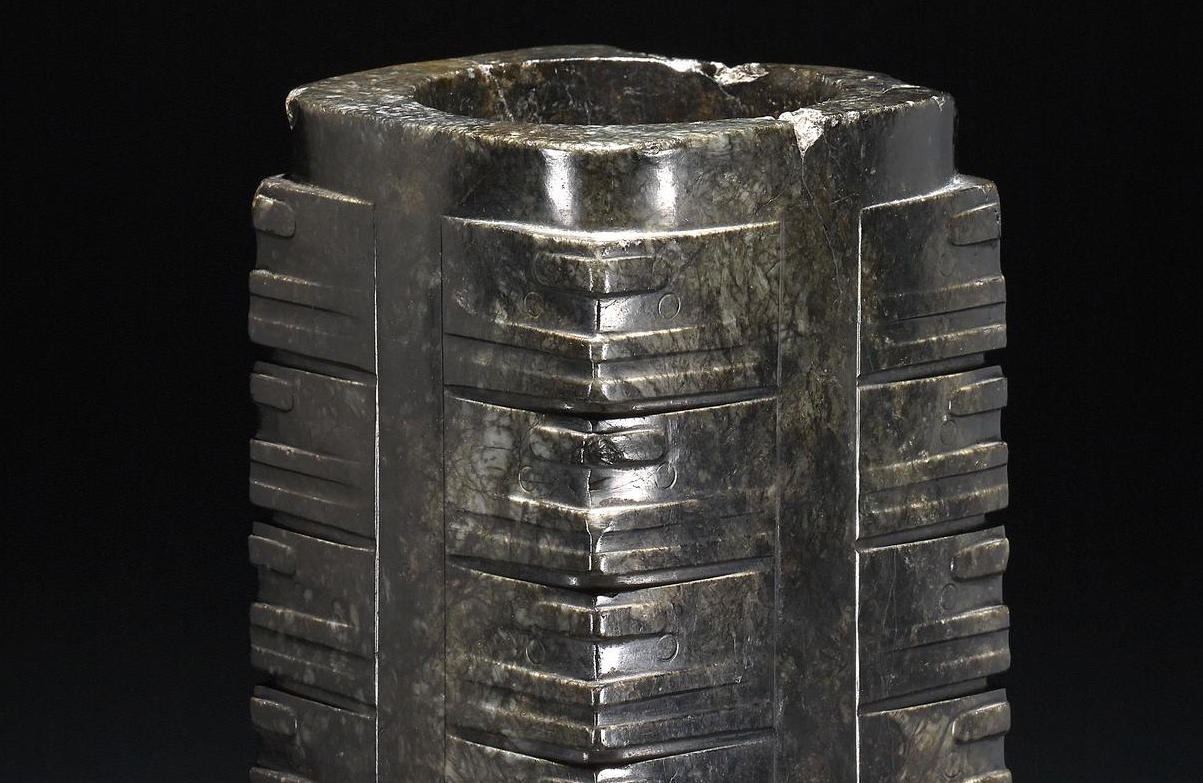
Jade cong, Liangzhu China, 3300-2200 BCE
Form: carved Jade, rectangular, hole in the center
Content: faces, some cong were short and some tall, lines and circles
Context: before writing, settling down, modern shanghai, not focused on food so they focused on art, found in graves of wealthy people, they used sand to carve it
Function: power related, connection to the spiritual world, rectangle = earth circle= heavens or sky

Stonehenge, Wiltshire England, 2,500-1,600 BCE
Form: Bluestone, Trilithons, post and lintel construction, each stone is called a megalith, aubrey holes, sarsen stones in the center
Phase 1: 3100 BCE, circular ditch, 56 aubrey holes, bluestones (2-4 tones), quarry was far away
Phase 2: 100-200 years later, wooden posts, roof, some aubrey holes used as graves
Phase 3: 400-500 years later, remaining beams or stone in aubrey holes removed, circle with 20 sarsen stones inside, topped with 30 lintel stones, each stone was 25 tons
Content: 2nd phase turned it into a burial site, concentric circles, lintel sones carved in a curve
Context: built same time Ancient Egypt was, not sure who built it because it was under cities from the bronze, roman, medieval, and modern age
Function: Solar and lunar calendar, lines up at solstices, sophisticated society and organized leadership
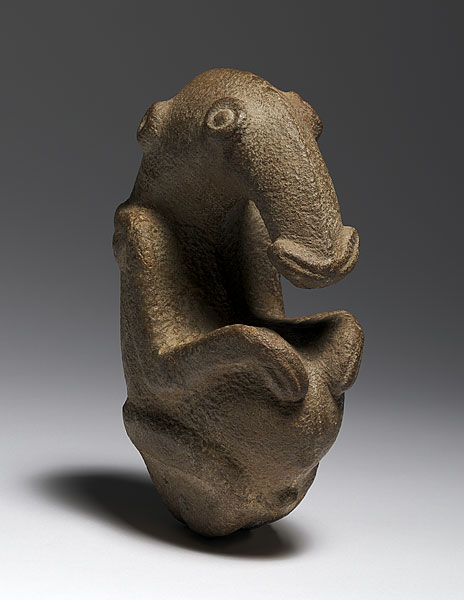
The Ambum stone,Papua New Guinea, c. 1500 BCE
Form: Carved with stone tools, Greywacke stone (slightly shiny), 8” tall
Content: smoothed curved neck, mortar and pestle?, detailed, long nose, could be an echidna or bird
Context: religious use, when first known as the ambum stone it was used by Enga people, they believed in a “big man” system, stone was held to gain power, after those people were converted to christianity the meaning changed, it broke on display in France in 2000
Function: mortar and pestle, burial object
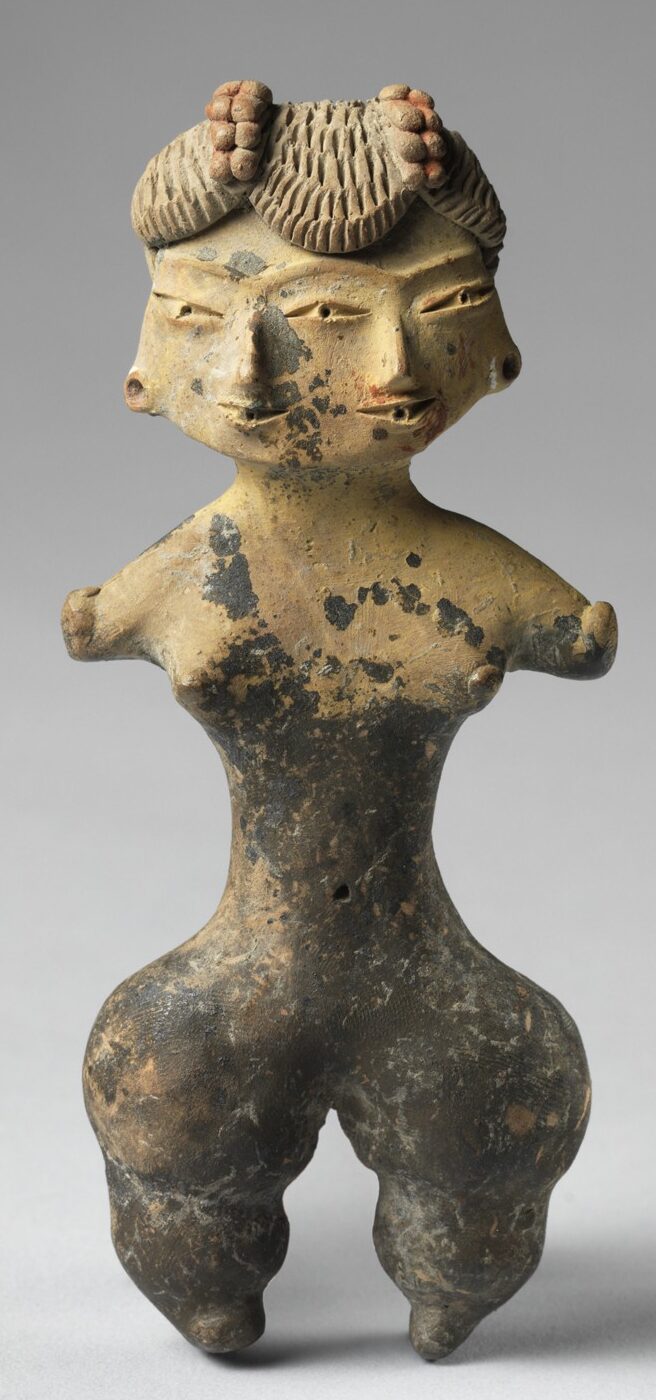
Tlatilco female figurine,Central Mexico, 1200-900 BCE
Form:small ceramic figure, hand molded and carved, 4” tall
Content: female with 2 connected heads, large hips, spherical upper thighs, small waist, no hands or feet, stylized hair
Context: 2000-3000 years before the aztecs, two heads=duality, making of these passed down through family maybe, rarley showed males, graves found by these markers
Function: burial practices, maybe made by full-time artists
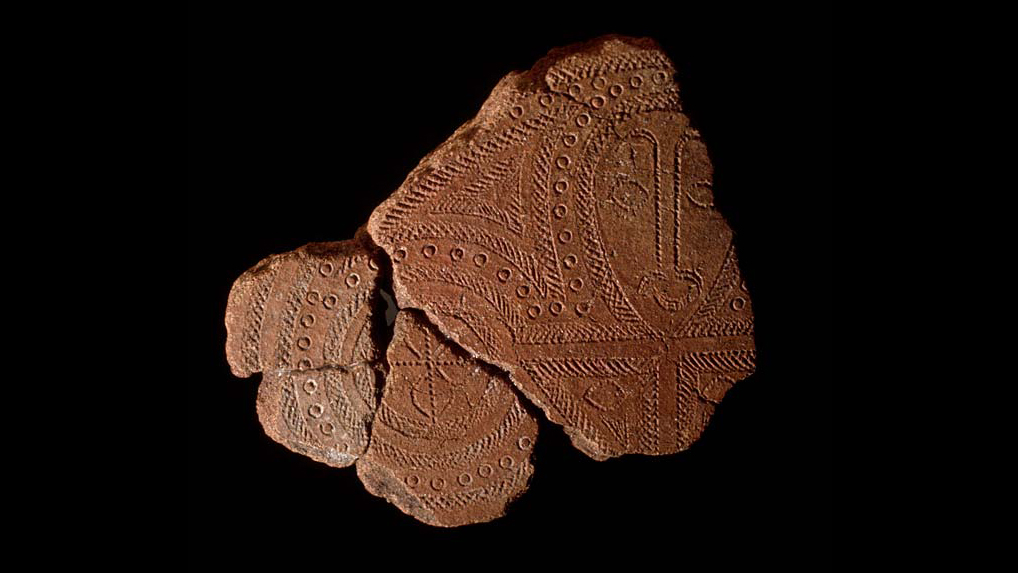
Terra Cotta fragment, Solomon islands, 1000 BCE
Form: terracotta, lime wash from coral, carved with small dentate, pot shards, hand built using paddle and anvil, fired in oped pits, sand added to help with cracking
Content: stamped and incised motifs that have a pattern, followed rules of a design system
Context: Taiwanese people canoed to Bismarck Archipelago and are the Lapita people, Lapita people were sophisticated sea fering, clay was from other places, as people moved through the pacific the designs got less elaborated
Function: not for cooking, used to serve food or storage if they were large enough
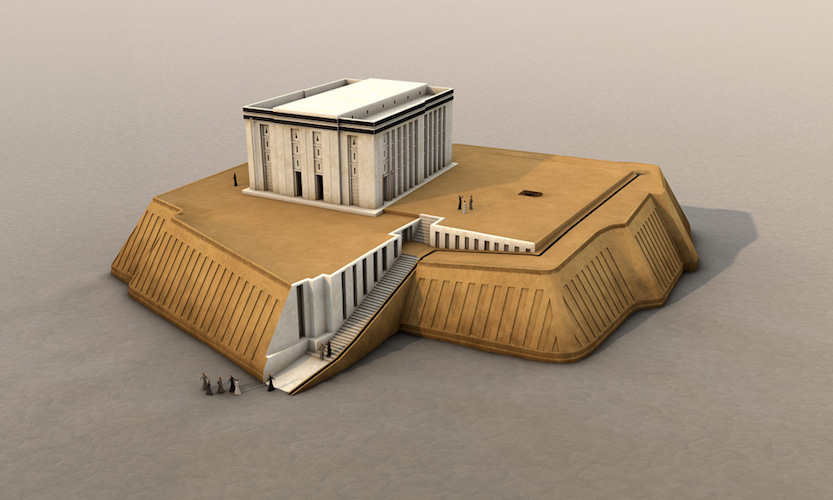
White Temple and it’s ziggurat, Uruk Iraq c. 3500-3000 BCE
Form: Temple was 40ft tall, built on a ziggurat (raised platform), made of mud bricks,built by a lot of people (slaves), white-washed inside and out
Content: white temple: high temple with a tripartite plan, rectangle, oriented on the cardinal points, 19 tablets found inside, bones of a leopard and lion, huge pits for fire
Ziggurat: raised platform with 4 sloping sides, pattern around the base, steep stairway to a ramp
Context: 1st writing emerged here, temple was dedicated to the sky god, focal point of city, place of political system (theocracy), believed that the gods came from the mountains, believed ziggurats were to imitate the mountains for the gods
Function: religious and government building, bridge between earth and the heavens, only for priests or high officials, worship
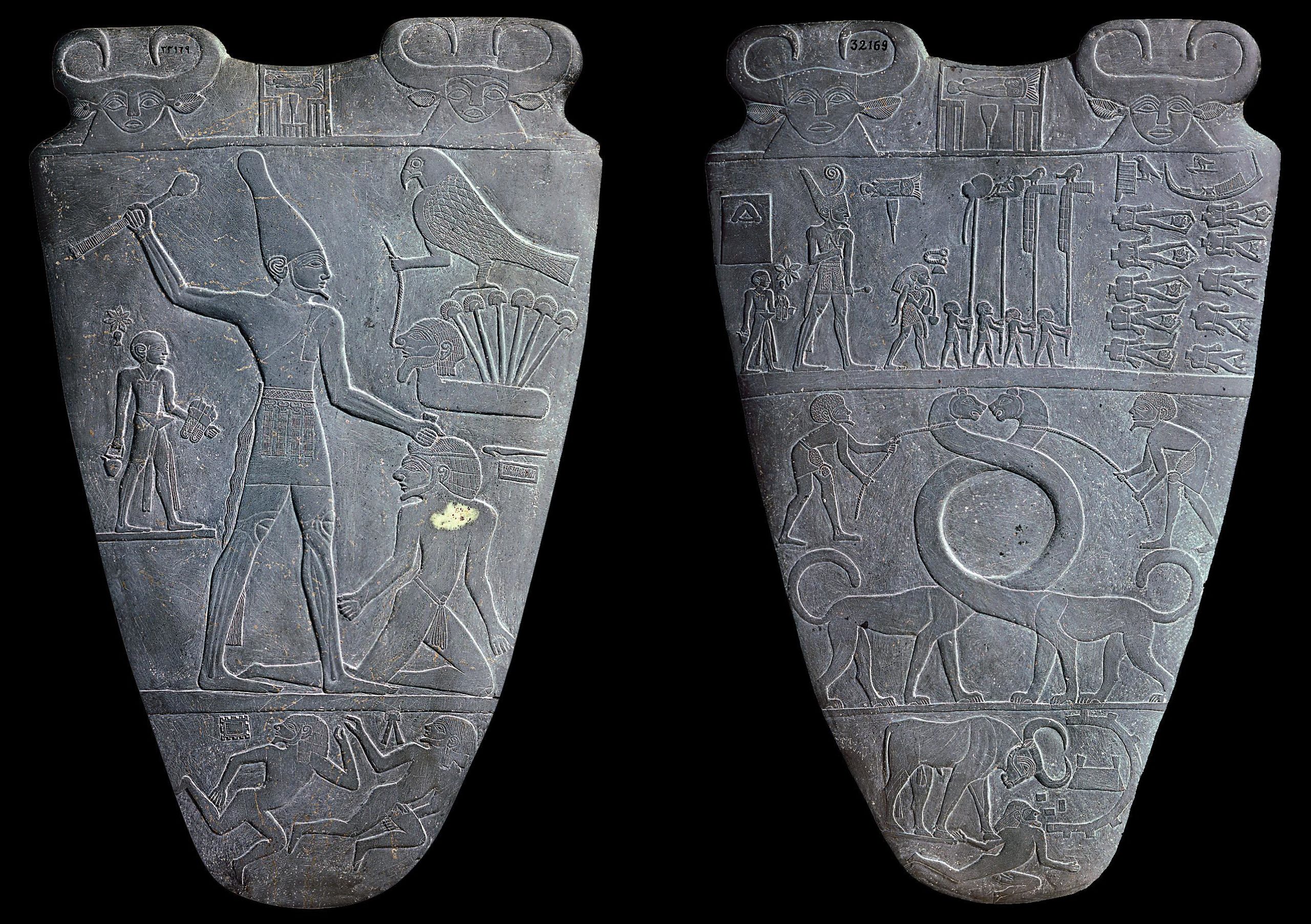
Palette of King Narmer, Predynastic Egypt 3000-2920 BCE
Form:2 feet tall, carved stone in low relief, greyish green siltstone
Content: shows King Narmer in a series of scenes, Iconographic characters, figures represent the canon, registers, hierarchical scale, serpopards (weird looking leopards), many figures that all represent someone and tell a story, wearing upper and lower Egypt crowns
Context: Egypt 3000-2920 BCE, it has never left egypt, discovered by Quibell and Green in 1898, ritually buried objects were donated to the temple, they buried some when there was no room, maybe means unification of upper and lower egypt, maybe to balance order and chaos, maybe purely ceremonial
Function: used for grinding and mixing minerals for cosmetics, ritual object dedicated to the gods
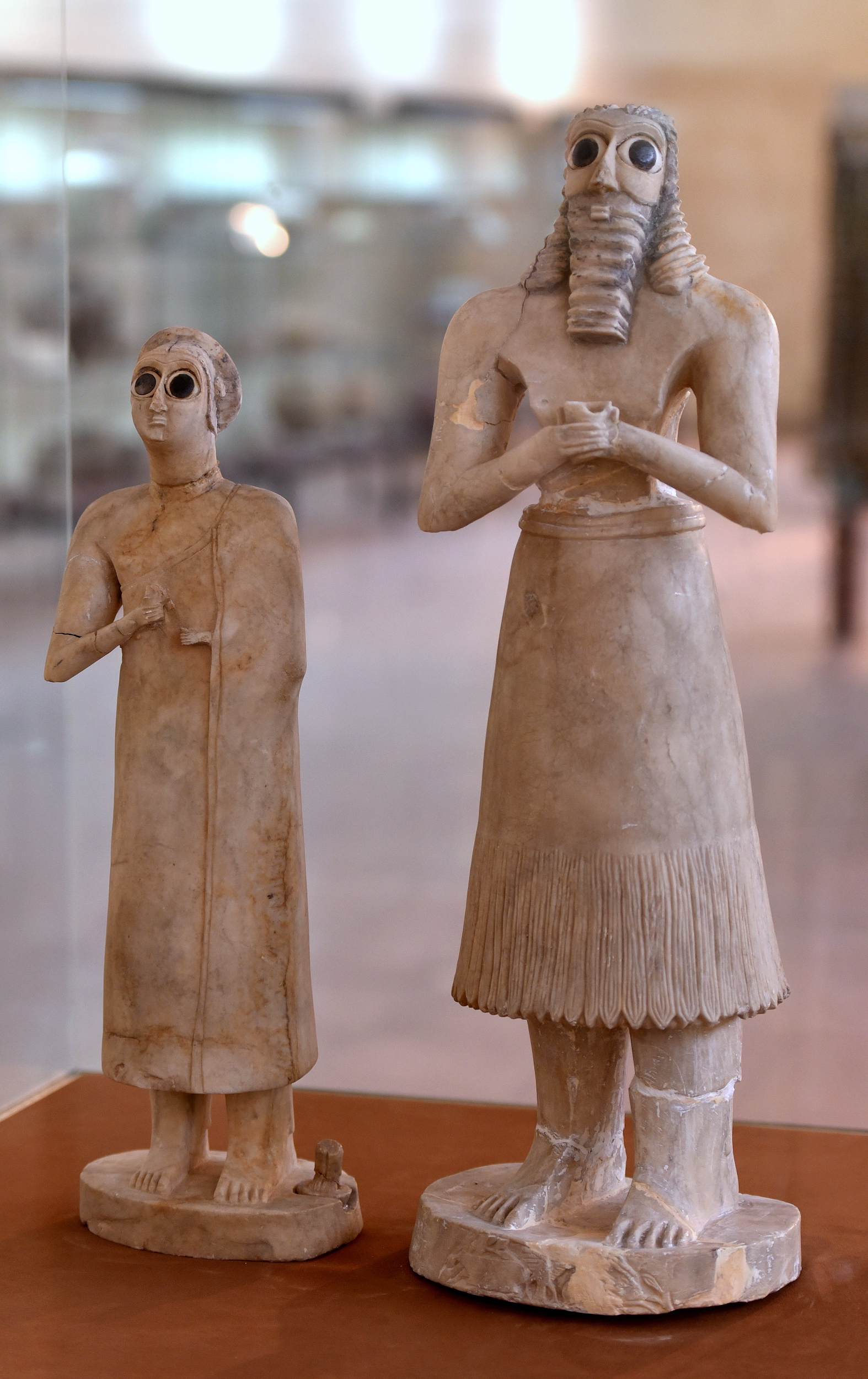
Statues of votive figures, Sumerian c.2700 BCE
Form: alabaster body, shells for eyes, black limestone for pupils, carved, 1-3 ft tall
Content: figures are not realistic, sculpture of elite sumerian, cylindrical base, flattened torso, hands clasped in prayer, wide eyes, more geometric
Context: found with other figures, buried near mesopotamia, great expansion of early sumerian art, deities literally inhabited their cult statues, in the temple of Abu, some were holding cups, some inscribed
Function: To be a stand in for worship, to embody a God
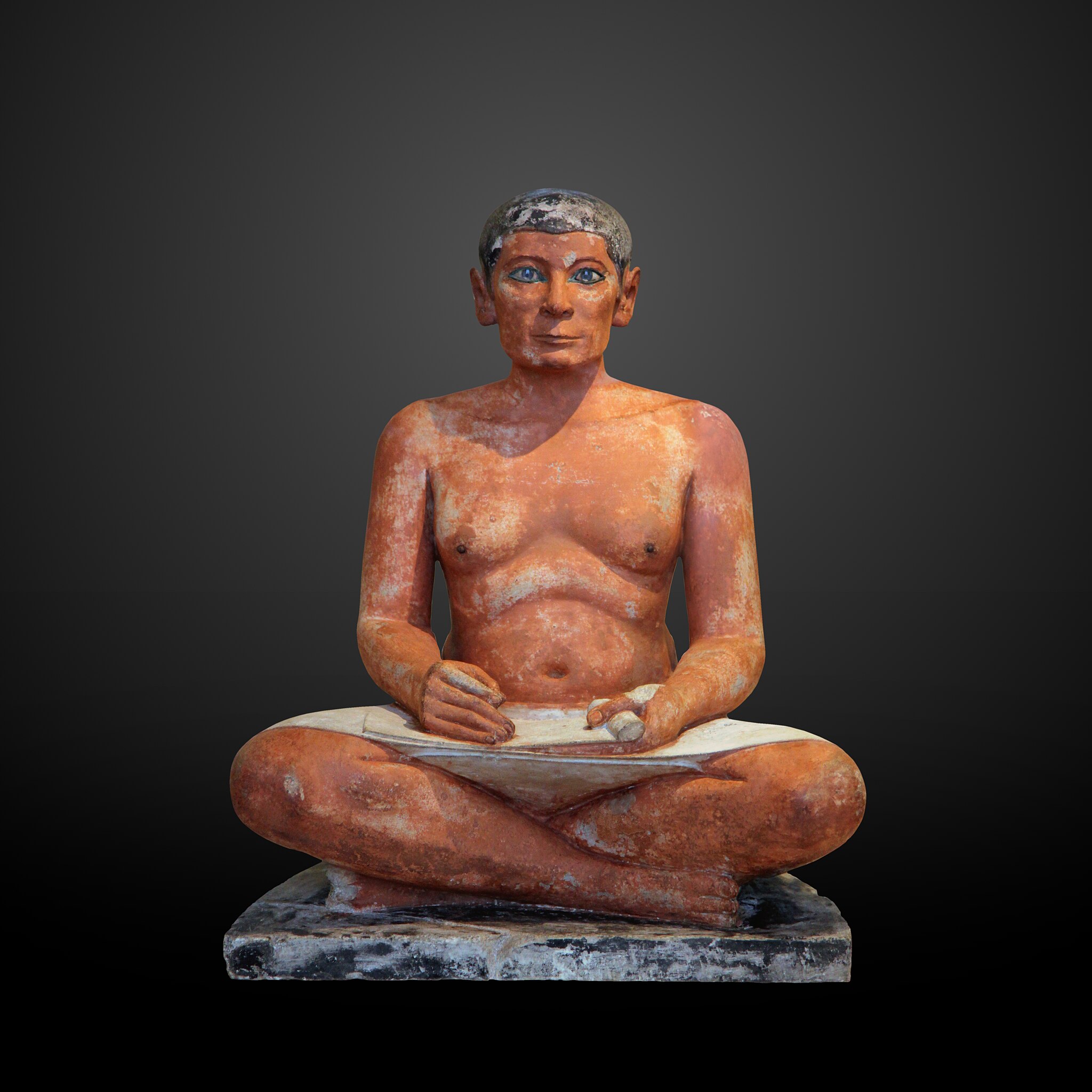
Seated Scribe, Egypt c. 2620-2500 BCE, Old Kingdom
Form: carved and painted limestone, nipples are wooden dowels, eyes are crystals
Content: realistic man, unique that he is seated (why hes a scribe), unique in its features, not idealized, would be holding a reed pen
Context: amount of pigment that remains if odd, found in necropolis, uncertain of its exact spot, funerary sculpture, would have a stone with persons name, could be a portrait, scribes were highly regarded
Function: tomb sculpture, commemorate, help scribe ascend to the afterlife
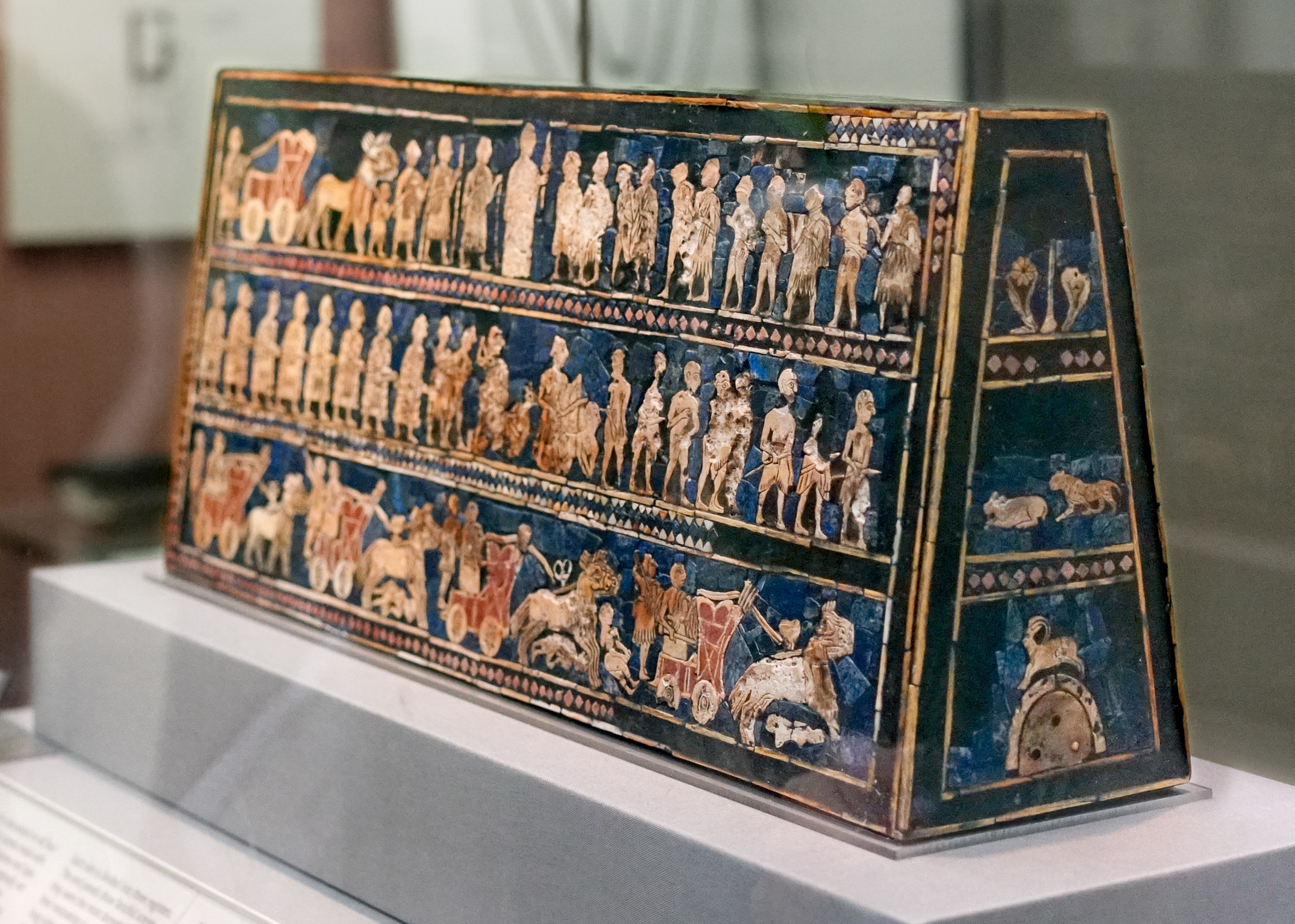
Standard of Ur, Ur c. 2600-2400 BCE
Form: Mosaic tiles from shells (persia), red limestone (india), blue lapis ( afganistan), small, could be carried, found broken
Content: two sides (war and peace), story telling over time, War: sumarian army, chariots, people being trampled, horses in slow progression, ready for battle, king’s head breaks border, prisoners naked
Peace: most important figures at the top, twisted perspective, animals being taken for sacrifice, some celebration
Context: Ur (capital of an empire), found in one of the largest graves in a royal cemetery by Wooley, allows us to see the aspects of their life, elaborate ceremonies, TRADE
Function: standard carried on a pole, war ensign, military flag, not certain of the use, could have been a sound box
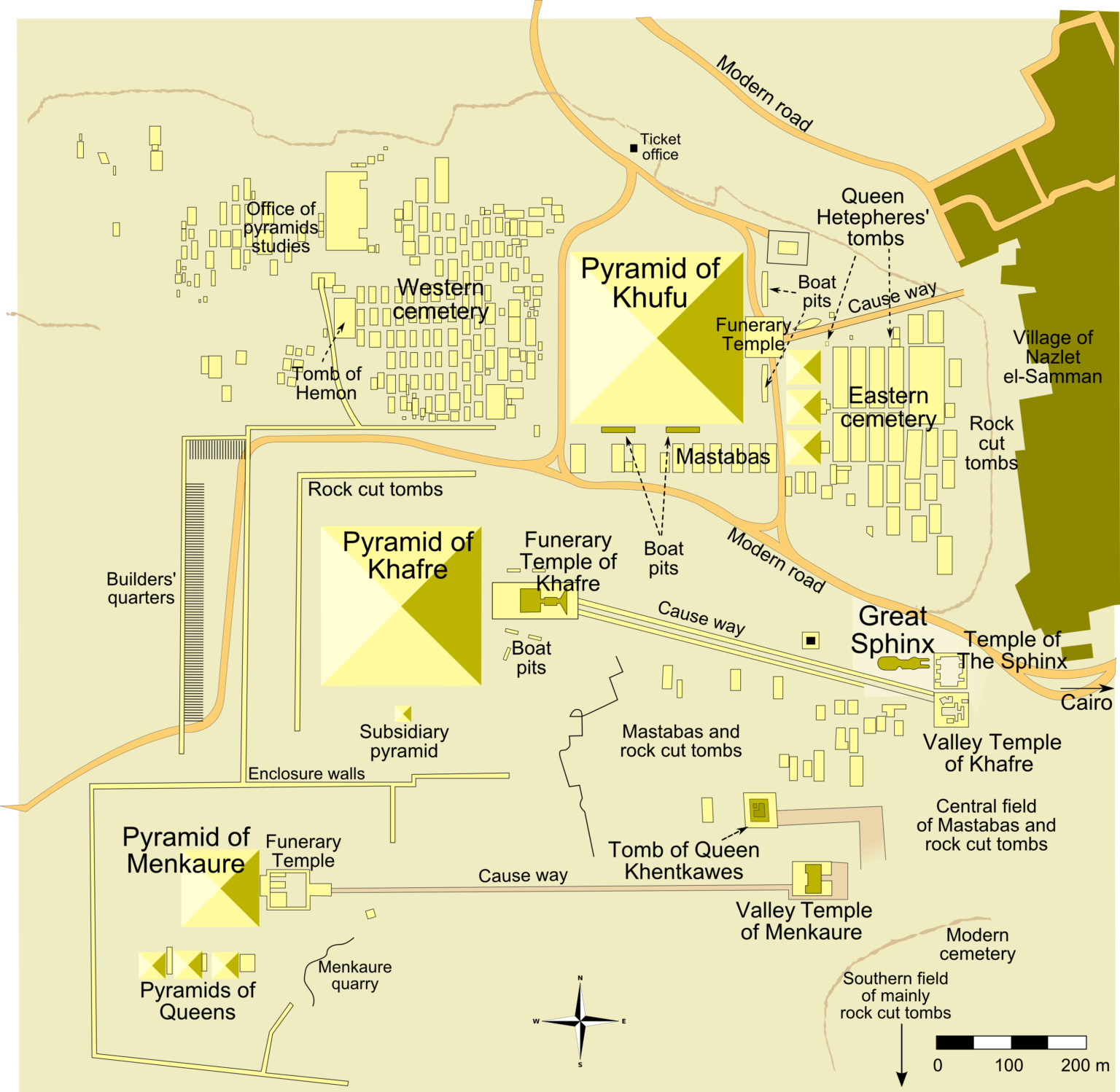
Great Pyramids, Egypt c. 2550-2490 BCE, Old Kingdom
Form: carved and quarried stone, inner corestone (what we see), outer casting blocks, gypsum plaster bright white, aligned to cardinal points, Pyramid (capstone gilt), Sphinx (bedrock from giza), large construction, paths lubricated with silt to carry
Content: 3 primary pyramids over 3 generations, each with royal mortuary complex, smaller pyramids for queens, mastabas smaller tombs for members of courts, smaller passageways that lead to King’s cambers
Context: egyptians buried dead on the west side of the nile, believed in an afterlife where the soul went to live again, mummified bodies in tombs, vital organs in jars, first made the mastabas then smaller pyramids then great ones, kings=sons of ra, stepping stone into afterlife
Khufu: great pyramid, 481 feet tall 750 ft wide, red granite in the kings camber, 7 large boat pits
Khafre: bulit by khufus son, slightly smaller, funerary temple
Sphinx: lion with head of king, guard
Menkaure: smallest, well preserved objects in tomb, granite sarcophagus lost at sea
Function: burial site for kings, royal mortuary complex, social structure, reflects solar cycle, most tombs were raided
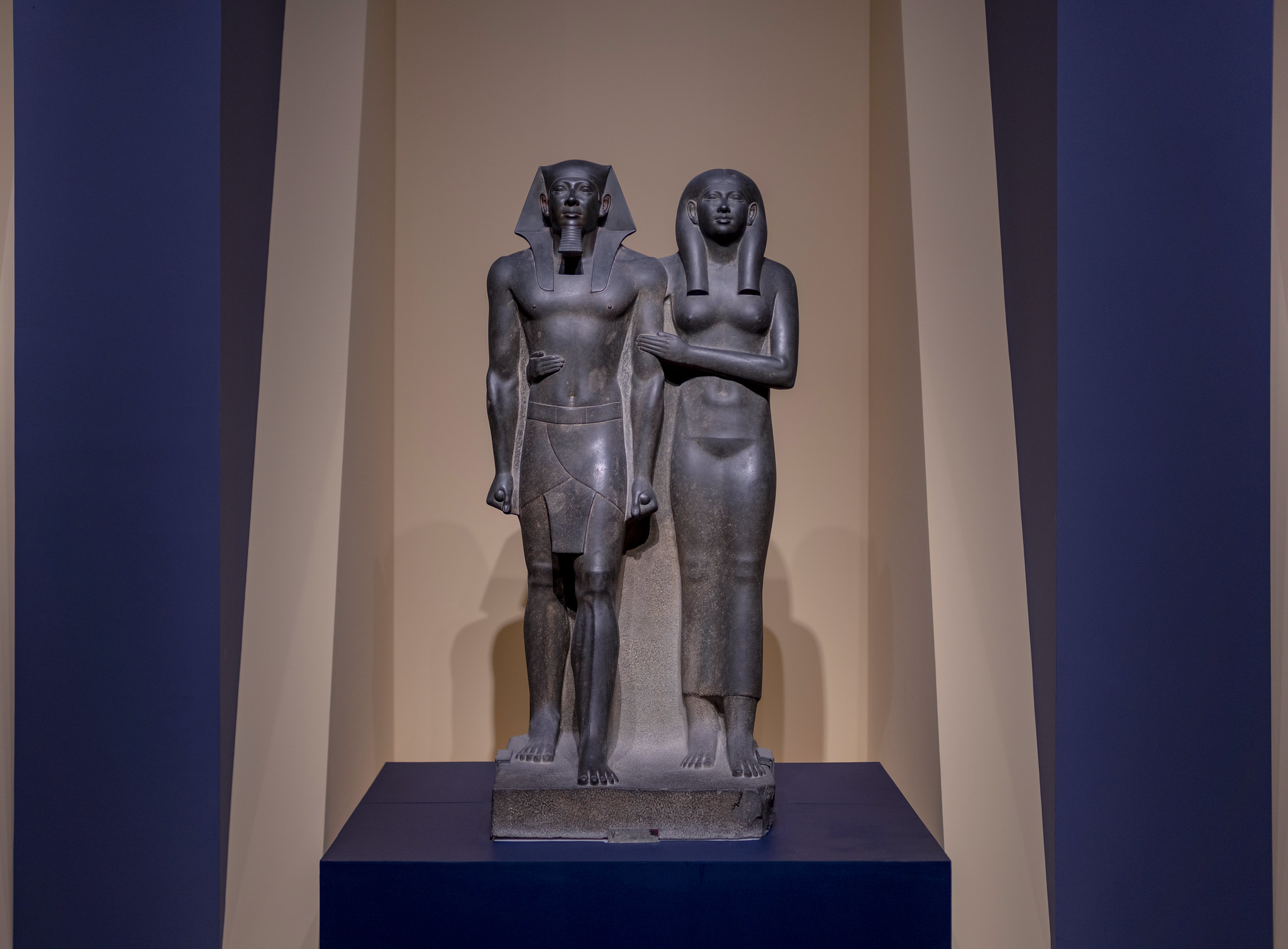
King Menkaura and queen, Egypt 2490-2472 BCE, Old Kingdom
Form: carved greywacke, nearly life sized, never finished, would have been brightly painted, covered with precious metals, technically a relief sculpture
Content: two figures side by side, pleaded kilt on the king, nemes headdress, royal beard,clenched fists, no sign of age, female counter part, both have left foot forward (unusual for woman)
Context: found and excavated by Reisner in 1970, located in the mostly untouched Valley Temple, royal female: equal in hight, maybe queen or mother, no word for queen
Function: ensure rebirth in the afterlife, divine importance of the ruler
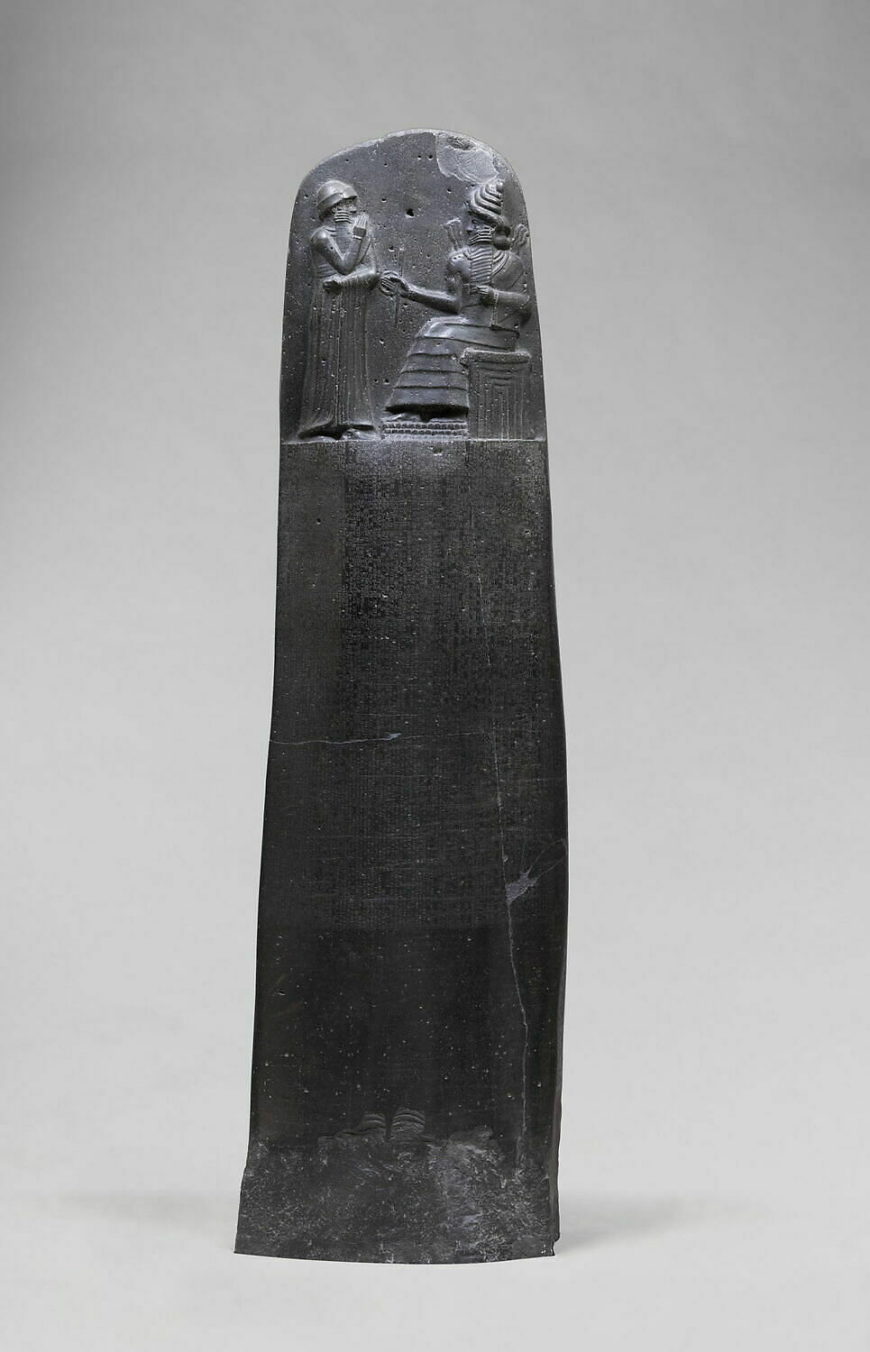
The Code of Hammurabi, Babylon c. 1792-1750 BCE
Form: basalt stone, stele, relief sculpture, cuneiform, 7.4 ft tall
Content: two figures at top, one standing one sitting, twisted perspective, scepter and ring signs of power, cuneiform at the bottom (300 laws and an epilogue)
Context: Hammurabi of babylon, most far reaching leader, shamash, sun god at the top, shows hammurabi receiving laws from shamash, language is Akkadian, first laws, legal precedents, “eye for an eye” shows the advanced society
Function: shows laws and punishments that will be enforced, tells us about Babylonian culture and what important to them
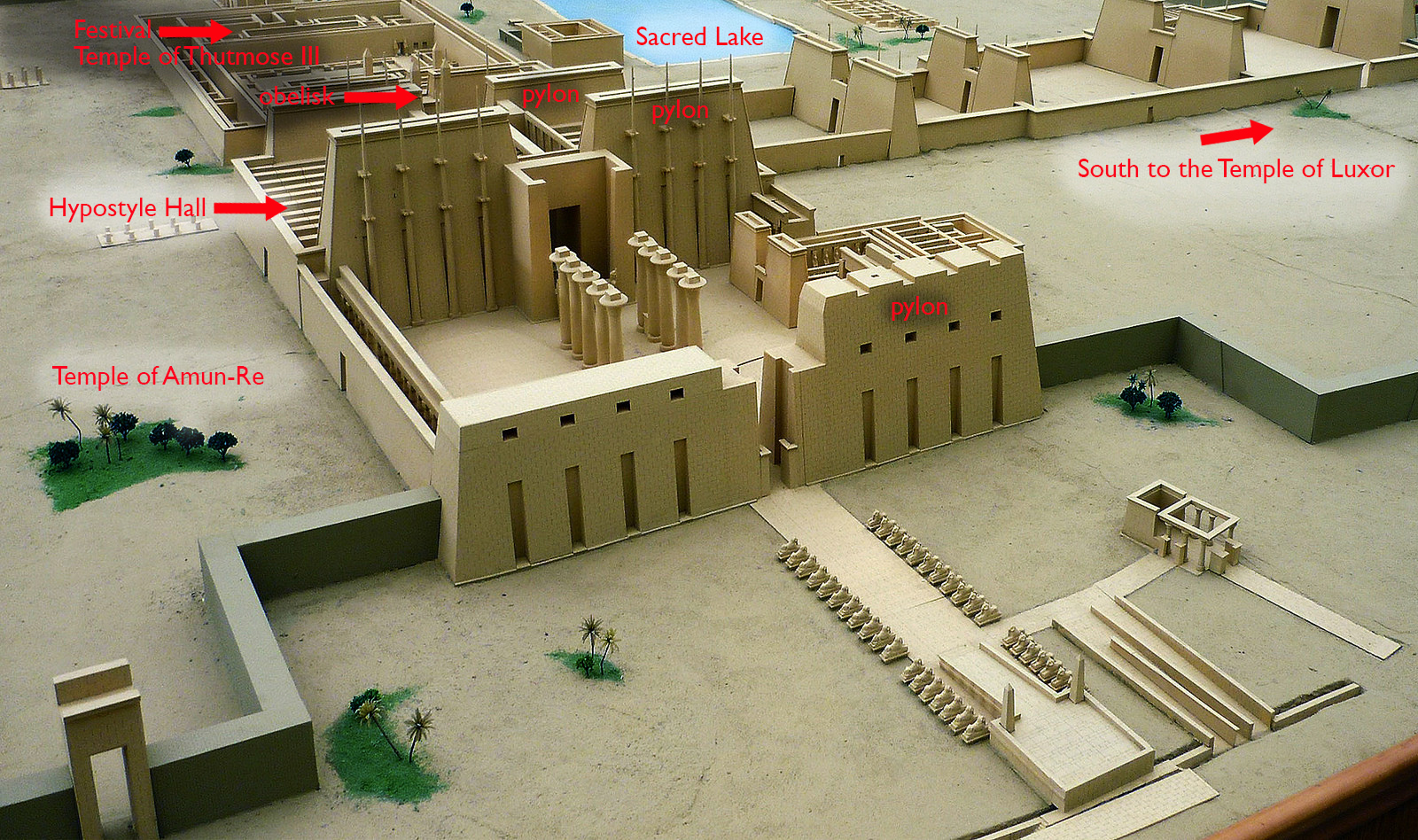
Temple of Amun-Re and Hypostyle Hall, Egypt c. 1550 BCE and 1250 BCE, New Kingdom
Form: large temple complex built over time, sandstone and mud brick, Hypostyle Hall had a roof with columns, brightly painted, decorated and painted to represent mound creation
Content: temple compound with 20 temples and churches, twas the estate to the priests, contained the tallest obelisk in Egypt, the obelisk was commissioned by Hatshepsut and was one piece, temple had pylons, roof, and columns
Context: 1st built in middle kingdom, “most select of places”, precinct of the gods Amun-Re (amun and re), Mut(goddess of motherhood and earth), and Montu (war, head of falcon or bull), temples in egypt connected to the creation of the world, hypostyle hall: not many people had access, more restrictions the further you went, clerestory lighting
Function: place of worship to the Gods, viewed as a place for Amun to dwell on earth
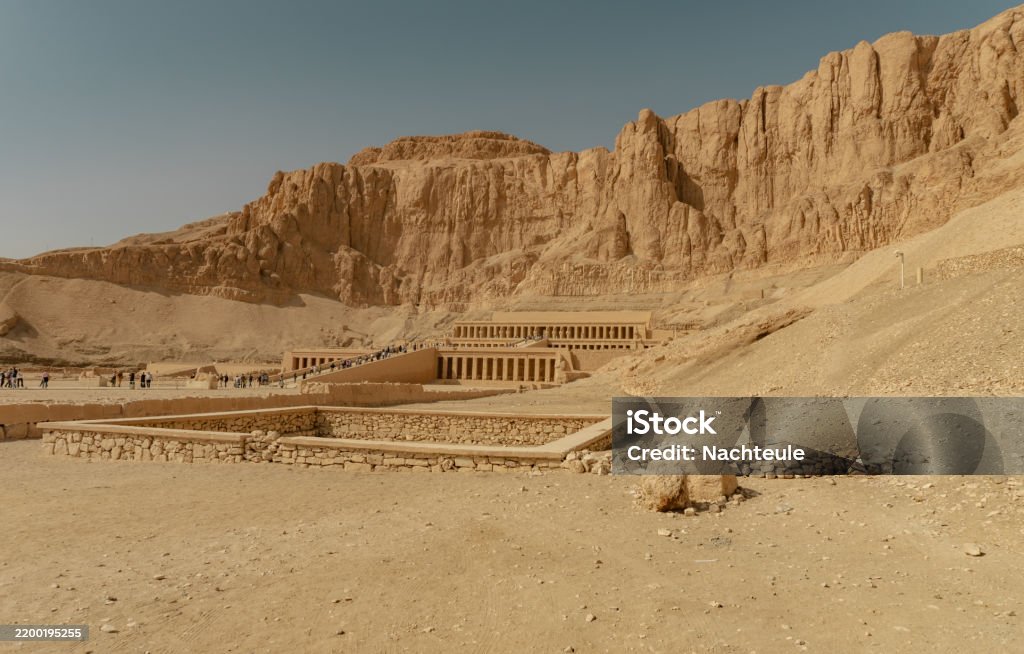
Mortuary Temple of Hatshepsut, Luxor Egypt c. 1473-1458, New Kingdom
Form: temple cut from cliffside with three terraces, kneeling statue, carved granite 8.6 ft tall
Content: Statue: kneeling, holding 2 jars, dressed like a king, made for a temple, 6-10 total, Temple: partially carved from cliffside, colonnaded terrace, long ramp, aligned with winter solstice, contains statues including sphinx, reliefs, and paintings
Context: Hatshepsut: female pharaoh, created mythology about her kingship, daughter of thutmose I, co-pharoh to Thutmose III, believed art could convey royal authority, cliffside built gives sense of permanence, hieroglyphics as female but looks male, two jars offerings to gods, kneeling makes her human but eternal, Thutmose III later usurped her and destroyed structures and such of her, buried in the Valley of the Kings
Function: mortuary shrine, shows piety and power
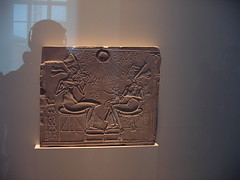
Akhenaten, Nefertiti, and three daughters, Egypt c. 1353-1335 BCE, New Kingdom
Form: small limestone plaque, carved sunken relief, 13" by 15"
Content: Akhenaten, wife Nefertiti, 3 weird looking daughters, representation of Aten in center, seated on thrones, sun rays, Ankhs (symbol for life), something is physically wrong, softer lines
Context: Akhenaten changes egypts religion otherwise was unchanged for 3000 years, from Amun to Aten, he changes him name, moves the capital, after he dies the religion goes back, they are informal in appearance, love and domesticity, represents their relationship to god, Akhenaten was a monotheist, both ruled upper and lower egypt
Function: would have been on someone home alter, a way to encourage new religion

Tutankhamun’s tomb, Egypt c. 1323 BCE, New Kingdom
Form: 3 total coffins and an outer sarcophagus, 2 coffins made of wood and covered in gold, stones, and gems, innermost coffin solid gold, when it was discovered it had black oil on it, death mask in innermost coffin (2 sheets of gold)
Content: Image of pharaoh as god like, crook and flail = kings right to rule, vulture and cobra protect, beard=god, death mask, includes an inscription from the book of the dead that tells of a road map to the afterlife and has spells to protect
Context: found in the valley of the kings, found in 1922 by carter nearly intact, son of Akhenaten, King Tut ruled at 9 and died at 18, changed religon back, no heir, site was excavated for years, carter spent a decade recording findings
Function: Funerary, protection, ensure transition to afterlife
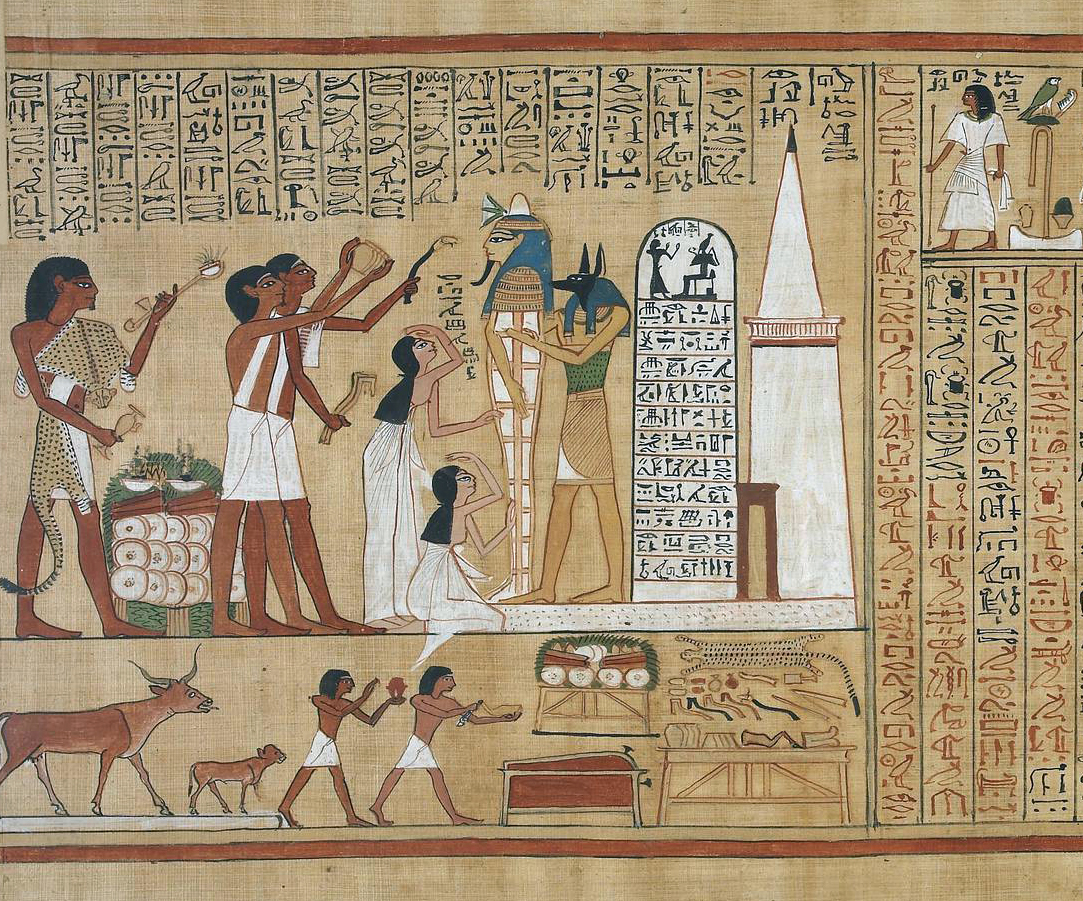
Last judgment of Hunefer, Egypt c. 1275 BCE, New Kingdom
Form: papyrus scroll, part of the scribes book of the dead, painted, 35" x 16"
Content: Hierarchical scale, composite view, continuous narrative, sylizations, upper left Hunefer is saying how good he is, Hunefer wears a white robe, lead by Anubis, Thoth says that Hunifer lead a good life, Horus leads him to Osiris, white platform (salt)
Context: papyrus was the most important surface in middle ages, Hunefer was a royal scribe, maybe buried at Memphis, created for prominent people, he passes the test, “opening of the mouth” so he could eat, breath, etc
Function: to prove Hunefer lived a good life, deserved the afterlife, help lead the Ka into afterlife
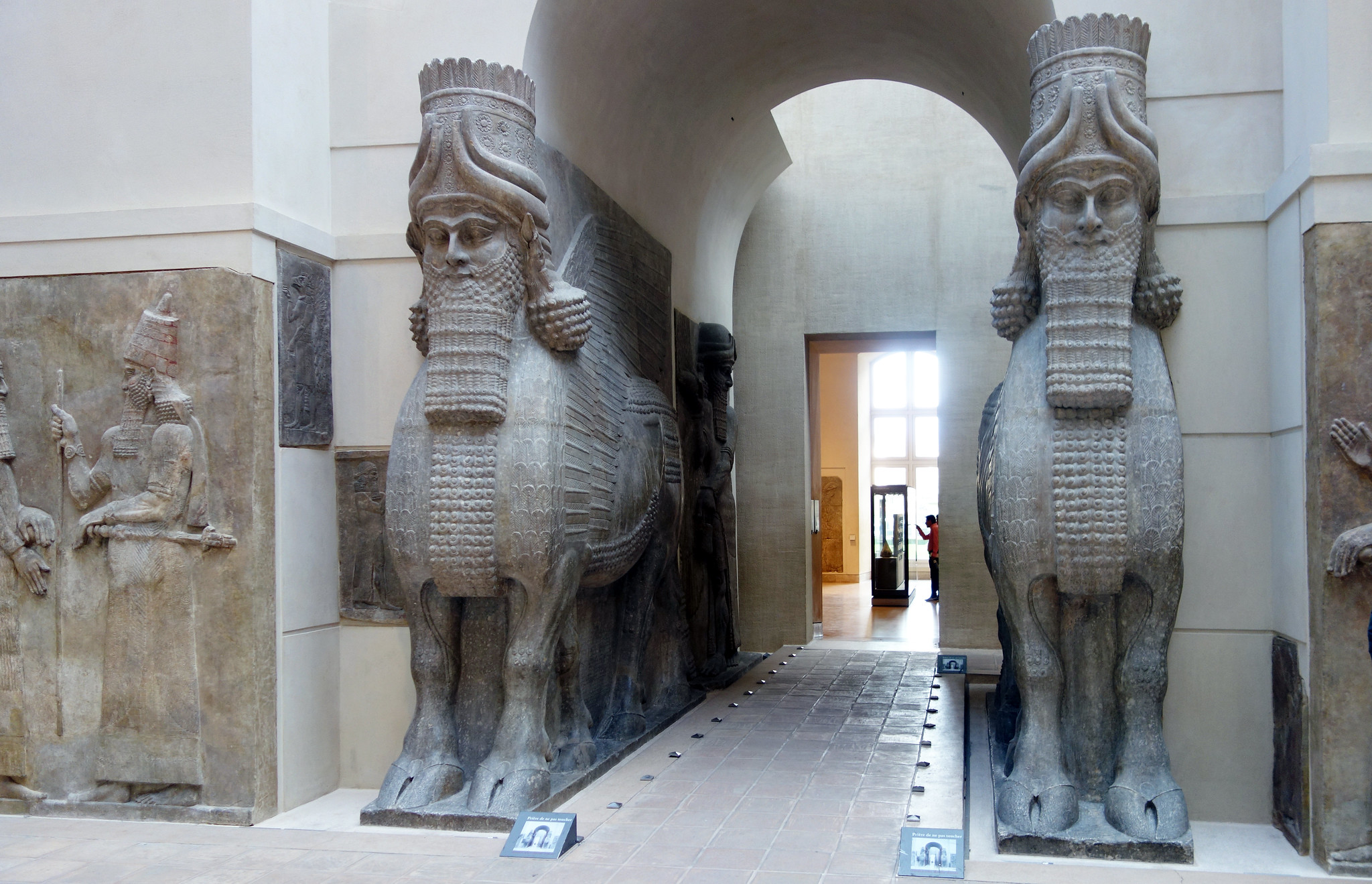
Lamassu from the citadel of Sargon II, Iraq c. 720-705 BCE
Form: carved stone, alabaster, high relief, one piece of stone, 13.9 feet tall
Content: Lamassu (guardian figure), winged bulls with man head, some were a part of structural support, crown, decorated with rosettes, horn, ring of feathers, curly hair, elaborate earrings, wings highly decorated, inscriptions to say how good the king was and curse people who threaten the king
Context: placed at gates, hight of assyria civ., from palace of Sargon II, protected the gates, small in comparison to the architecture, shows movement, Lamassu important to marking territory, more than 100 Lamassu, hybrid monsters, head of mane, crown of god, body of lion, would’ve had color
Function: spirited guardian, symbol of kings power, protected the gates of the citadel
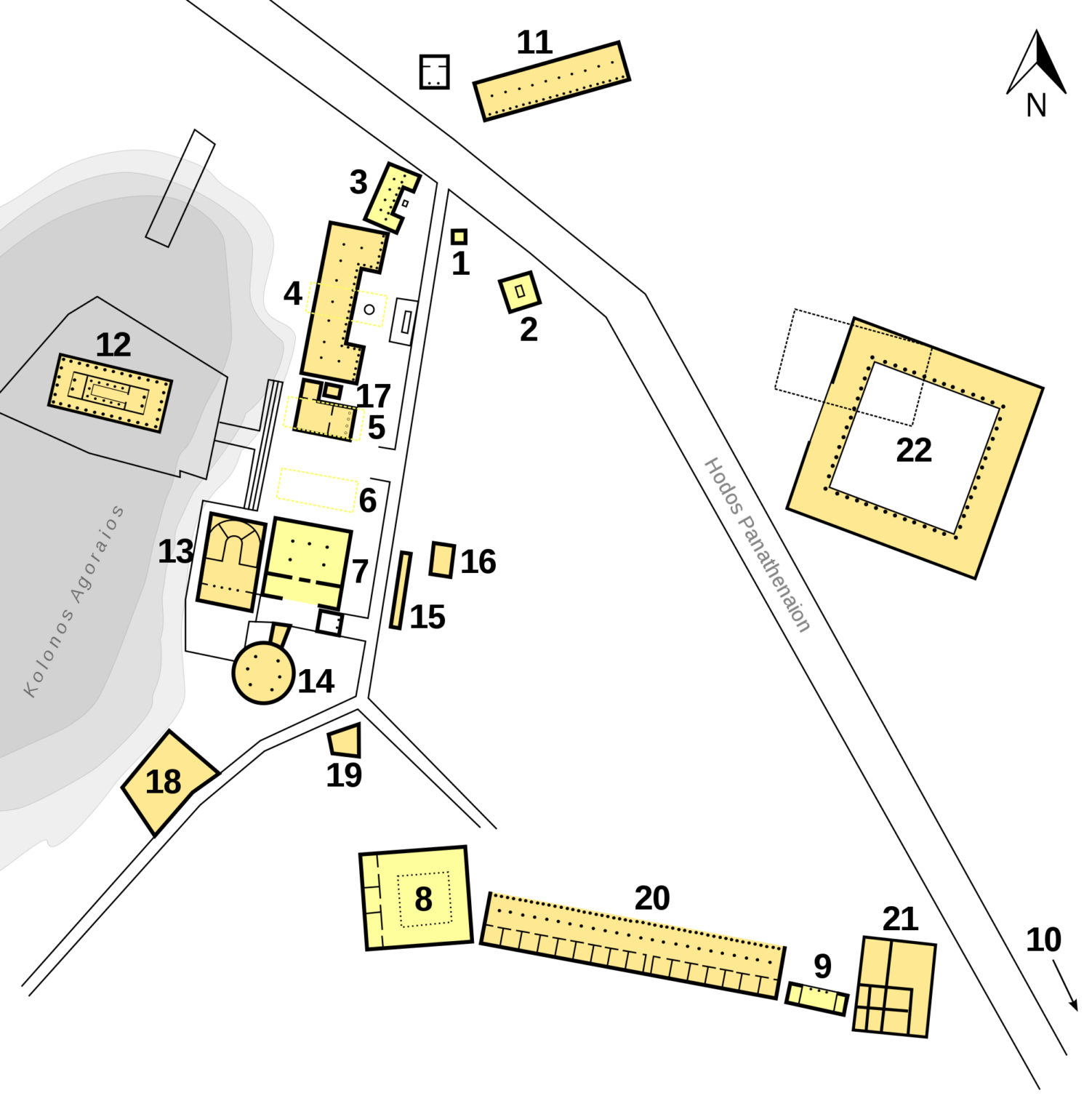
Athenian agora, Archaic through Hellenistic Greek, c.600 BCE- 150 CE
Form: marble structures
Content: started as a market place (agora) then turned into a place of government, Temple to Hephaestus, Stoa- covered walkway
Context: once a year a great processional occured(agora to parthenon), heart of Athenian experiments in democracy, the agora provided the richest source for understanding ancient Greece, there was a library and concert hall, small shrines and temples received regular worship
Function: location of most important buildings in Athens, economic center, democratic center, meeting place
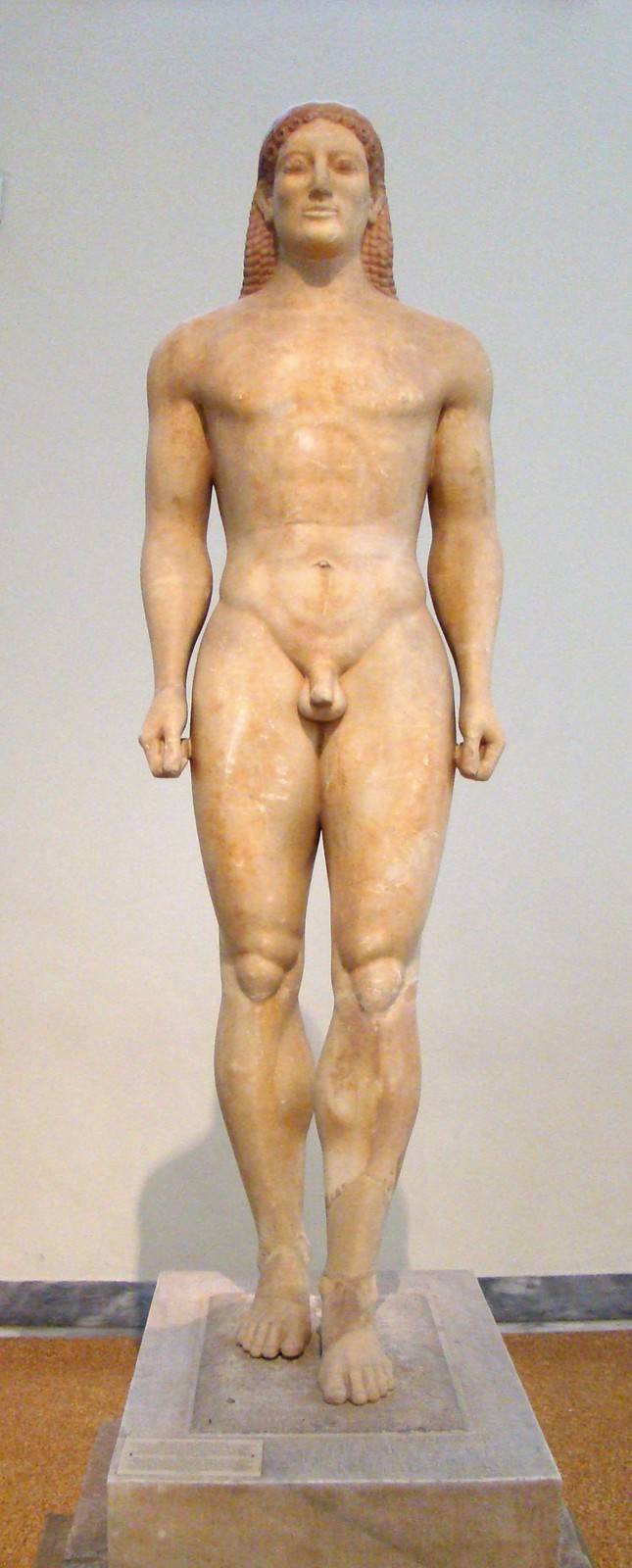
Anavysos Kouros, Archaic Greek, c. 530 BCE
Form: life size, 6ft 4in, carved marble, sculpture, painted
Content: young male, traces of paint, more natural compared to first Kouros, archaic smile, represents the ideal form, rigid, braided hair, one food forward
Context: not a portrait, Archaic Period- artistic development in Greece in 650-480 BCE, Kouros= youth, inspired by ancient Egypt, Kroisos (name of man) died in battle, found in 1936 in Anavysos cemetery, thousands produced, Persian Wars during this time, elaborate hairstyle shows wealth, found by robbers who then cut it into pieces to smuggle
Function: Grave marker, some represented gods, offerings in sanctuaries, symbolize nobility and strength
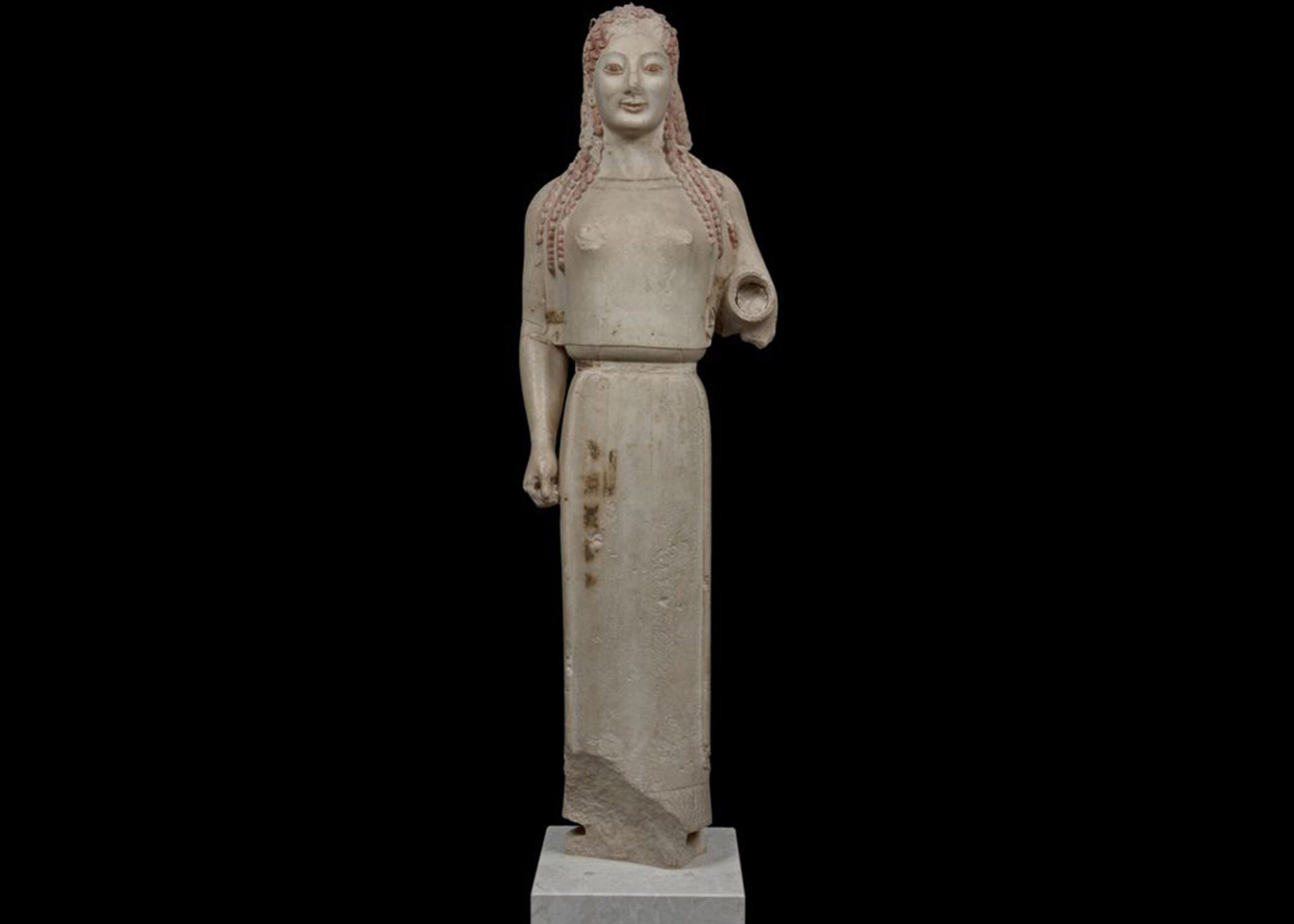
Peplos Kore from the Acropolis, Archaic Greek, c. 530 BCE
Form: carved marble, painted, the pigment was mixed with wax
Content: mislabeled, Kore- young woman, thought to be wearing a peplos, one arm was lost, maybe held a bow and arrow, maybe had a crown w/ metal rays, lots of paint, sense of movement, Archaic smile
Context: would have been in a temple, named for wearing a peplos (is not), multiple interpretations, still has some visible paint, dress has animals (real and mythical) like a lion, goat, and sphinx, Artemis had a small sanctuary on the hill (its probably her)
Function: offering to goddess, honor and depict goddess
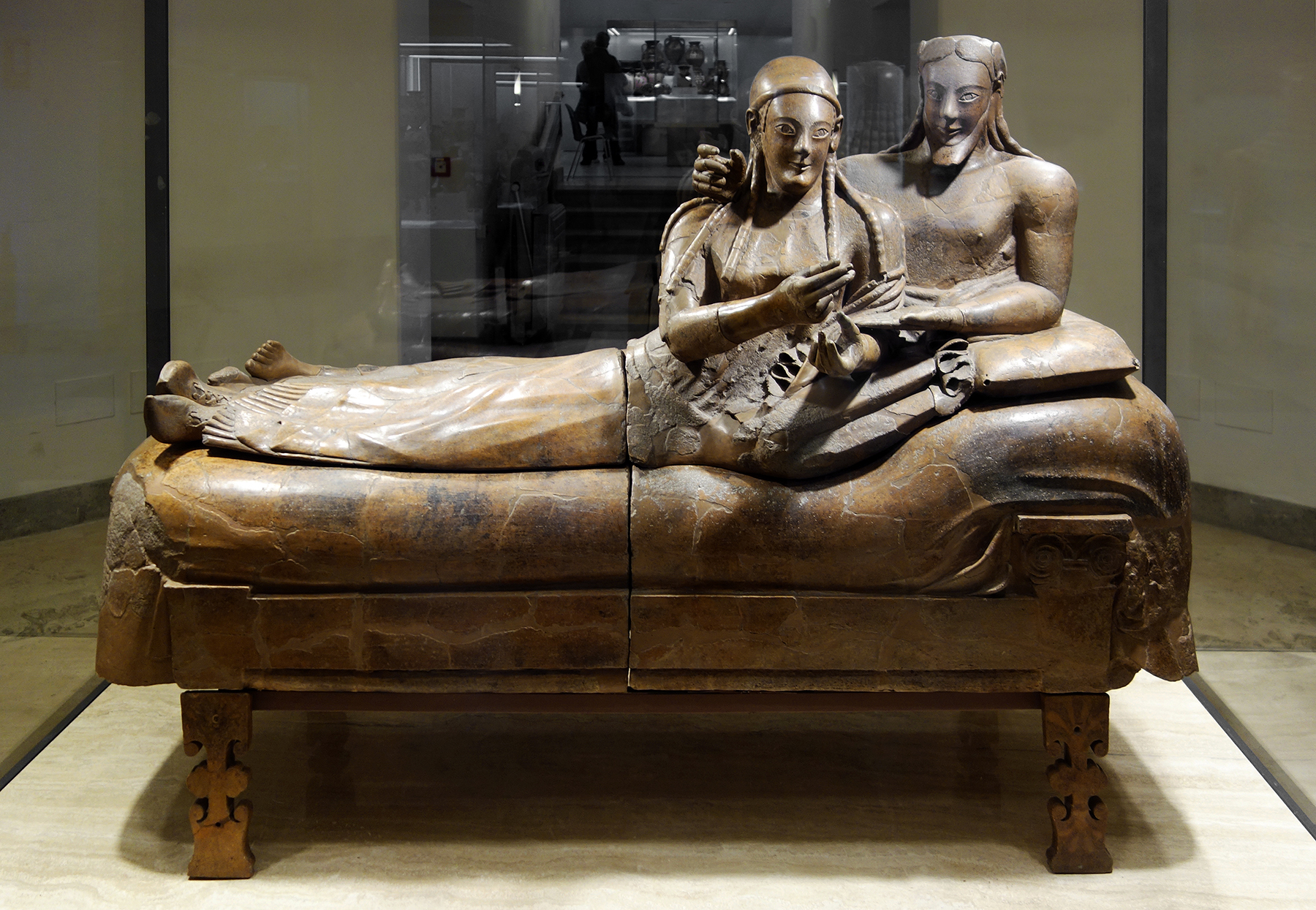
Sarcophagus of the Spouses, Etruscan, c.520 BCE
Form: Terra cotta, fired in multiple sections, painted originally, 3.7ft x 6.2ft
Content: male and female figures, stylized, elements of Greek and Etruscan art (angular joints, extended fingers and toes, pointed female shoes, abstract hair, elongated proportions), sarcophagus, female would have held a small object maybe a pomegranate, pictured in a way they would be at a banquet, on a kline (dining couch)
Content: found in the 19th century in modern day cerveteri Italy, others were found like it, inspired by social life of Etruscans and funerary rituals, used to reflect the perpetual liveliness in the afterlife, woman had more privileged status in Etruscan society, made with terra cotta because they did not have known access to marble
Function: funerary statue, would have held cremated remains, memorialized the deceased
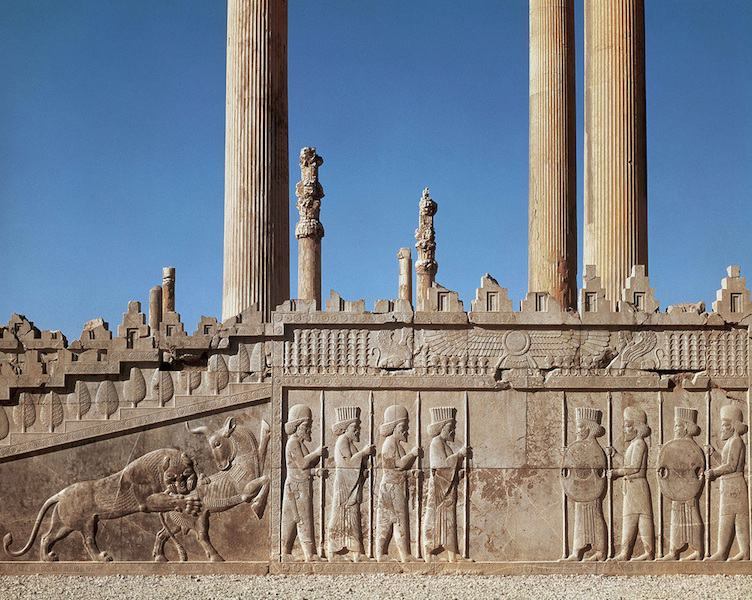
Audience Hall of Daris and Xerxes, Persepolis Iran c. 520-465 BCE
Form: limestone, 72 columns (each 24 meters tall, highly detailed), Hypostyle- held up by columns, sculptural programs, low relief
Content: mainly made up of columns, two sets of relief sculptures depicting processional (an actual ceremony, 23 nations depicted), Column capitals depict: blls, eagles, and lions (symbols of royalty or authority)
Context: visual microcosm of Achaemenid empire (persian empire ruled by estimated 44% of the human population of Earth by the 5th century), Persepolis- main city center means “city of Persians”, marked special by Darius the Great he started building, Xerxes and Artaxerxes continued the building process, sacked by Alexander the Great in 330 BCE, excavated by German archaeologists between 1931 and 1939, made into a world heritage site in 1979
Function: show power and dominion, sacred connection to Mithra and Persian New Years Festival, Important administrative and economic center, may have influenced Athenian sculptors (specifically the relief sculptures, friezes on parthenon)
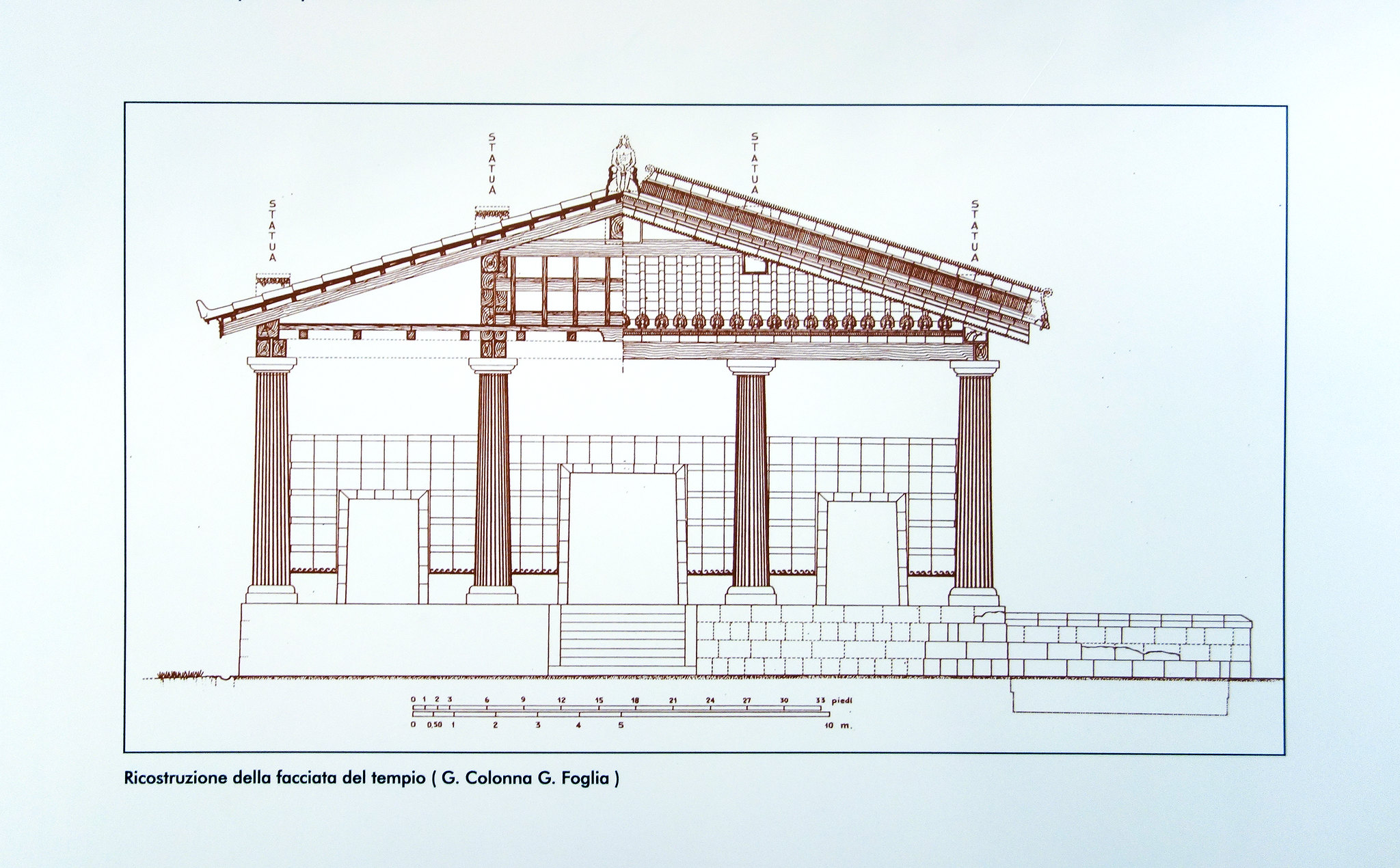
Temple of Minerva and sculpture of Apollo, Veii Italy, c.510-500 BCE
Form: Terra cotta, Tufa- volcanic porous rock, was for the foundation and is the only thing that remains, doric like columns, wood and mud brick, front porch, back portion is a triple cella, high podium
Content: temple made of materials that did not last, columns in front with 3 rooms in the back, sculptures inside along with masks and other decorations, Apollo of Veii- originally on ridgeline of roof, scene from greek mythology, animated smile, highly stylized
Context: Would not have created temple early on (worship in nature), created for Minerva, three rooms in the back for Minerva, Trinia, and Uni, counterpart to apollo is hercules in his third labor, terra cotta sculptures would have had the sky as backdrop, built through an additive process, very difficult to do with terracotta (made by Vulca), they tell us the story of the etruscans, vitruvius wrote about them and now archeologists can recreate them
Function: dedicated to divine triad, shelter for the gods, narrative roof sculptures
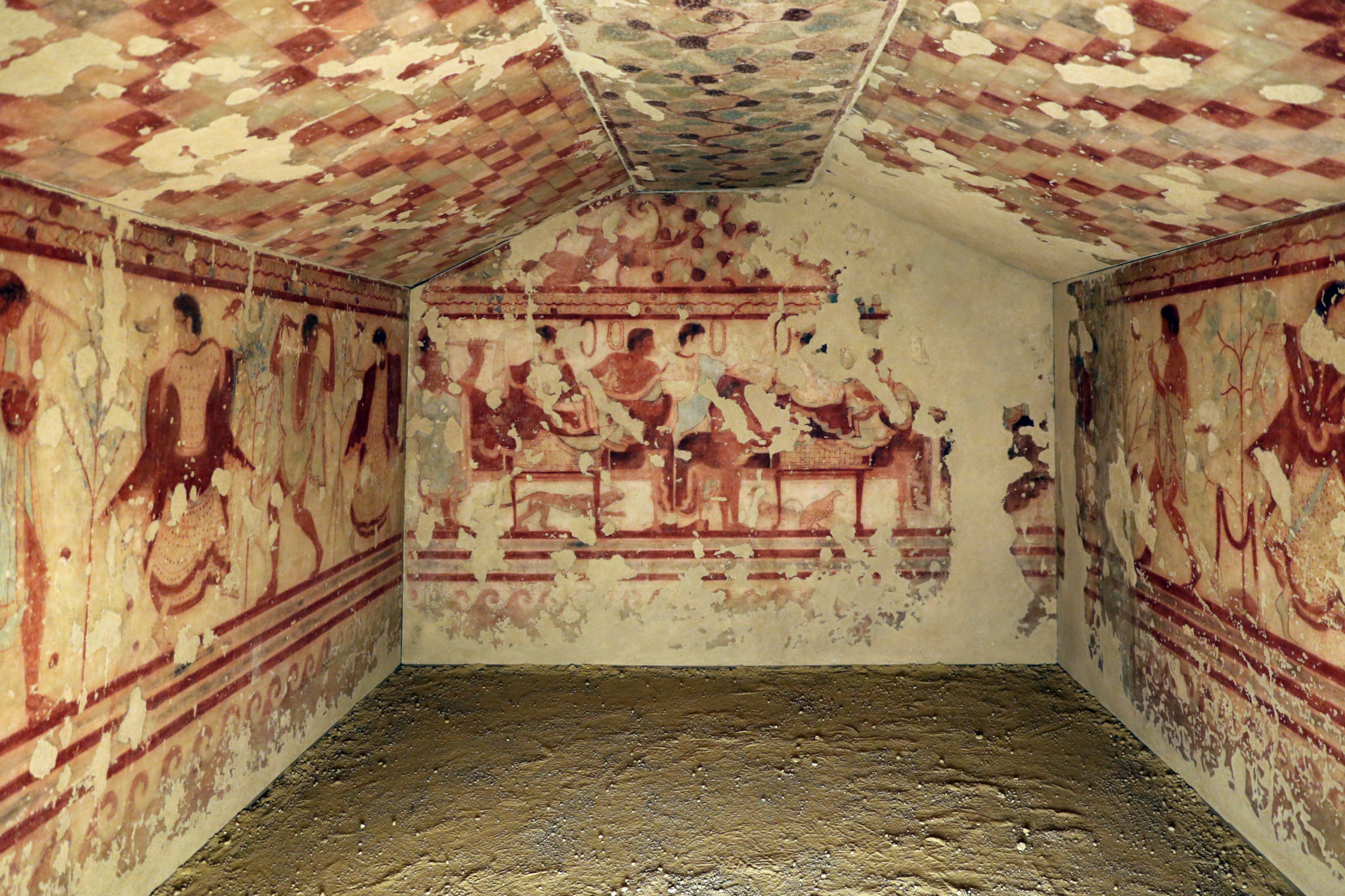
Tomb of the Triclinium, Tarquinia Italy, Etruscan, 480-470 BCE
Form: chambers in subterranean rock, in Monterozzi necropolis(cemetery)in Tarquinia Italy, Fresco paintings (painted while the plaster was still wet, adheres to the wall), couches
Content: originally three couches (triclinium) for last meals, many paintings on the walls that show funerary rituals, dancing, musicians, robes worn, the ceiling is checkered which represents fabric from the festival tents
Context: Funerary contexts tell us the most about a society/culture, did not bury their dead inside the city limits, Iron age culture, other goods and offerings were found, discovered in 1830, skin shown differently (men darker, women lighter)
Function: reinforce the status of person during games/festivals, send the deceased into the afterlife
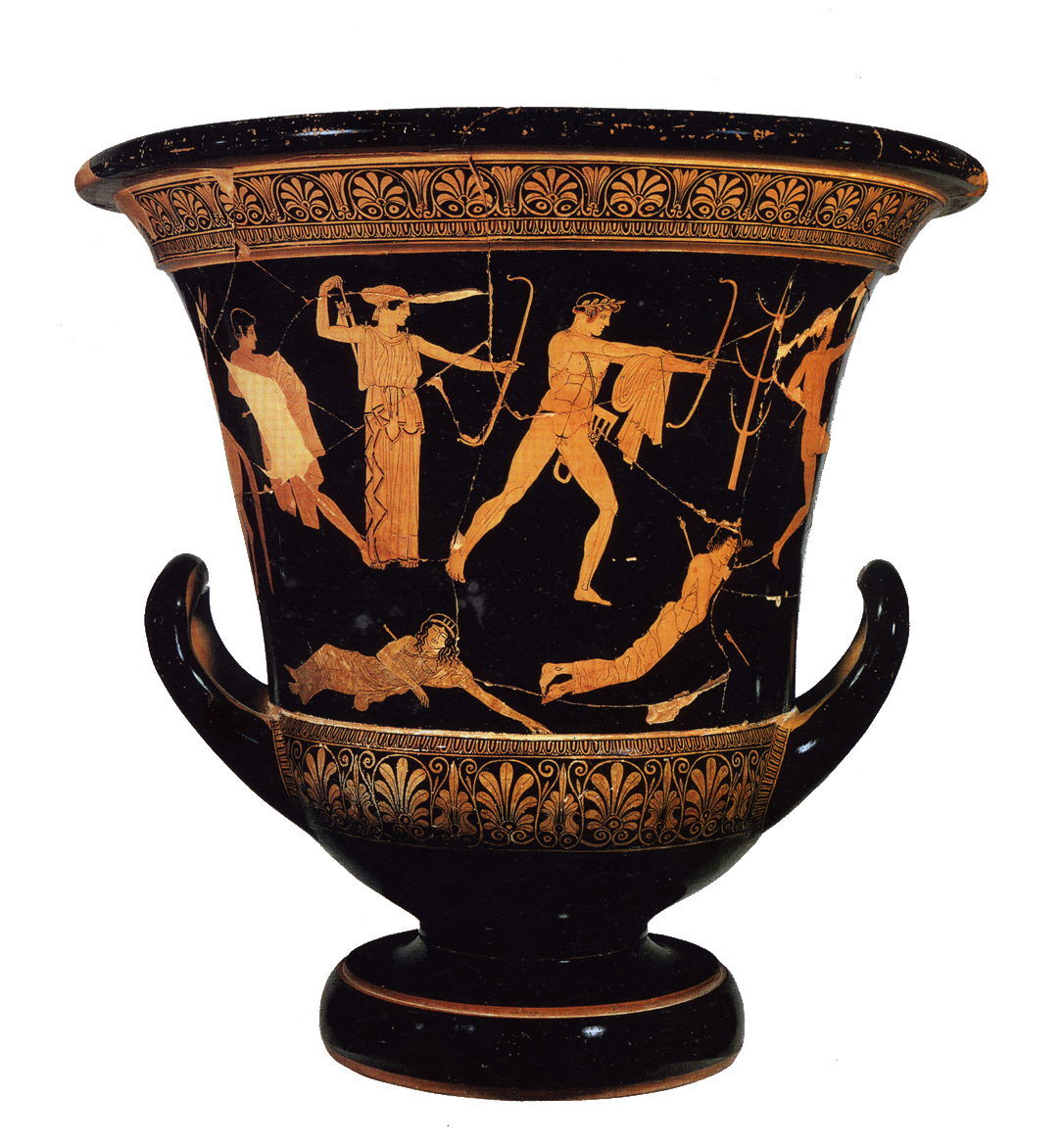
Niobides Krater, Greece, c.460-450 BCE
Form: terracotta, thrown vessel, red figure paintings, slip painted black, 21in tall, 22in diam
Content: Vessel with lots of decoration all around the surface, first side shows: Niobe bragging about her children being more beutiful than the goddess Leto, Leto sends her children Apollo and Artemis to kill all of her children, this shows an underrepresented story, Other side: shows herakles and soldiers gathering to honor and ask him for protection, he holds a club and is wearing a lion skin, Athena on his right, severe style (when archaic greeks turn to classical, still stiff figures)
Context:could be a copy of a wall painting by polygnotus, created by the Niobid painter, people crossing into different levels (background and foreground), maybe showing Athenian soldiers asking for help before the battle at Marathon (greeks and persians)
Function: punch bowl for mixing water and wine, relationship between stories is unknown, greeks love to show contrast between active/passive
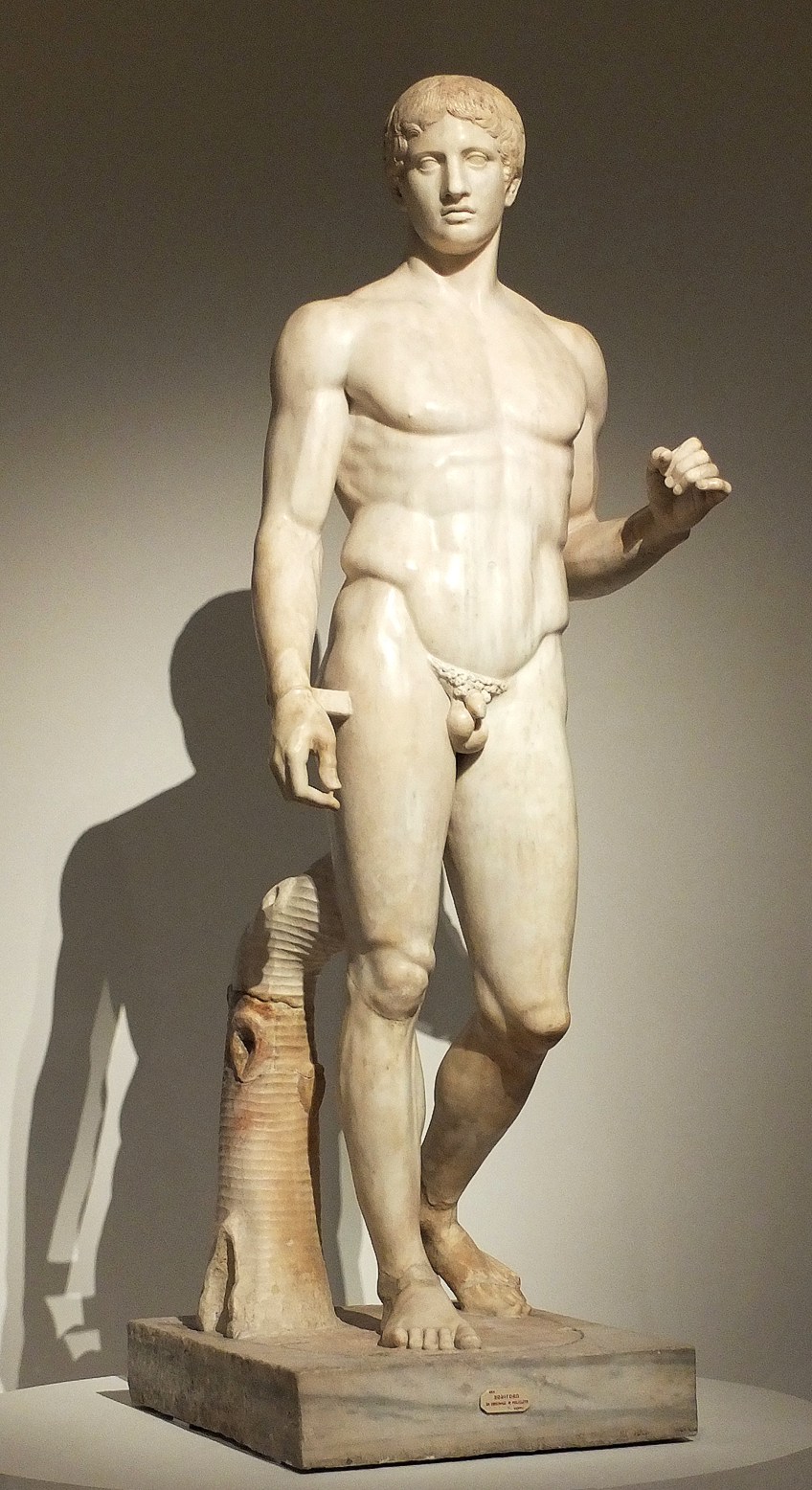
Doryphoros 450-440 BCE
Form: Roman marble copy, original bronze, free standing in bronze form, life sized 6-7ft
Content: male figure, Doryphoros- spear bearer, would have held a spear, A canon- set of rules based on math for perfect proportions of a man, Nude (athletes were nude), contrapposto, first time with like statues
Context: created by Polykleitos (mathematical relation between body parts), Greeks invented contrapposto, perfected human form, original was bronze “lost wax” method, used for display in roman elite houses, found in pompeii where athletes worked out, thousands of copies, for the first time in western art statues seem lifelike
Function: to show understanding of human form, establish canon, studying motion of human body
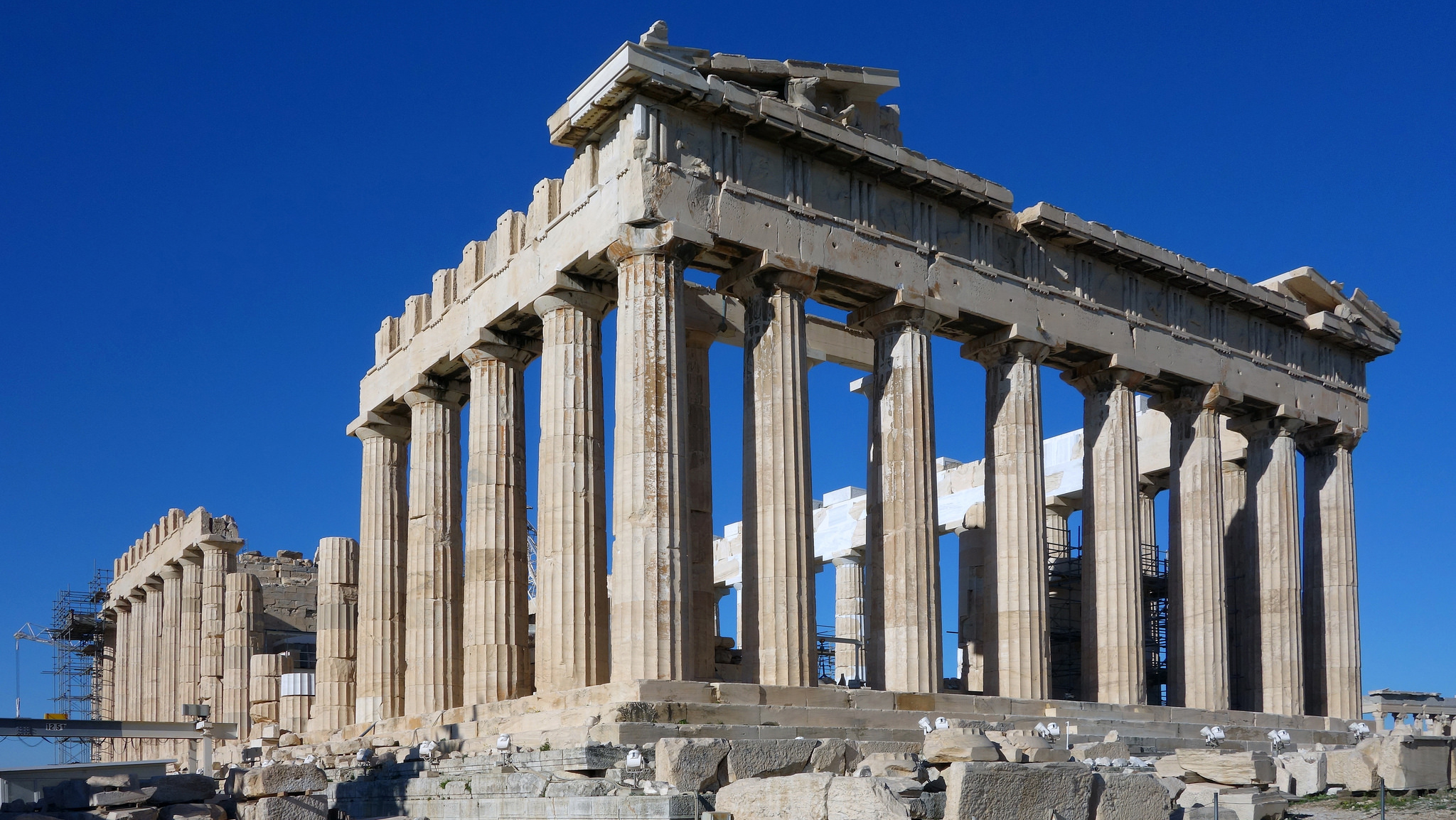
Acropolis, Athens Greece, c. 447-410 BCE
Parthenon: Treasury (not worship), replaced former parthenon that was destroyed by the Persians ( over time it was a church and a mosque, destroyed by gunpowder explosion when it held ammunition during war), is now being restored, the building celebrated the successful conclusion to persian war, would have been brightly painted, has doric and ionic columns, building was started by Perikles, based on geometry (understood human perspective and adjusted for it, slightly sloped for water runoff), housed Athena statue (made of gold and ivory)
Athena Pediment: story of birth of Athena, much has been destroyed, Athena born at dawn, figures reclining in a way that shows the sun rise, overseen by sculptor Phidias and in his style (the drapery), up very high, brightly painted
Plaque of Ergastines: fragments from the East pediment frieze (wrapped around the entire parthenon, 3 feet tall), represents the Panathenaic Procession (real event, bringing peplos to Athena statue), figures in contrapposto, relief, Ergastines (young noble women), British museum currently own
Temple of Athena Nike: Tetrastyle- 4 columns, Amphiprostyle- front and rear facades, dedicated to Athena Nike (victory and battle) sculpture of Athena inside, helmet in one hand (war) and a branch of pomegranate tree in the other (peace), 27 feet long, 18 ½ ft wide, 27ft tall, earliest temple with ionic columns
Nike Adjusting her Sandal: 3’6’’ tall, high relief, depiction of goddess, off balance (human-ness), drapery thin and heavy (phidian), part of frieze on parapet, slabs on the parapet represent individual scenes
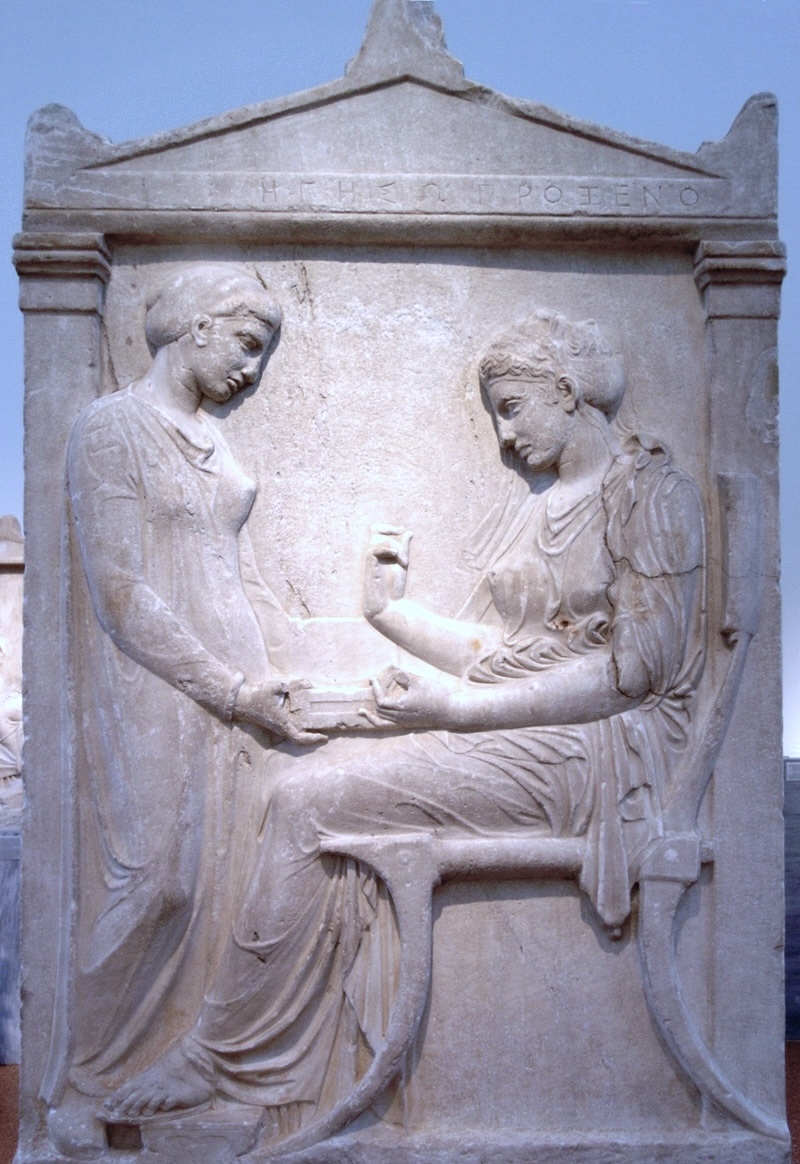
Grave stele of Hegeso, c.410 BCE
Form: stele, 5ft 2in, carved marble, painted
Content: hegeso is the one seated being presented jewelry by her slave, shown in a domestic setting because women were not citizens, lots of detail in drapery, veery shallow space but shows full width of body
Context: dipylon cemetery in Athens, created at the end of high classical era, most of the time was spent on the Acropolis so not many of these, takes the place of Kouros and Kore statues, quiet image
Function: grave marker
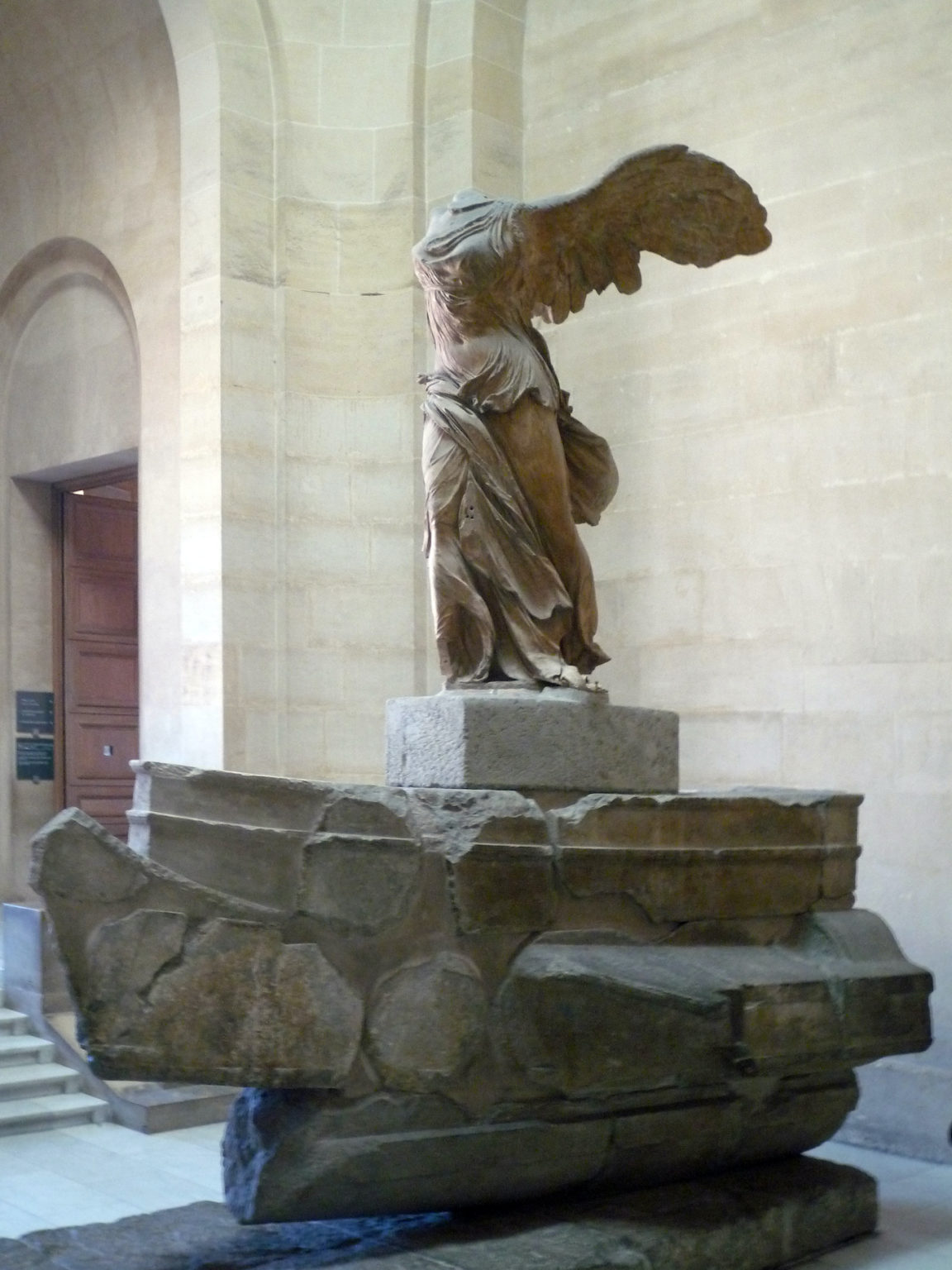
Winged Victory of Samothrace, Hellenistic Greek, c.190 BCE
Form: carved marble, 9ft tall, many stones stacks, originally painted
Content: Nike, on a pro of a ship, would have been in a temple, heavy drapery, lots of detail, windswept, full of motion, wet drapery technique
Context: hellenistic, found on the island of Samothrace, victory goddess, reconstructions show her holding a horn, intended to be viewed from multiple angles
Function: Naval victory, protects sailors and armies against storms and enemies, celebrating the body, worshipers came from throughout the ancient mediterranean, cult of the great gods
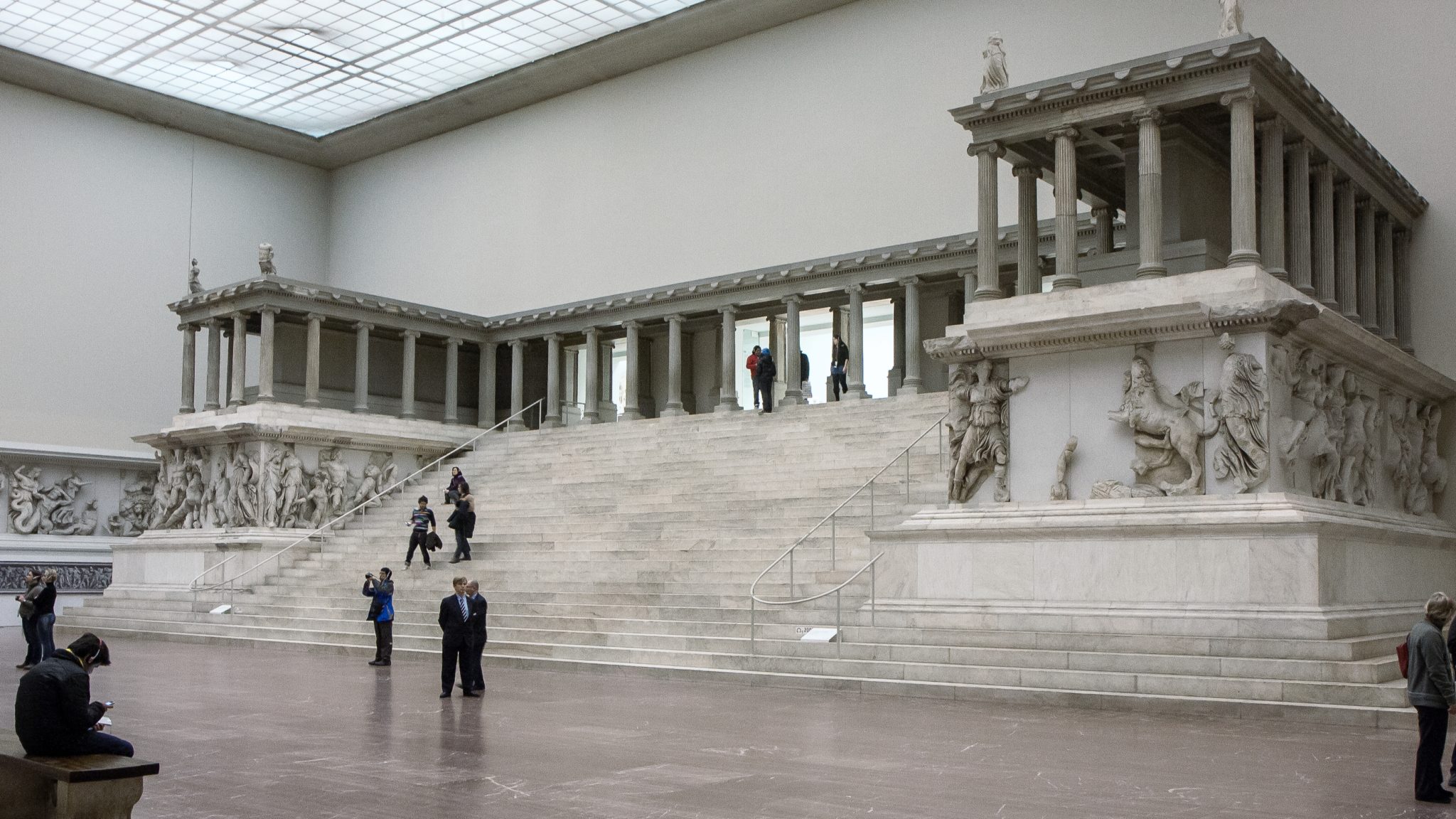
Great Altar of Zeus and Athena at Pergamon, Hellenistic Greek, c.175 BCE
Form: 114×100 ft, high relief, carved marble, painted
Content: Hellenistic expressive and dynamic, last period of greek art, great mythic battle where giants battle gods for supremacy of the earth and the universe, athena frieze and Zeus frieze, dynamic body positions
Context: pergamon established by generals of Alexander the Great (he built the altar), very important story to the Greeks, victory of Greek culture over the unknown or of culture that they didn’t understand, in Berlin because Prussia wanted to be equal to Britain and France
Function: top of the Acropolis in Pergamon, over look land, show power, honor Zeus and Athena, a sacred precinct
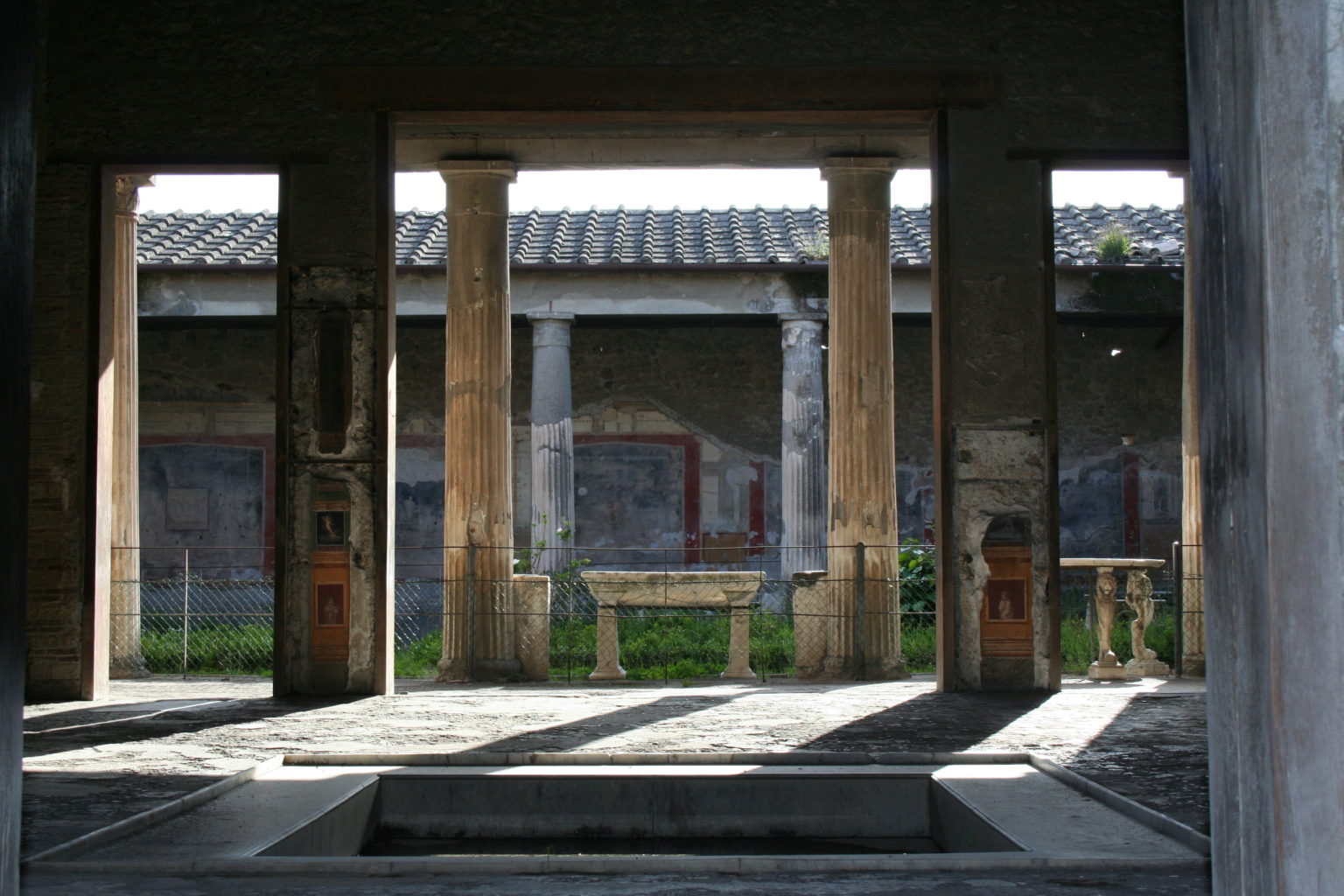
House of Vettii, Pompeii, around 2nd century BCE
Form: 11,840 sq feet, demonstrates Pompeii’s late artistic and architectural style, cut stone, frescos, Domus (roman townhouse)
Content: Domus floor plan, walls are painted in a progressive or transitional style (3rd-4th), turned rooms into picture galleries, central atria hall, more private areas to more open areas, Peristyle (a colonnade surrounding a courtyard), water basin, house built on remains of earlier house
Context: Home of Aulus Vettius Conviva and brother Aulus Vettius Restitutes (they were former slaves, top civic office), built to show wealth, Vitruvius wrote about the design of the house, Patron client system (patrons=protection client=favors), Atrium was where clients were greeted, Buried by Mt. Vesuvius, excavated between 1894-1896, Fourth style ( combination of past styles, faux marble, naturalistic scenes, large flat planes of color, central pictures, wide range of themes)
Function: domestic space, to show wealth and status
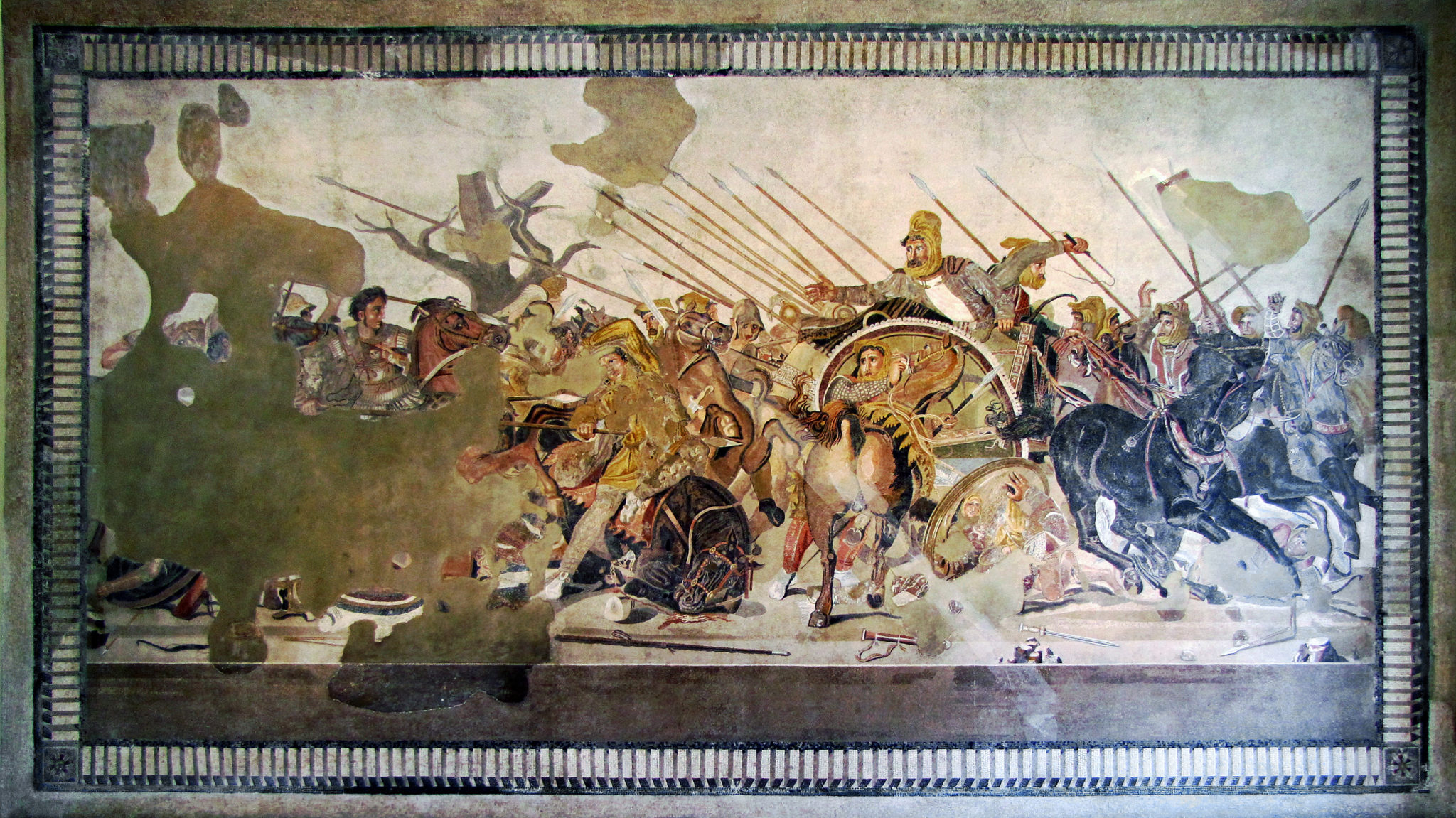
Alexander Mosaic from the House of Faun, Pompeii, 100 BCE
Form: floor mosaic, 9ft x 17ft, 1.5 million tesserae, laid down in a “worm life” style (opus vermiculatum), originally a greek painting by Philoxenos
Content: One of the most important battle in ancient history (battle of Issus, when Darius/ Persians flee under the onslaught of Alexander the Great (greeks), Horses and soldiers in retreat, tension all around, foreshortening, many tiles missing
Context: discovered 1831 and moved to Naples 2 years later (replica made in 2005 for the house), between two Peristyle court yards, elaborately decorated mansion (largest and most decorated residence in Pompeii), realistic dynamic movements, foreshortening and tonal gradation
Function: depicts battle and victory, human emotion, entertain guests, show wealth ( romans wanted to be like greeks in art forms)
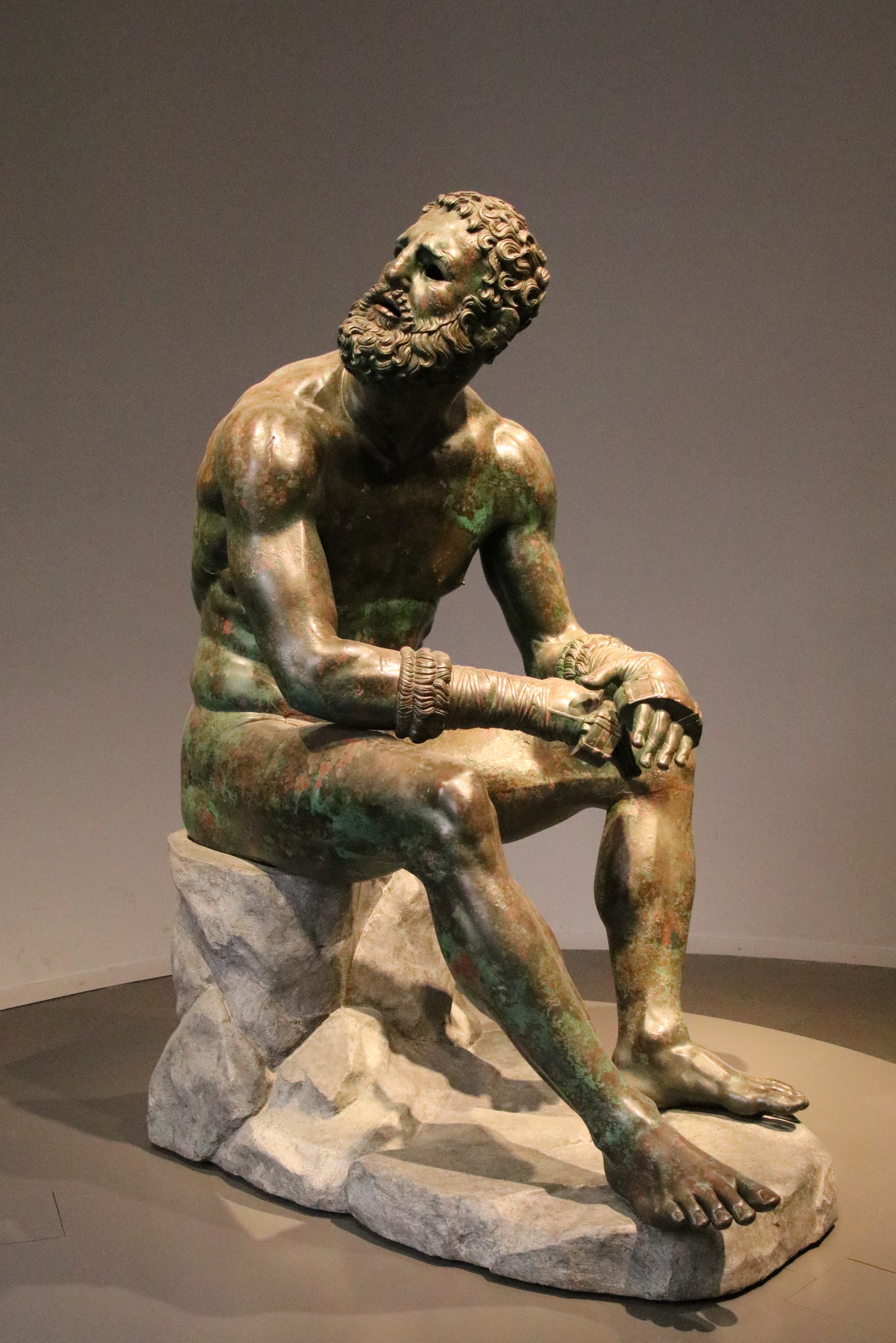
Seated Boxer, Hellenistic Greek, c.100 BCE
Form: Lost wax casting, Bronze, copper inlay, seated, ivory/glass paste eyes, naked figure except boxing gloves
Content: older boxer, athlete (perfect looking but exhausted), more human, blood (made by copper), broken nose, informal (slouched), turns to look up (at someone?)
Context: one of the few original greek bronze statues (not melted for weapons), beginning of exploration into a much wider variety of art/subjects, Pathos (loss, sadness, pain), Hellenistic ends when Rome conquers Greece, moving beyond heroic, originally maybe part as a group, boxing in ancient greece had focus on hitting the head, rarely see figures in classical Greek art
Function: represents shift in art, votive statue dedicated to the boxer, represents boxing culture, originally would be in a greek sanctuary or the boxers home town
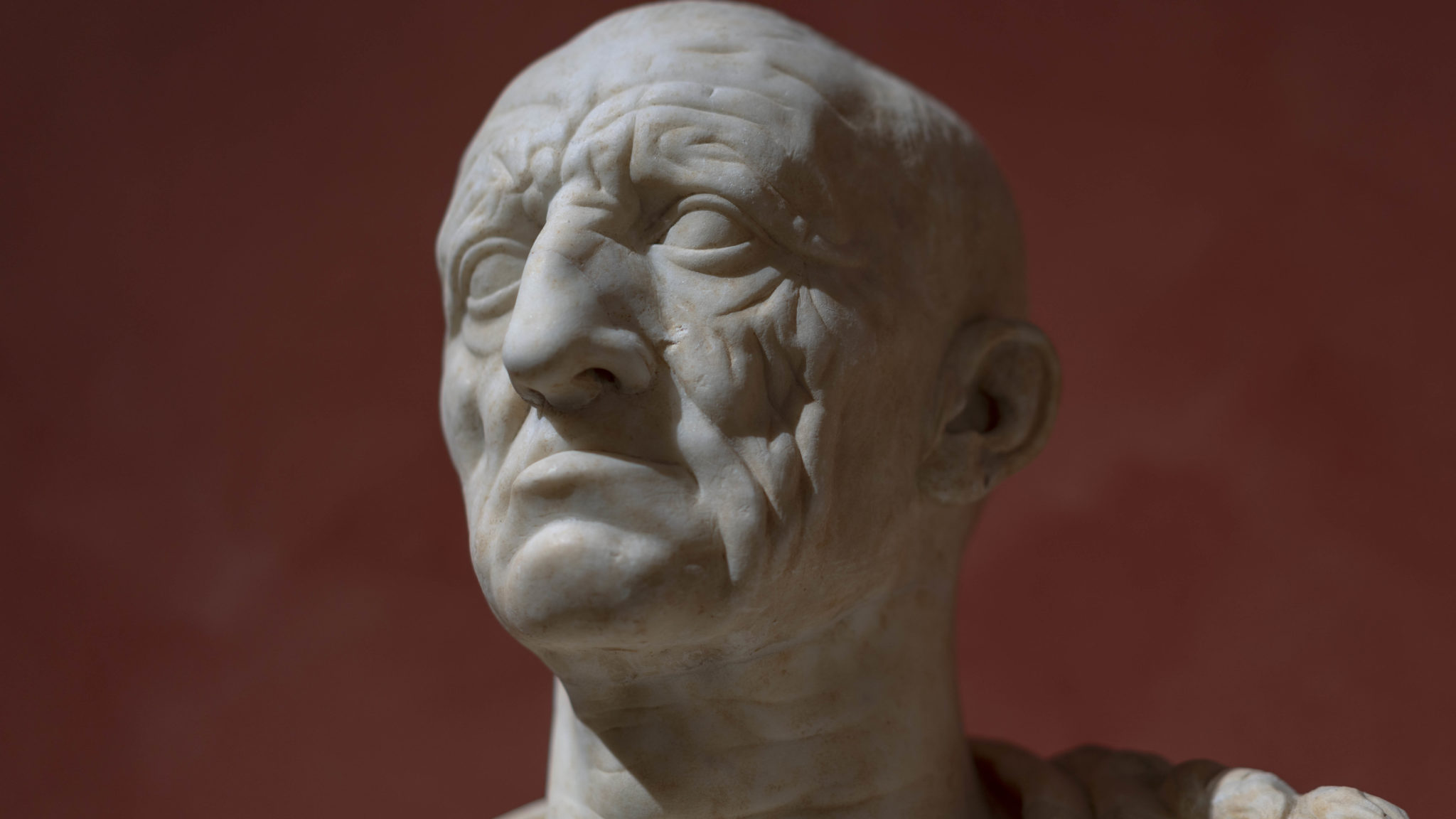
Head of Roman Patrician, Republican Roman, c.75-50 BCE
Form: carved marble, 1ft 2in, painted, veristic style (hyper realistic, natural exaggerated features)
Content: wrinkled face (marks of old work), male aristocrat, hooked nose, strong cheekbones, frontal, no emotion
Context: from Otricoli Italy, Verism influenced by tradition of ancestral images (death masks), deep respect for family and tradition, these masks were helpful in creating a lineage of ancestors for political and business gain, gravitas and virtue were valued, public image is important, unlike the Greek the romans believed that a head was enough to suffice as a portrait
Function: symbol of virtues, admire elderly
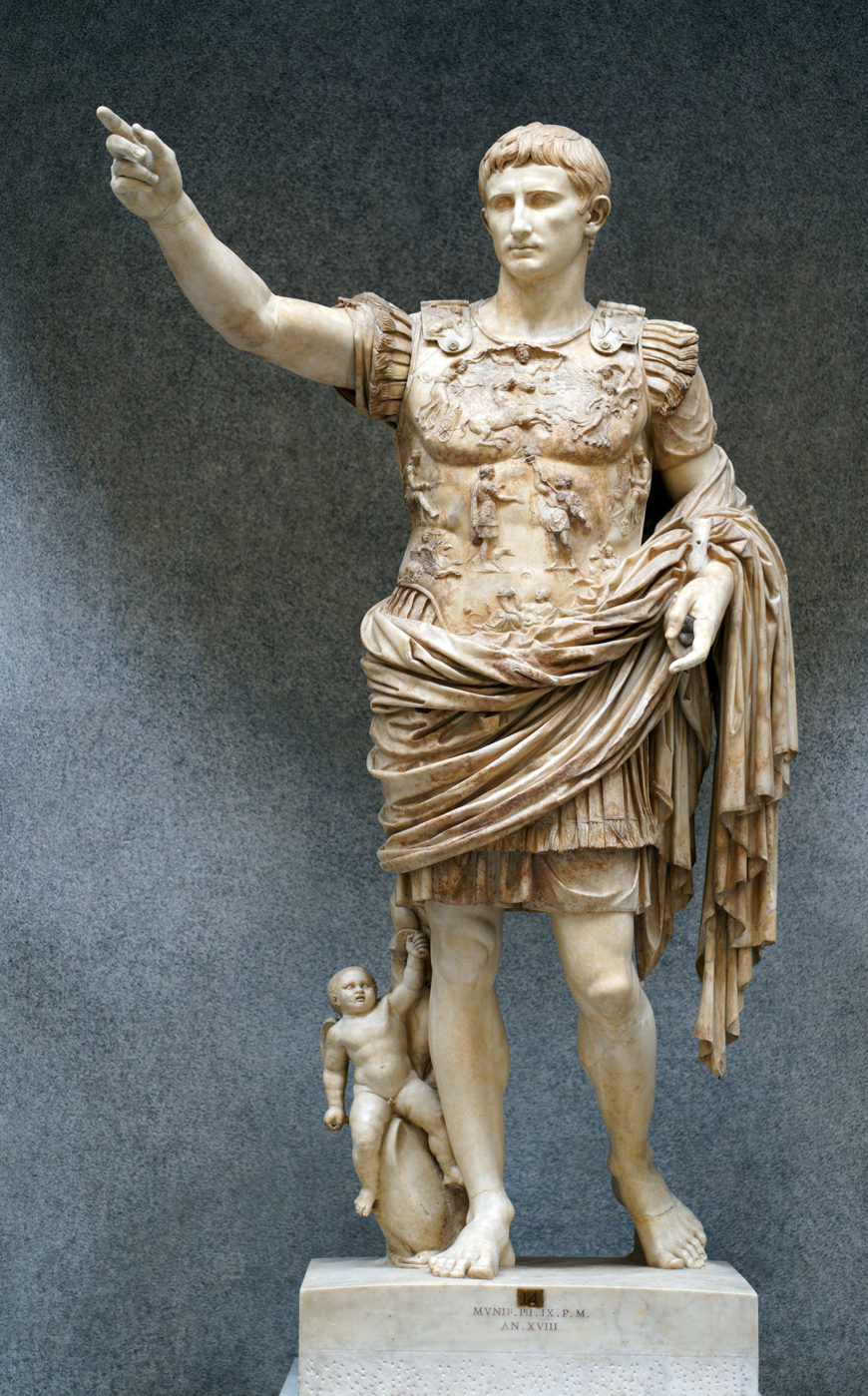
Augustus of Prima Porta, Imperial Roman, early 1st century CE
Form: free standing, relief (carving on breastplate), contrapposto stance, marble, 6’8”, depicted in the pose “the orator”
Content: Augustus of Primaporta (1st emperor of the Roman empire), military regalia, right arm outstretched addressing troops, similar in appearance to the Doryphores, dolphin for the great naval victory over Mark Antony and Cleopatra, Cupid for his connection to the Gods, Breastplate is full of symbolism
Context: reestablishing senate but really stabilizing Rome, canon of proportions, political significance, symbolizes the gods are on his side, military victor and bringer of Pax Romana, found at the villa of his wife Livia, many copies, roman art was closely intertwined with politics and propaganda
Function: visual propaganda, communicates power and ideology, expresses Augustus’ connection to the past, role as a military victor, connection to the gods, role as bringer of the roman peace
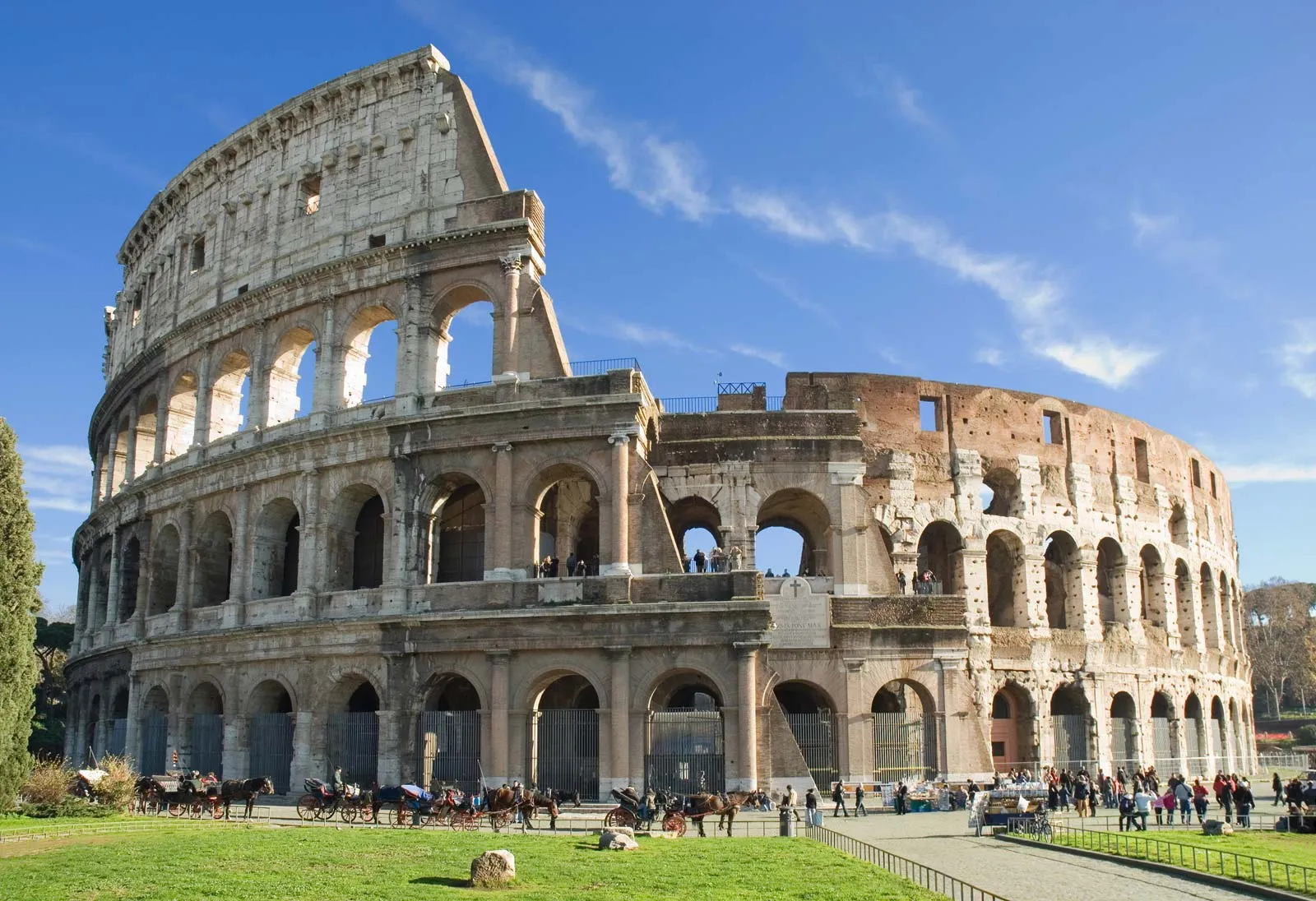
Colosseum (Flavian Amphitheater), Rome, 70-80 CE
Form: stone, travertine outside, tufa inside, concrete foundation, arches hold more weight than post and lintel, 6 arches, 187ft high, 615ft long, 510ft wide, oval amphitheater, sand floor for easy blood clean up
Content: donut shape, numbering system for seats, seated according to status, three stories of arches (4th floor with windows), arches frames by columns (1st level tuscan, 2nd ionic, 3rd corinthians), stage at center (hypogeum- underground part), velarium (retractible awning)
Context: original name was flavian amphitheater (paid for by the flavian dynasty, colosseum came from being close to the colossal Nero statue), Arena means sand in Latin, built in only 10 years, concrete was less expense and did not require specialized workers, aggressive with landscape, people could become citizens, wooden mold for concrete
Function: Entertainment for all, mornings there were animal hunts, midday execution of prisoners, afternoon gladiatorial fights, Hypogeum (connected halls, for gladiators and animals before the performance), Order of seating: senators, knights, plebeians, poor/women/slaves
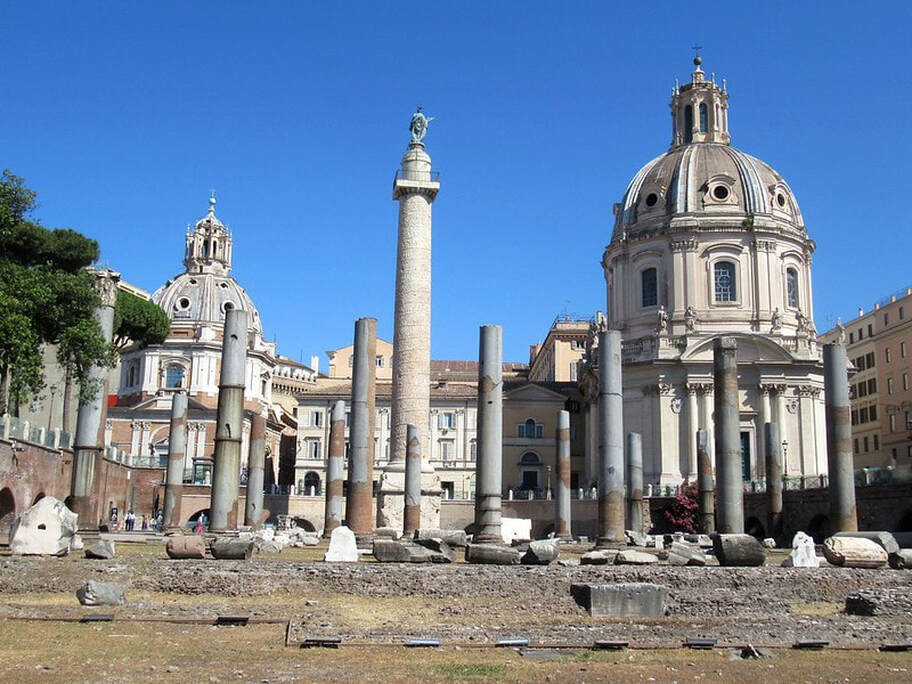
Basilica Ulpia, Rome, 106-112 CE, column 113 CE, high empire
Form: brick libraries, stone, imported marble, concrete, gilded bronze roof tiles, forum (public meetings, courts, combats, linked to shops and markets)
Content: multiple sections, Basilica Ulpia (uniquely roman), One library latin one greek, main square courtyard with porticos on either side and exedra (statue spaces) in the side of those, market, temple in back finished by succeeding emperor Hadrian, lots of sculptures, relief carvings, statues of Trajan
Context: built for Trajan (the emperor), he was the emperor who was not born into the role, designed and built by architect Apollodorus of Damascus, Basilica ulpia (Trajans family name), trajan was an incredible military leader and lead Rome to its greatest extent
Function: public space, civic, judicial, and social, commemorate Trajan
Forum of Trajan:
Form: 125 ft tall, fine grained luna marble, gilded statue at top of column, multi colored marble floors, painted, continuous narrative on column, markets use groin vaults
Content: tells the story of Traigans victory of Dacians, 22 layers, 155 scenes, victory crown base, personification of Danube river, clear ethnic typing to show difference between the romans and the Dacian soldiers
Context: placed between the two libraries to be seen at all angles, forum is deteriorating due to pollution, originally thought it was like a Roman mall but probably more administrative role, base held ashes of Traigan
Function: Mausoleum, celebration of the army, empire, and people, inspired the washington monument
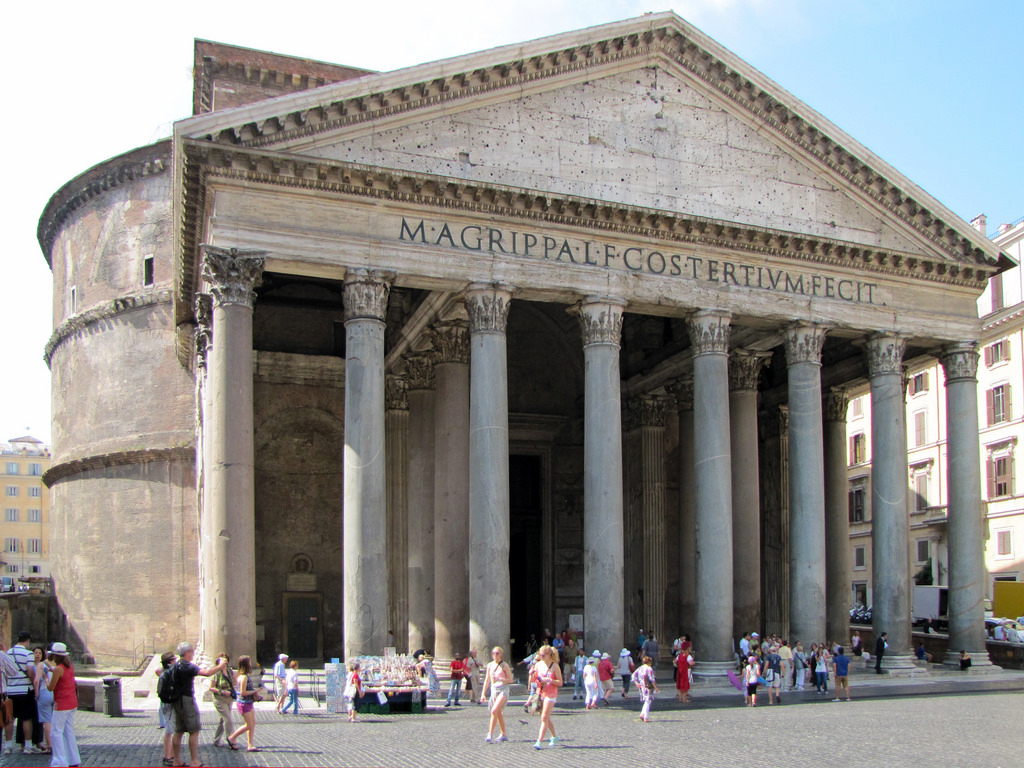
Pantheon, Imperial Rome, 118-125 CE
Form: corinthian monolithic columns, portico (rectangle opens to sphere), arches and dome for support, lighter materials at top, concrete, stone, focus on geometry
Content: coffered ceiling in dome (28 sections paired with 28 columns, perfect number), oculus (open, rain comes in, heavens), pediment, originally filled with bronze statues, inscription in bronze “Marcus Agrippa”, Hadrian built it originally
Context: thought to be a temple, maybe more a dynastic sanctuary, sacred site of Romulus, potentially designed by Apollodorus, evolved into a christian place of worship in 613 CE, ground is built up around the Pantheon due to debris, best preserved ancient Roman monument
Function: Temple to all the Gods, emperor would hold court, expression of Hadrian’s wealth and power, oculus=sundial, it influenced other important architecture like the library Thomas Jefferson designed
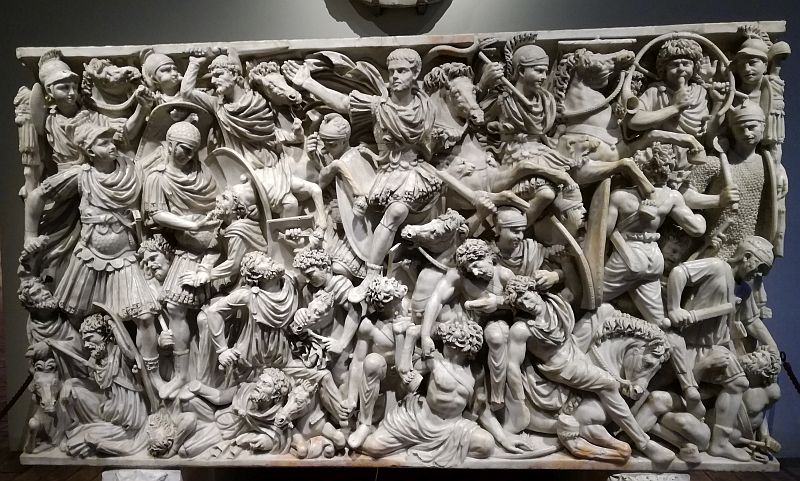
Ludovisi Battle Sarcophagus, Late Imperial Roman, c.250 CE
Form: very high relief, detailed carving (4 layers deep, figures on figures), use contrast of light and dark to guide viewer, chaotic scene, could be compared to chaos of time in empire, no illusion of space behind figures, rejection of classical representation
Content: battle scene (romans vs goth), leader in center, lots of movement
Context: emperors still cremated in 1st century, in 2nd century we see more and more sarcophagi, purchased by cardinal Ludovisi in 1621 CE, Intention in the interaction between figures, Instability in the Roman Empire during this time
Function: burial, unknown person, display wealth and status
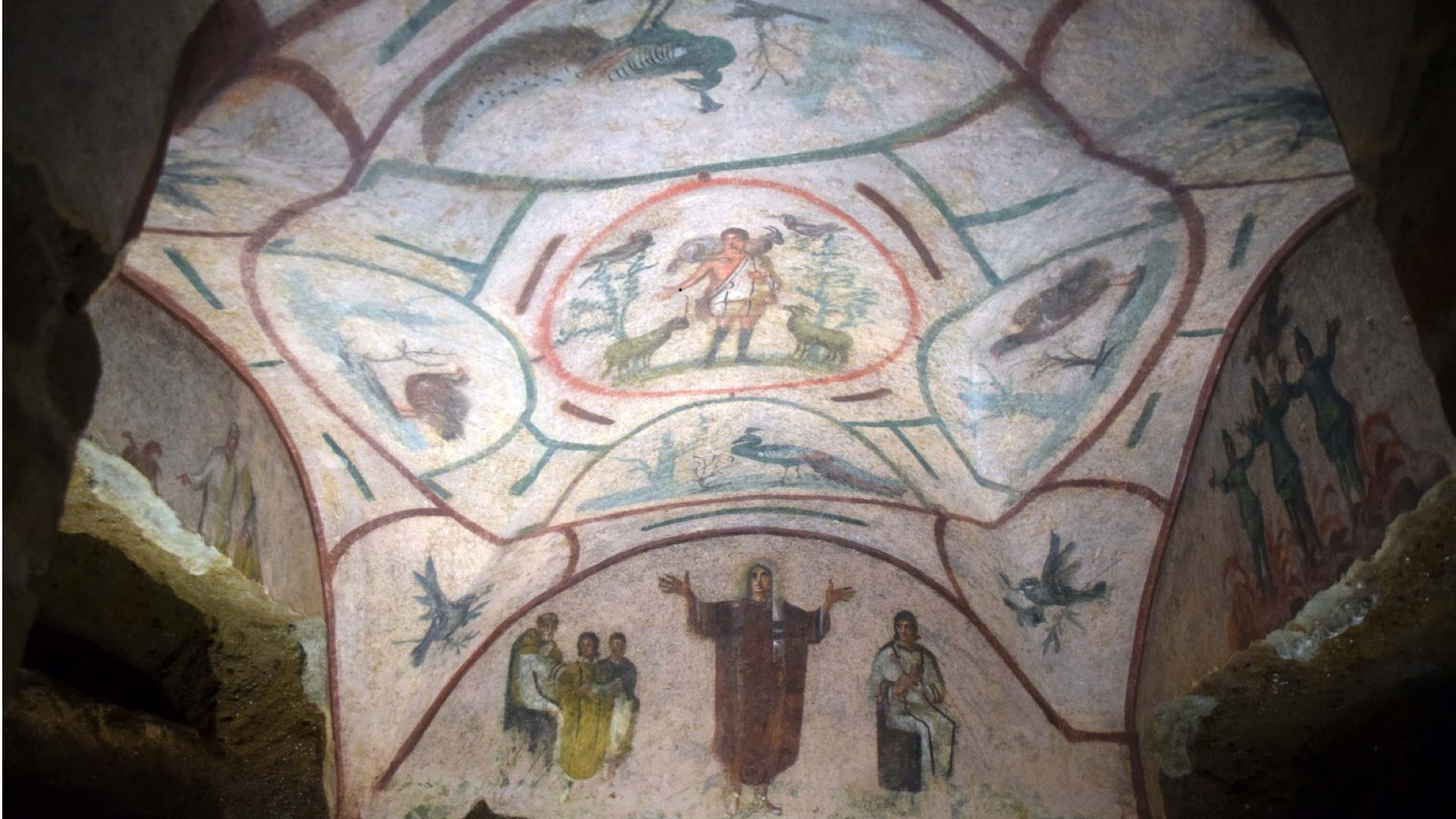
Catacomb of Priscilla, Rome, Late Antique Europe, 200-400 CE
Form: Tufa stone, Plaster frescoes, Greek chapel (not greek or a chapel), cubiculum and loculi, painted and carved symbols, Roman 1st style (plaster walls, painted to look like marble)
Content: Orant Fresco (pose of prayer, woman in afterlife, 3 times (marriage, motherhood, and prayer)), Greek Chapel (Adjacent to basement of original house, eucharist), Good Shepherd (symmetrical, christ will take care of his followers, doves, peacock-eternal life, quail-earth, christ between heavenly and earthly)
Context: Place where earliest christians were buried and where they worshipped when christianity was not allowed, 40,000 tombs, 3 stories deep, located where the villa of Priscilla was (she was rich and gave the land), empty now (grave robbing), martyrs, small holes for oil lamps, scenes among the earliest christian iconography
Function: catacombs- underground passageway, cubicula (small mortuary chapels, extravagant sarcophagi), Loculi (opening in wall, shelves for the poor)
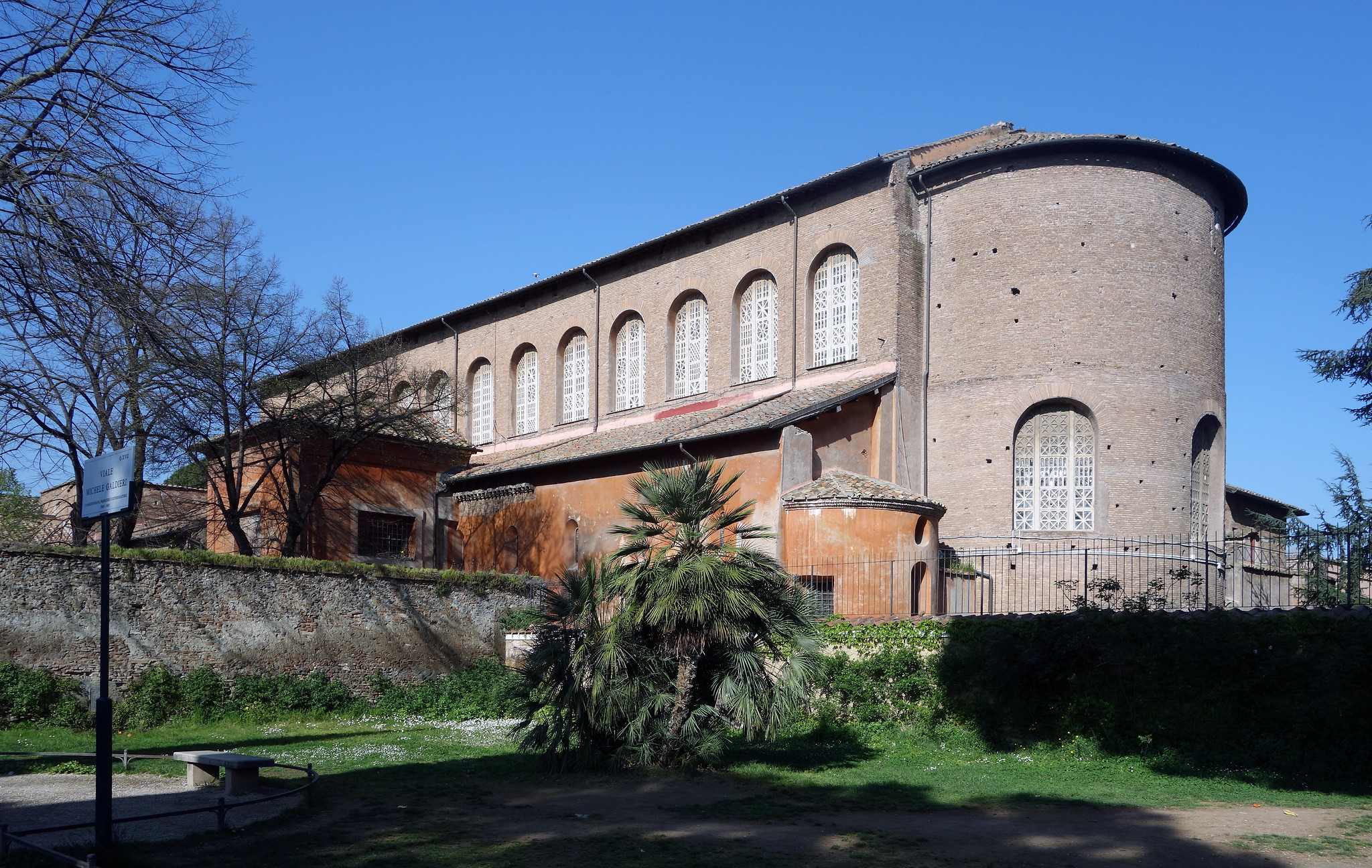
Santa Sabina, Rome, Late Antique Europe, c.422-432 CE
Form: Axial Plan (building structured longitudinally, focus on altar), Basilica (large oblong hall, double colonnades and semicircle), Nave (main isle of a church), Decoration change over time (once had mosaics), Spolia (repurposed building stone), Clerestory (window story of a church, divine light), Flat wooden roof (practical, coffers)
Content: Emphasis on architecture is on the spiritual effect, repurposed basilica, focus on the altar, like Saint Peter’s- commissioned by constantine, wooden doors 5th century (1st imagery of crucifiction images)
Context: Earliest christian building, dates to 400s (only 100 years after constantine legalizes christianity), built by the priest Peter of Illyria, Saint Sabina- convert to christianity due to her female slave Saint Serapia (beheaded and buried near sabina), gives us an idea of what early churches looked like (only one that remains),on top of a hill much larger interior space
Function: place of worship, built to accommodate the devoted, inspire people to follow christianity
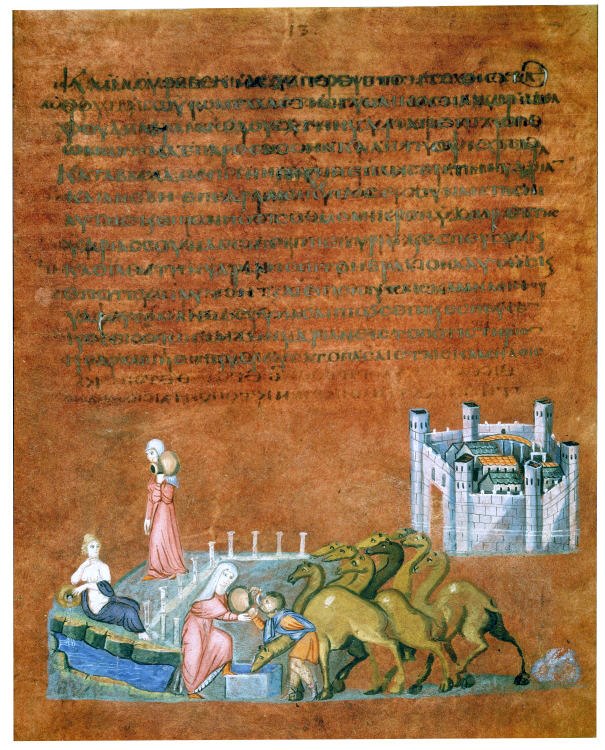
Rebecca and Eliezer at the Well and Jacob Wrestling the Angel, from the Vienna Gospel, Early Byzantine Europe, sixth century
Form: illuminated manuscript, silver paint, dyed purple animal skin, illustration at bottom, text on top, handwritten, handwritten, Eliezer (a servant of Abraham), jacob
Content: two episodes with a single frame, had to make illustration fit within a small context, 24 surviving pages, 96 total, cartoon-like figures
Context: early manuscript-early christianization/byzantine era, 1st book of the bible, rare because books do not usually survive, dyed purple, royal commision but it was seen as un-christian because it meant you lacked humility, continuous narrative, ancient techniques with christian images, scribes
Function: to tell the stories from the bible, Rebecca and Eliezer at the well (abraham wanted to find a wife for his son isaac and sent eliezer to find one from his extended family), Jacob Wrestling the Angel ( jacob, his two wives, two maids, eleven children)
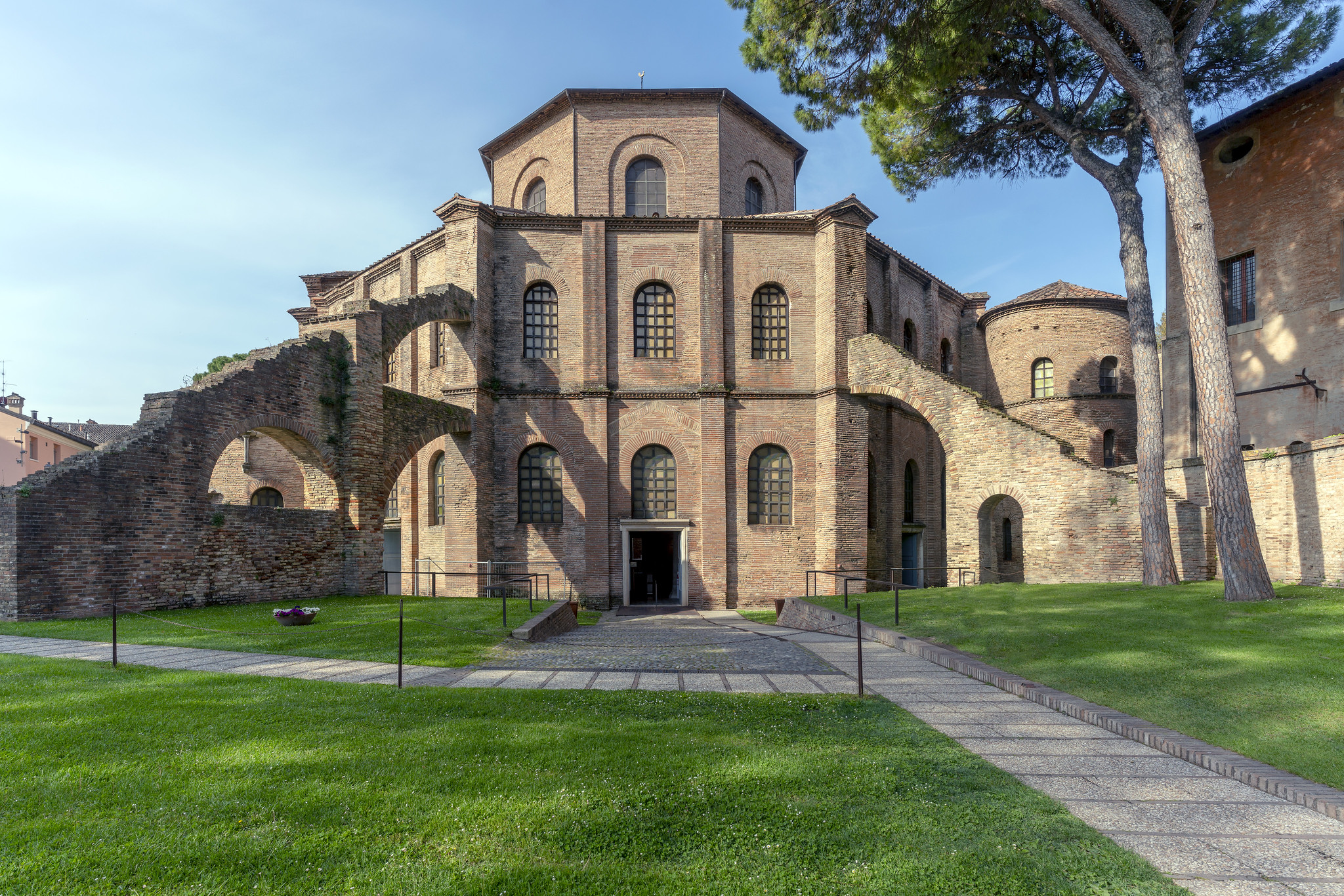
San Vitale, Ravenna Italy, Early Byzantine Europe, c. 526-547
Form: centrally planned, lots of windows, ambulatory (aisle that surrounds central space, octagon with smaller one that rises up), brick, tesserae (some with gold leaf)
Content:Arches, stacked columns, martyriums (shrine built over a place/grave of a martyred saint), details show the richness of the imperial court in Constantinople to Ravenna, Justinian (centered and frontal, halo, purple robes, flanked by clergy and soldiers, establishes central position, power of the church and military, marks the beginning of Byzantine liturgy of Eucharist, tension between church and emperor), Theodora ( Justinians wife, mirrors panel, rules as co-equal, wearing elaborate clothing, halo, eucharist, surrounded by attendants)
Context: San Vitale- martyred christian, justinian lived in constantinople and never traveled to this church, fibulae-brooch or pin to fasten garments, Chi Rho or XP- the first two letters of Christ in Greek (christogram, earliest form of this)
Function: christian church, extreme importance in Byzantine Art, only major church from the period of Justinian I to survive virtually intact, Power and glory of Byzantine empire (also Justinian and Theodora)
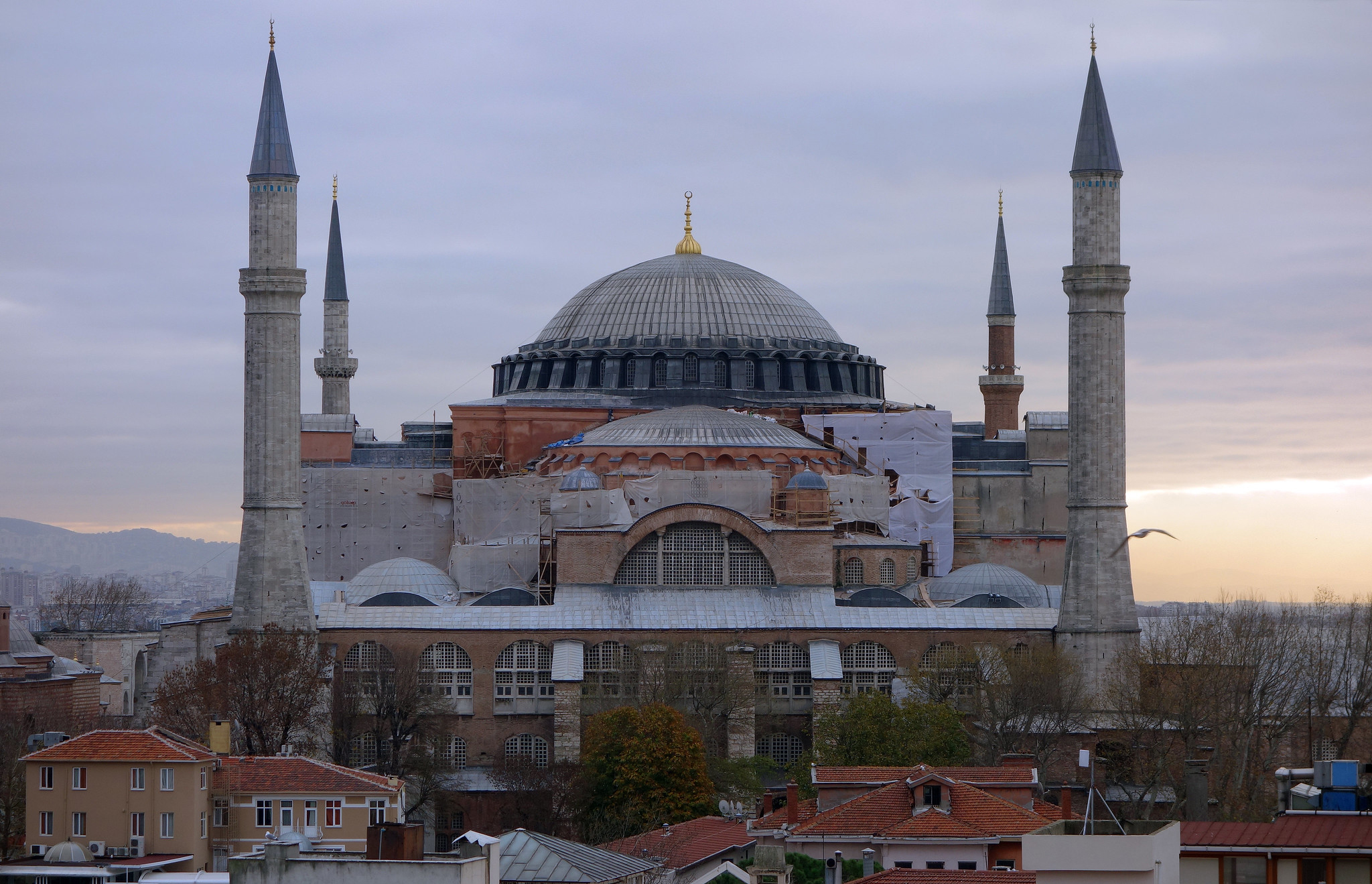
Hagia Sophia, Constantinople, c. 532-537 CE
Form: combination of central and axial plan, minimal exterior decoration, pendentive (flat walls to domed ceiling), lots of windows, 270’L x 240’W x 180’H, dematerialization (divine power to create, illusion of floating), Pendentive (a construction shaped like a triangle that transitions the space between flat walls and the base of a round dome), Squinch (the polygonal base of a dome that makes a transition from the round dome to a flat wall)
Content: decorative in construction (use of marbles), filigree capitals, Gold mosaics (made light bounce around), no figures early on (stems from the belief that the creation of living forms is unique to god), enhanced over time as different functions
Context: created by justinian as a way of putting people to work who might not and express power, Emperor palace was close by, engineering marvel, 1st time seeing pendentives on this scale, light (idea of perfection and the divine), burned and was rebuilt (redesigned each time to be better), The Emperor justinian and his wife Theodora began an extensive rebuilding campaign to restore the city but also to tighten control and consolidate their power in the capital city, young boy heard from angels how to build it, symbol of Byzantium
Function: Eastern Orthodox cathedral (53-1453 CE), Mosque-ottoman empire, added the calligraphy and minarets (1453-1934 CE), Museum (1934), Mosque again 2020 (this saved it)
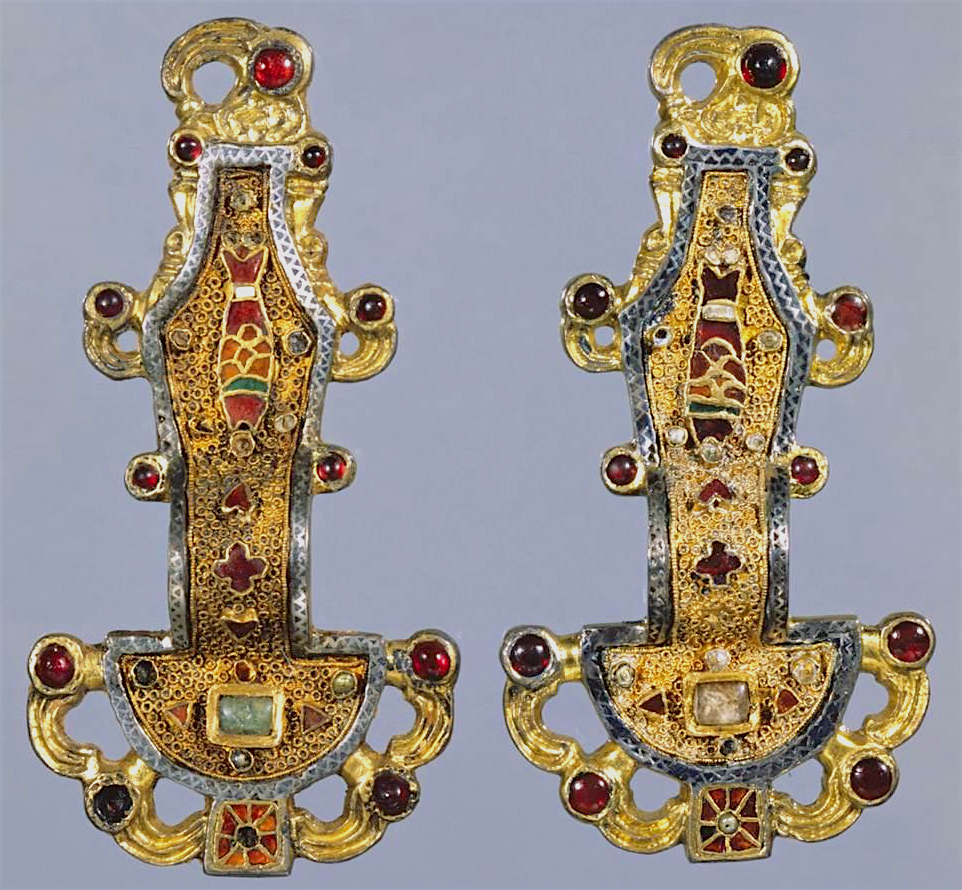
Merovingian looped fibulae, early medieval europe, mid-sixth century CE
Form: Fibula, gold, garnet, cloisonne (the technique of inlaying with semi-precious stones)
Content: ends shape of eagle head, garnet for eyes of eagle, little fish on inside, other gems and stones
Context: made popular by Roman military campaign, merovingian (powerful dynasty of Frankish rulers), used by roman soldiers to hold garments in place, this was the time when europe was becoming christianized and the Roman Empire split (Byzantine empire in east, nothing in west, Byzantine capital is constantinople), also knows as the migration period (not much info about these people, these provide the most info), found in Kranj (slovenia), eagles represent power and status (popular barbarian motif (non-roman)), demonstrate the skill of barbarian metal workers, others made by various groups of people
Function: power and status, holds clothes together
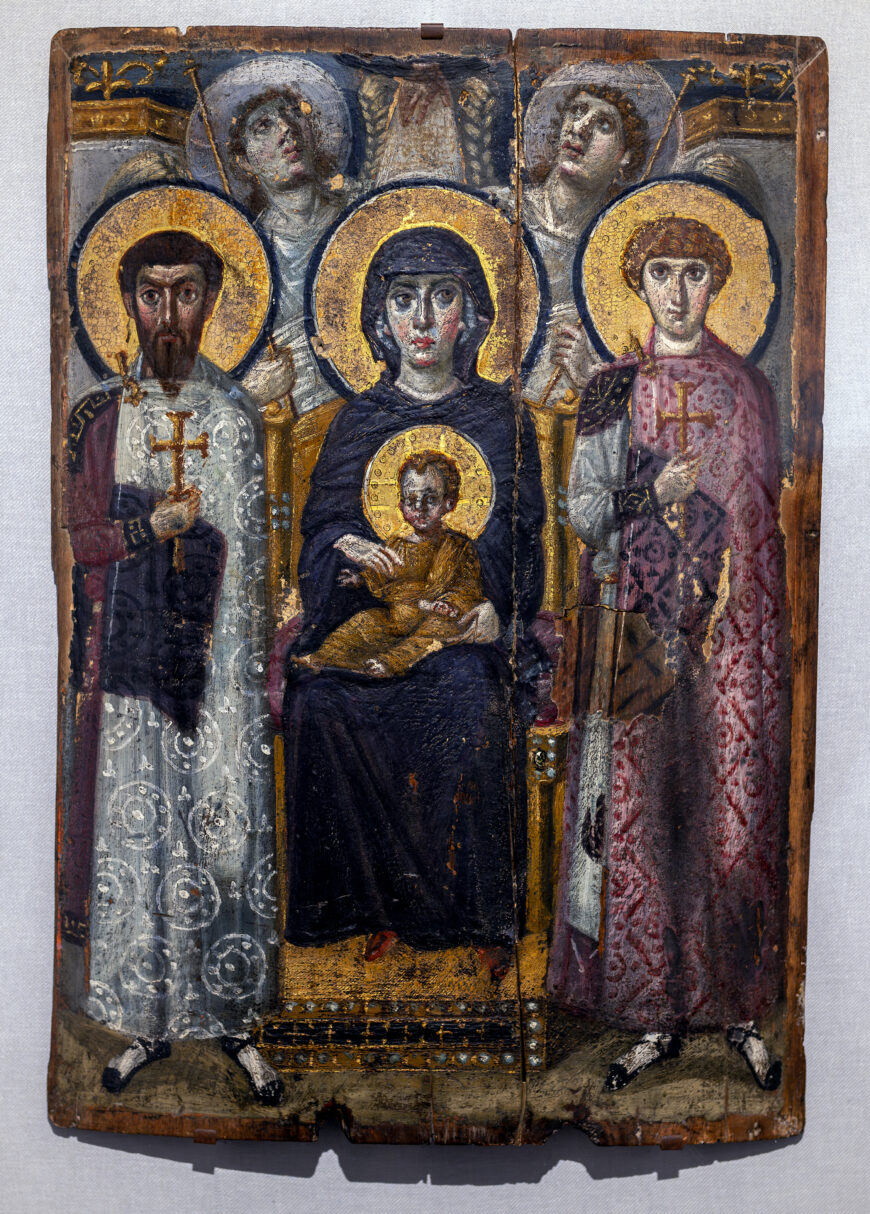
Virgin (Theotokos) and Child between Saints Theodore and George, Early Byzantine Europe, sixth or early seventh century CE
Form: Encaustic (wax mixed with pigment), Icon (greek for image or painting), wood, gold leaf, very flat, 26” x 19”
Content: spatial ambiguity (makes it feel other worldly, unsure of what is behind them), virgin (center, seated, no eye contact, on a decorative throne), Child (in lap, no eye contact), Saints ( St. Theodore and St. George, in front, closest to our world, stare at the viewer, feel slightly lifted), Angels (above, looking up to the hand of god, lighter/otherworldly)
Context: Mt. Sinai- where Moses received the 10 commandments, many works were preserved here at St. Catherine’s Monastery, “Theotokos” icon refers to the Virgin Mary holding the Christ child, most icons were destroyed during Byzantine Iconoclasm during the 8th and 9th centuries, transitional piece (roman aesthetics with Byzantine aesthetics), connection between mary through this painting, likely commissioned by Justinian and Theodora
Function: devotional object, viewers make the connection complete (earth to the heavens)
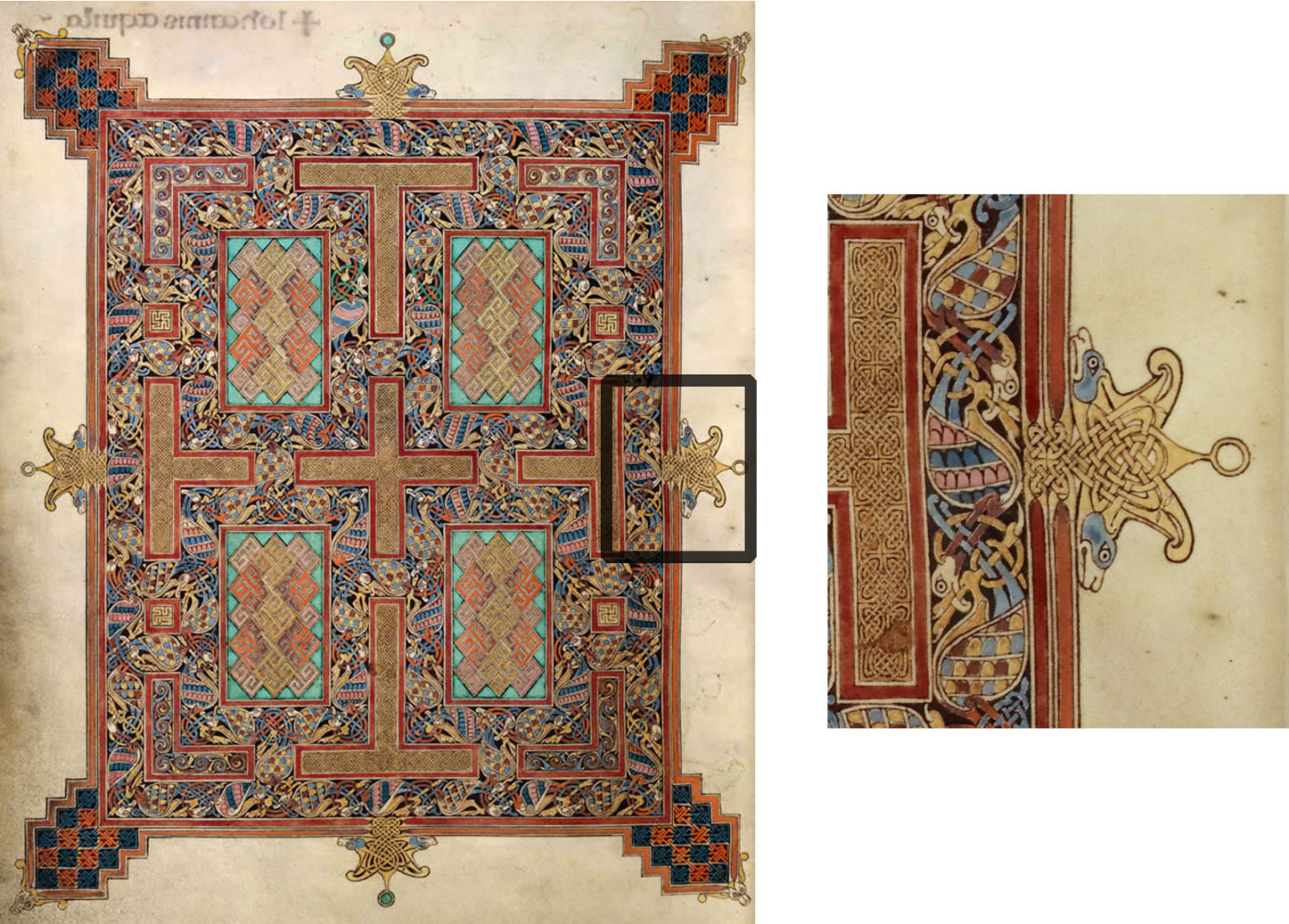
Lindisfarne Gospels, Hiberno Saxon Europe, c.700 CE
Form: ink pigment, gold illumination, vellium-calfskin (100s of animals make the entire book), 9.5”x13.5”
Content: codex (bound books), Luke portrait (writing the gospel, ox-symbol for him, halo), Incipit page (1st page of the book, repetitive knots), Matthew (angel/man), Mark (lion), Luke (ox), John (eagle)
Context:Written by Eadfrith Bishop of Lindisfarne in 698 (created it to honour god and St. Cuthbert, relics thought to have miracle power), Lindisfarne(island off coast of England, great center of learning, many people traveled here), produced in the British Isles 500-900 CE (social upheaval during this time, vikings pillaged the monastery in 793 but the book survived), cross-carpet pages- highly detailed and knotted, Hiberno-saxon style (irish curvilinear motifs, Saxon zoomorphic interlacings, cultural exchange between irish and anglo-saxon), Horror vacui (fear of empty spaces), zoomorphic animal style (animals depicted in sa stylized patters, usually seen fighting each other)
Function: record writing of the four gospels (matthew, mark, luke, and john), monks read during rituals, visual representation of people of the bible
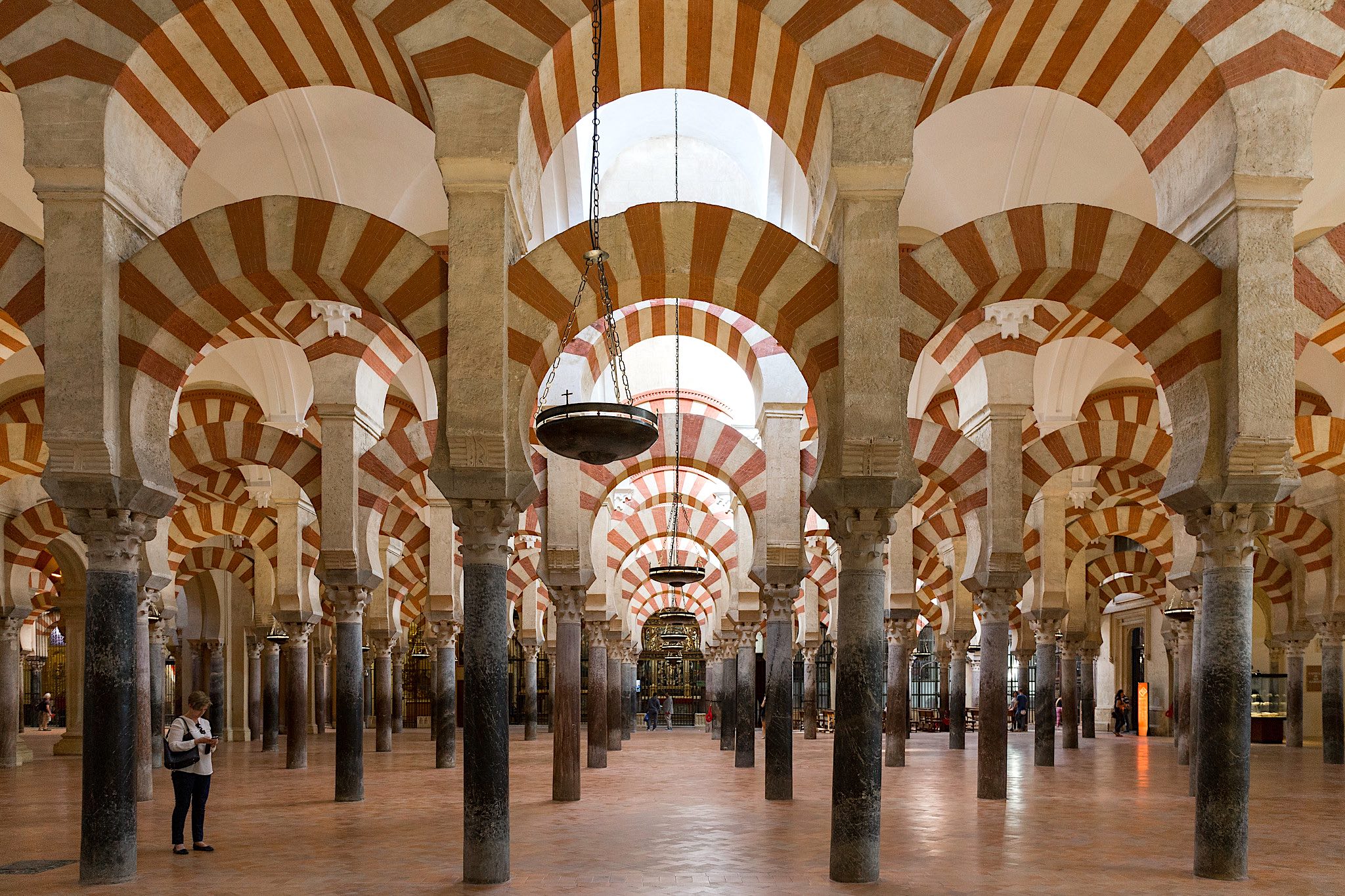
Great Mosque, Cordoba Spain, Umayyad dynasty, c.785-786 CE
Form: Mosque, Hypostyle (filled with columns), minaret (call the faithful to prayer), mihrab (wall that faces Mecca), stone that was reused from ancient roman columns, red brick, gold tesserae
Content: Hall: interior space magnified by geometry, sense of awe, prayer hall, Mihrab: focus point, famously decorated with intricate calligraphy bands and vegetal motifs, Ribbed dome: crisscrossing dome, pointed arches, anticipates gothic rib vaulting
Context: no icons, example of muslim worlds ability to develop architecture based in tradition, combination of familiar and innovative, recognizable as islamic even today, the horseshore-style arch was common in the architecture of the visigoths, prince abd ak-rahman I escaped to southern spain and sponsored elaborate building programs (courtyard orange trees that are still there), Umayyads-first islamic dynasty who had originally ruled damascus, the double arches allowed for higher ceilings
Function: Roman temple (church by the visigoths, Umayyad conquer- mosque), represents the presence of Umayyad in cordoba, place of worship, establish presence of Islam, embrace cultures
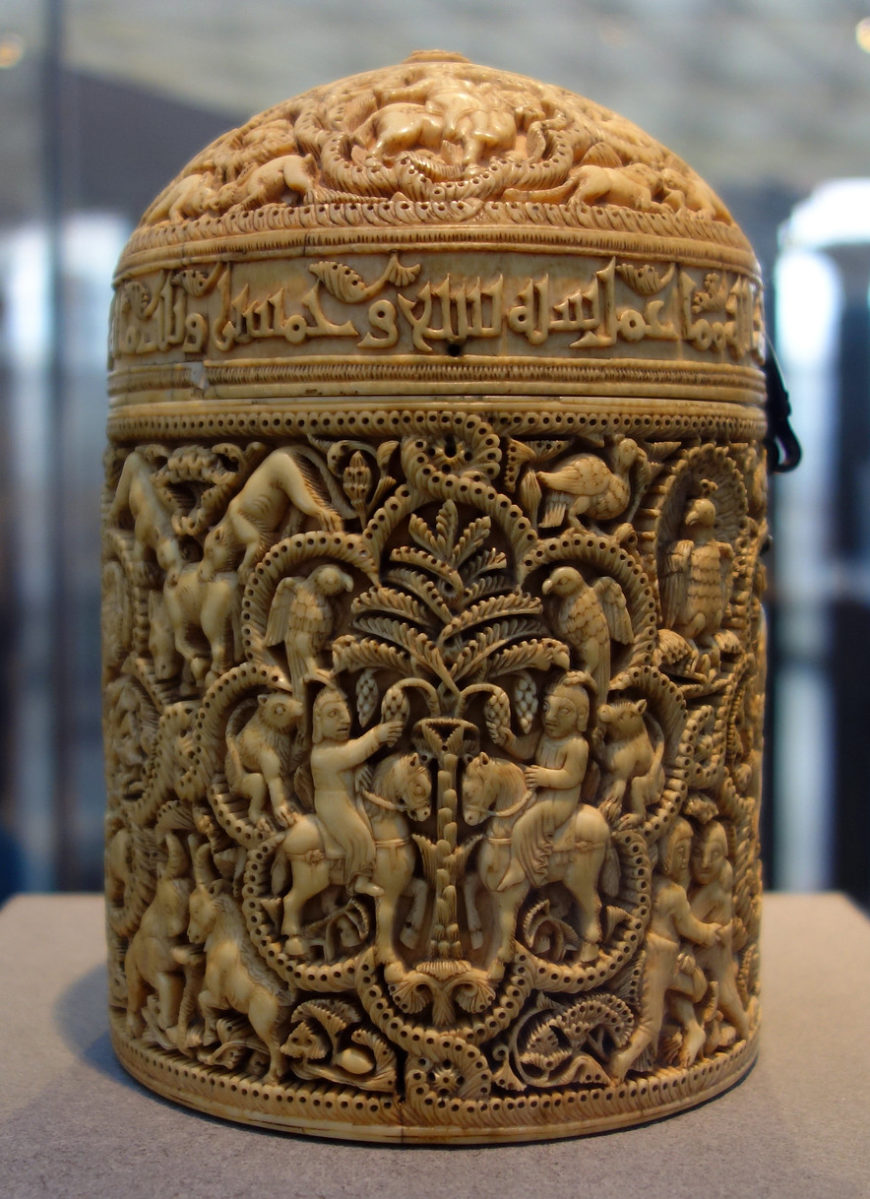
Pyxis of al-Mughira, Umayyad, c.968 CE
Form: Ivory from elephant tusk, carved with jade inlay, highly portable, Pyxis (cylindrical box used for cosmetics), 6"x3"
Content: Four eight lobed medallions (includes figures and animals, speak to the Umayyad legitimacy, inspired by Umayyad poetry), inscription “God’s blessing,favors,joy,beatitude to al-Mughira son of the commander of the faithful, may God have mercy upon him in year 357”, animals to be hunted, two bulls, men on horseback, peacocks and other birds, most likely from a workshop (Madinat al-Zahra)
Context: given as a gift to royal family members on special occasions, later as caliphal gifts to important allies, many survived, islam not strictly anionic, coming of age gift for al-Mughira (son of caliph), ivory is easily carvable
Function: cylindrical box for cosmetics, inside are smaller silver containers of perfume, could be left open to perfume a room, gifts
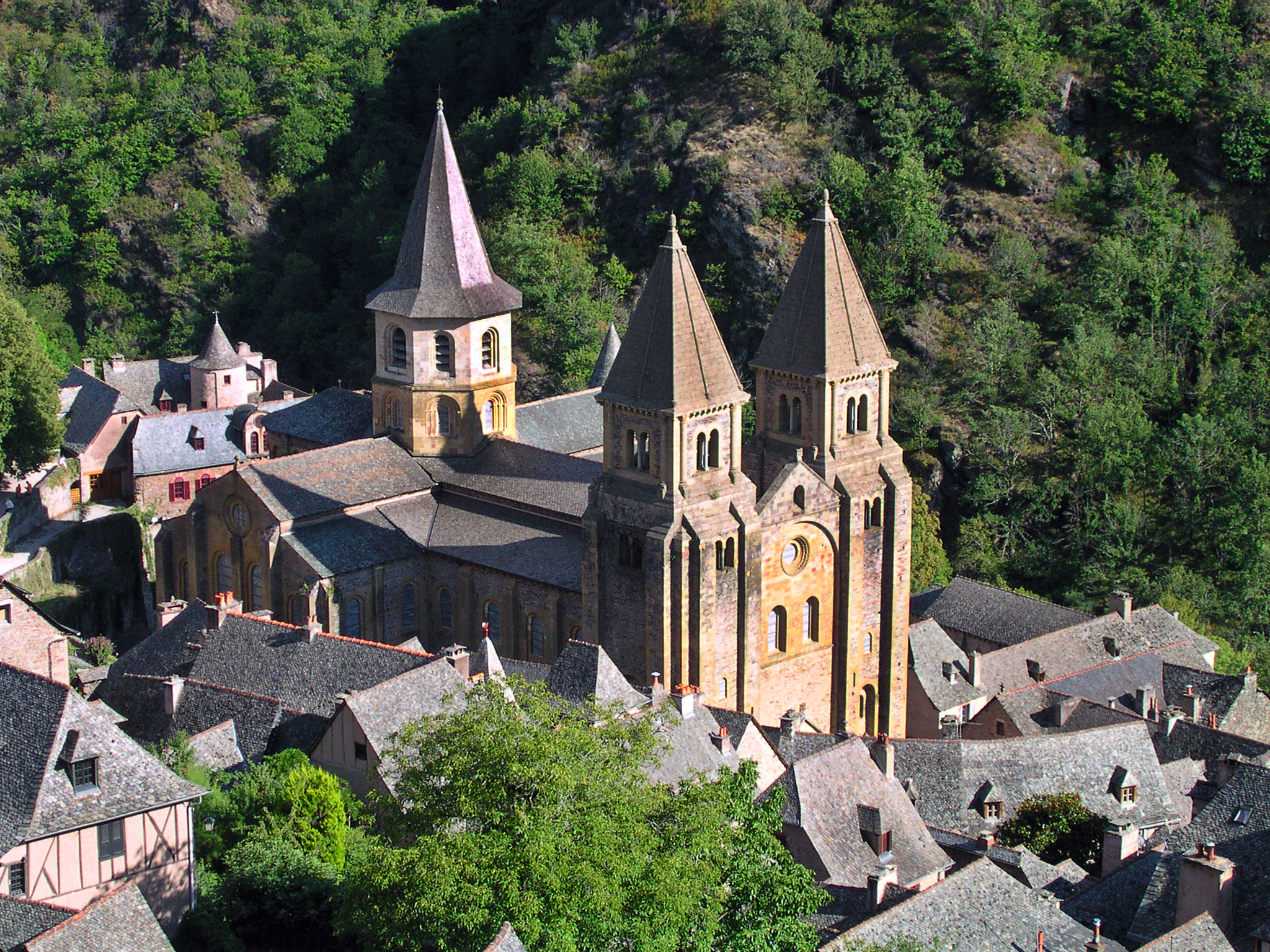
Church of Saint-Foy, Conques France, Romanesque, c. 1050-1130 CE
Form: Church: cruciform, stone. Tympanum: stone and paint, relief carving. Reliquary: enamel over wood, gold, silver, gemstones, spolia
Content: Church: romanesque-barrel vaulted nave lined with arches, pilgrimage church, designed to help regulate flow of traffic in front to apse out transept. Last judgment: semi-circle over door, christ as judge with Mary and Peter, House of Paradise below, Abraham at center, otherside has a row of angels, Hell with Devil as judge, hanged man next to devil (judas). Reliquary: what pilgrims came to see, held remains of St Foy (martyr, 12 year old convert, sacrificed), too beautiful, head from roman child statue (spolia)
Context: the church was part of a monastery, church was on the way to Santiago de Compostela, many other churches along the way looked similar, would travel here to be closer to god, ex of Romanesque art/architecture, the monastery didn’t survive, even today people pay respect to St Foy, every october a procession is held for St Foy
Function: to honor and house relic of St foy, place for those pilgrimaging, Last Judgment( a reminder of judgement and how to live), reliquary (stolen from another monastery in Agen by a monk to bring more people and money to Conques)
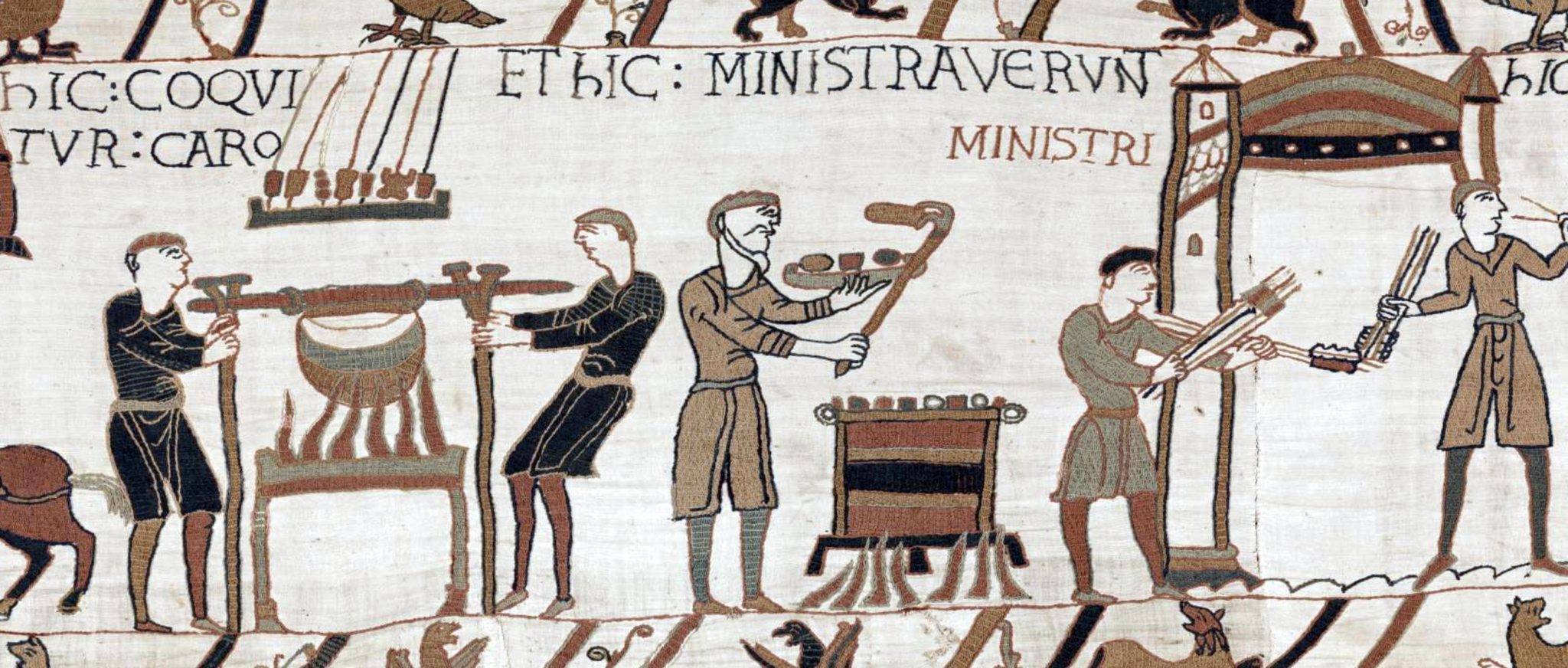
Bayeux Tapestry, Romanesque, Norman/English, c. 1066-1080 CE
Form: embroidery on linen, not a tapestry (not woven), wool yarn on linen cloth, 20” H x 250' L, 75 scenes in a continous narrative
Content: -Calvary attack: group of soldiers who fight on horses, calvary could easily advance and retreat which would scatter an opponent’s defense, flexible and intimidating, normans were calvary dominant, conical steel helmets with nose plate, chainmail shirts, shield and spears, horses were armored
-First meal: meal blessed by Bishop Ode (half brother of William and patron of tapestry), william feasts with men
Context: end is missing, commemorates a struggle for the throne of England (william, duke of Normandy, and Harold, Earl of Wessex), also known as William the Conqueror, culminates in the Battle of Hastings in 1066, many scenes adapted from images in manuscripts, three horizontal zones (main events in larger middle, lower and upper are scenes from Aesop’s fables, husbandry, and hunting), this was created only a few years after the event, at the time Anglo-Saxon needlework was prized throughout Europe, do not know the artists, william was crowned the king after the war (after edward died)
Function: a record, example of Anglo-Norman art, shows victory, chronicle, political propaganda, visual evidence, 11th century mundane objects
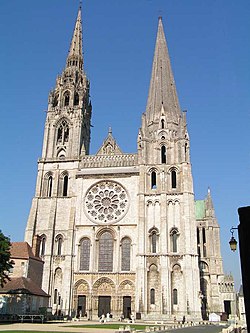
Chartres Cathedral, Chartres France, Gothic Europe, c.1145-1220 CE
Form: Limestone, stained glass, originally inside covered in plaster and painted, basilica church floor plan, blend of gothic and romanesque architecture
West Facade-Front: left tower, rose window, and 2nd stories are gothic, this was built 2nd, right tower and 1st story are romanesque, they were worried about the weight
Great Portal: jambs between doors are carvings of biblical kings and queens, elongated bodies, made up of tympanums, intels, and jambs, 3 total tympanums ( left-before christ takes a form, center-second coming of christ, right- all about the virgin mary and christ taking on physical form)
Interior: basilica plan, auxiliary hallway so that pilgrims could move through without disturbing mass, houses the relic of the Virgin Mary that she wore while giving birth, there was a fire (early gothic before, high gothic after), elevation in three parts (nave arcade, triforium, clerestory windows, draw eyes up), rib groin vault (more weight going down rather than out), wanted as much glass and light as possible (flying buttresses!!!)
Virgin Window: blue contrast with red-like gems, mary is frontal and on the throne of wisdom, window is showing scenes from marriage feast in Cana, created around 1150CE
Context: stained glass was so impressive because paintings were not common, was a pilgrimage site and house the head of St. Anne, part of a complex (a school, a place of worship, and a hospital), gothic style developed in France, the cathedral is a mix of gothic styles, continuity and change, heaven here on earth, is almost fully restored, first to use flying buttresses
Function: place of worship, pilgrimage site
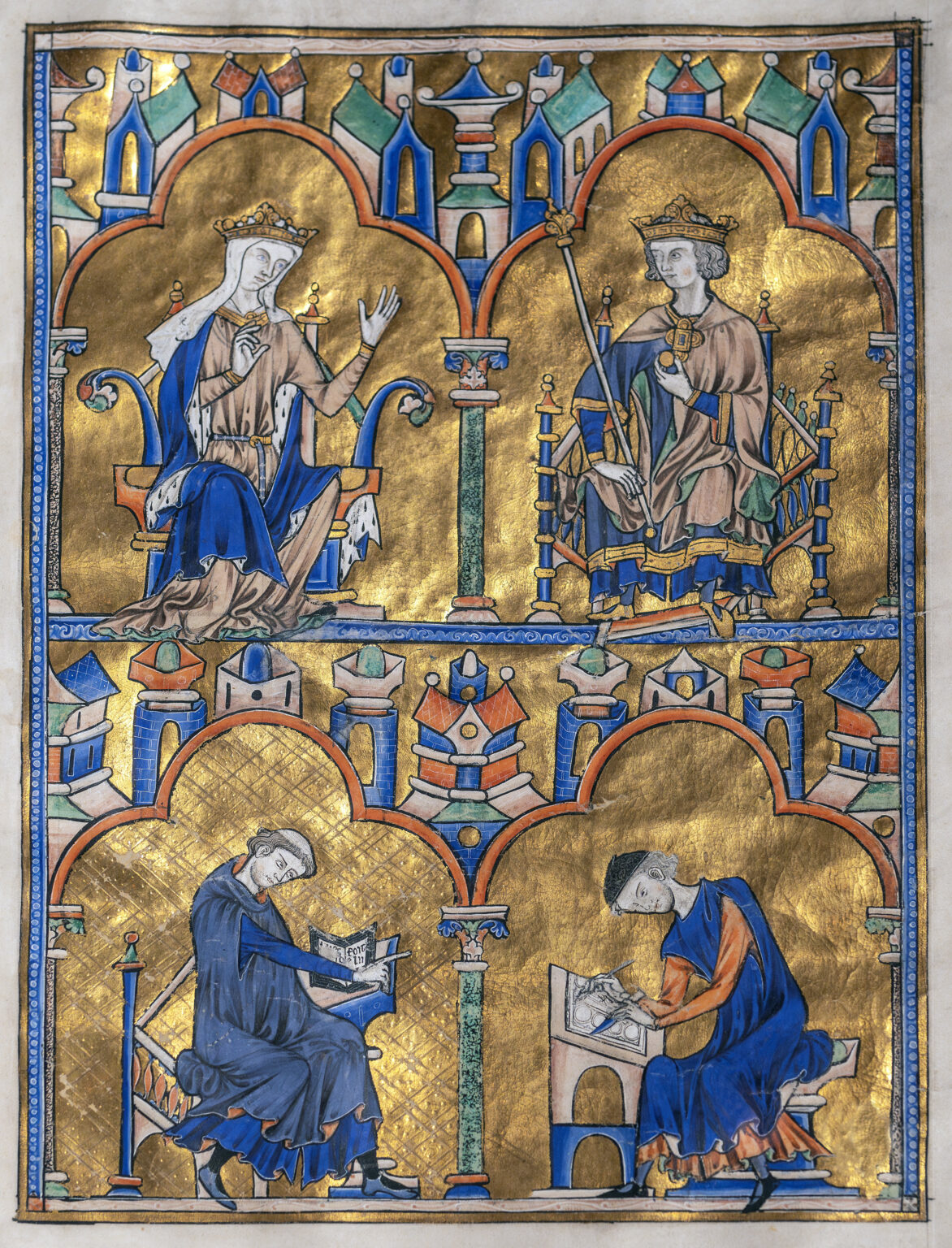
Dedication page with Blanche of Castile and King Louis IX of France, Gothic Europe, c.1225-1245 CE
Form: illuminated manuscript, gold leaf, paint, moralized bible, dedication page, scenes with roundels include verse, picture, text, and commentary
Content: Blanche of Castile (commissioned bible for son after father died, images of both of them, appear to be in the position of Mary and Christ, cleric also shown as well as artist), scene from the apocalypse (john’s vision of the end times)
Context: these bibles were made for the French Royal House, 8-10 years to complete, Louis IX’s job was to take lessons to heart, spelled out advice to readers and Louis IX, viewing the page people were reassured the king was well trained, parisians illuminated menopolized manuscript production, 5,000 medallions in entire set, red and blue (alternating, key gothic characteristics, Linking-persion and planning), extremely expensive, most luxurious bible ever created
Function: meant to teach morality, told in commentary, shows right to rule through divine right, helped Louis IX achieve sainthood status
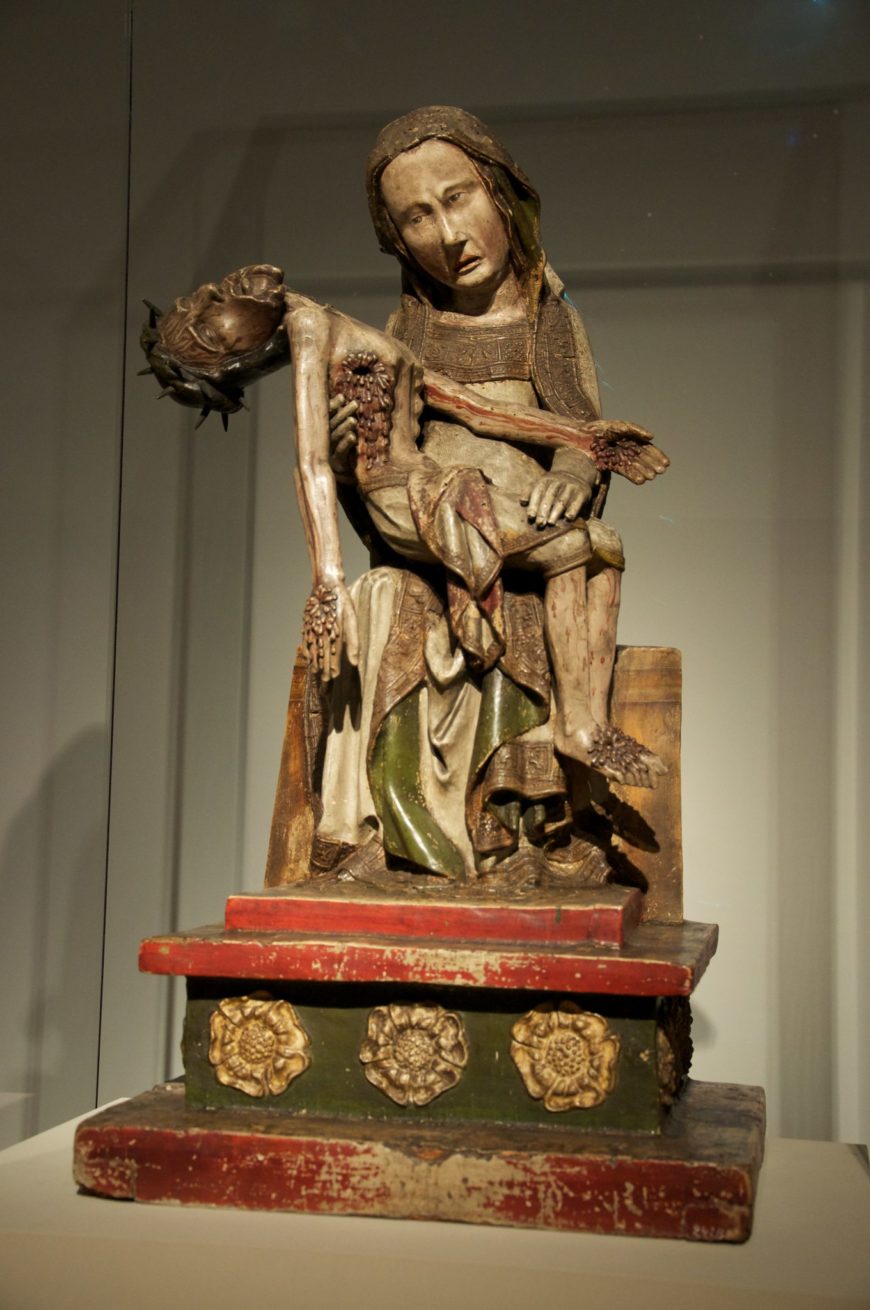
Röttgen Pietà, Late medieval Europe, c.1300-1325 CE
Form: painted wood, 34 1/2’’ tall, unrealistic proportions
Content: Mary is angry and confused, christ has shown ribs, bloody, and a crown of thorns,and 3d blood, “Pieta” mary holding a lifeless Jesus, scene from lamentation (christ removed from the cross and was mourned)
Context: many originally located in german nunneries, filled with frescos behind, early medieval Christ was divine (christ triumphans), late medieval Christ was shown as human, mysticism, the Röttgen Pietà is the most is the most gruesome of surviving pietas, emphasize mary’s humanity, stripping away narrative images, worm holes in mary’s head, paint brings the sculpture alive
Function: intended as a focal point of contemplation and prayer, on an altar, maybe surrounded by an altarpiece and frescos, experience is everything
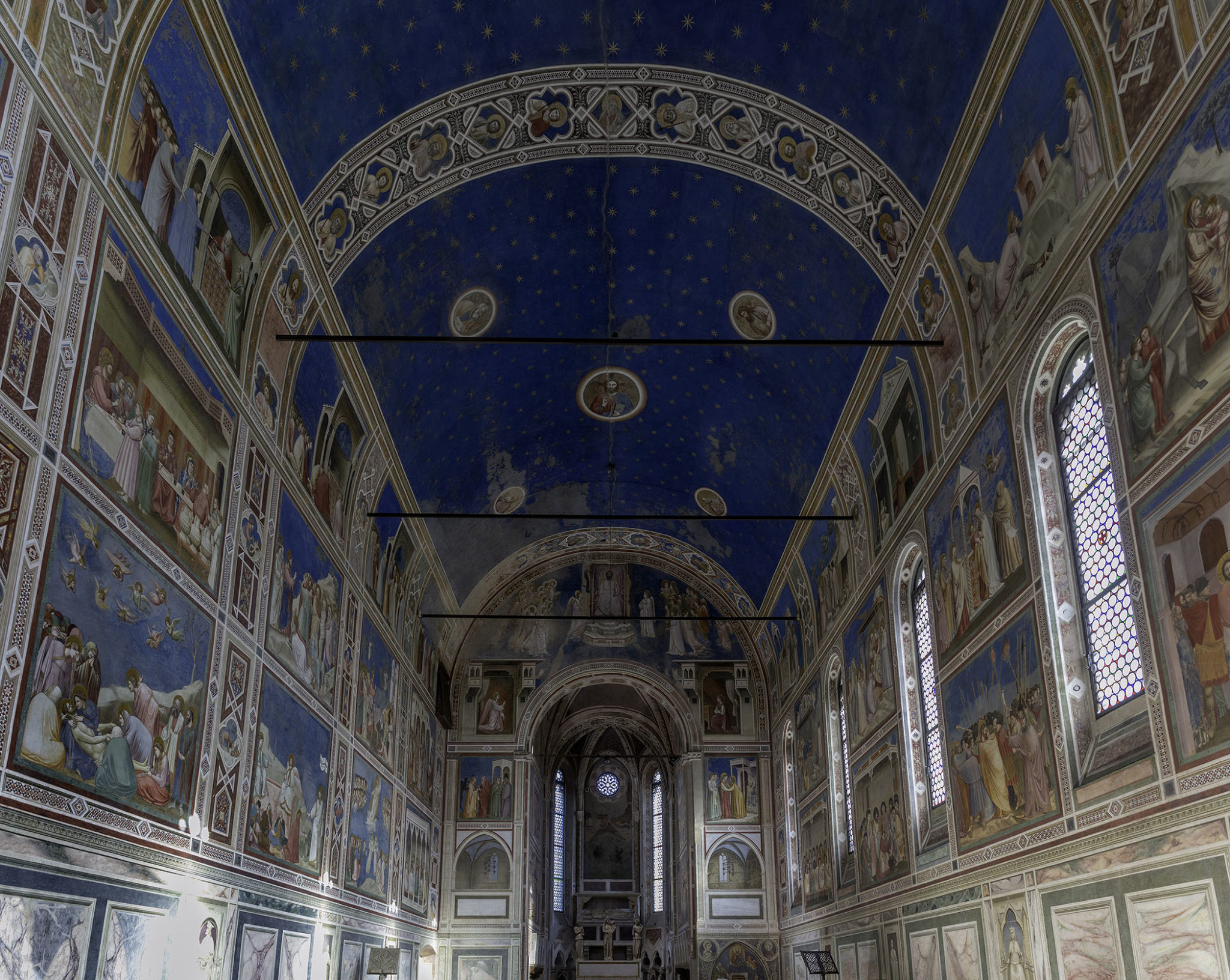
Arena (scrovegni) Chapel, Padua Italy, c.1303/c.1305 CE
Form: brick, frescos, faux painted marble, proto renaissance (also called the late gothic)
Content: -chapel: many frescos that tell the lives of Mary and Christ -Lamentation: christ has just been crucified and taken down while followers mourn him, emphasis on figures, rocky hill points to jesus, dead/winter trees, backs turned (uncommon in medieval art), angels (foreshortened to show depth, also mourning), many magdalene is washing feet
Context: commissioned by Enrico Scrovegni (a wealthy banker, he created it so he would be forgiven for the sin of charging interest on a loan), on the site of an ancient roman arena, works of art are the only way for people tp the bible (cant read and bibles are expensive), painted by Giotto, emphasis on Christ as physical, Giotto is interested in naturalism that he shows two figures from the back, many scenes show this illusion of space, purposeful placements of objects and people
Function: teach the bible, to ensure Enrico Scrovegni went to heaven
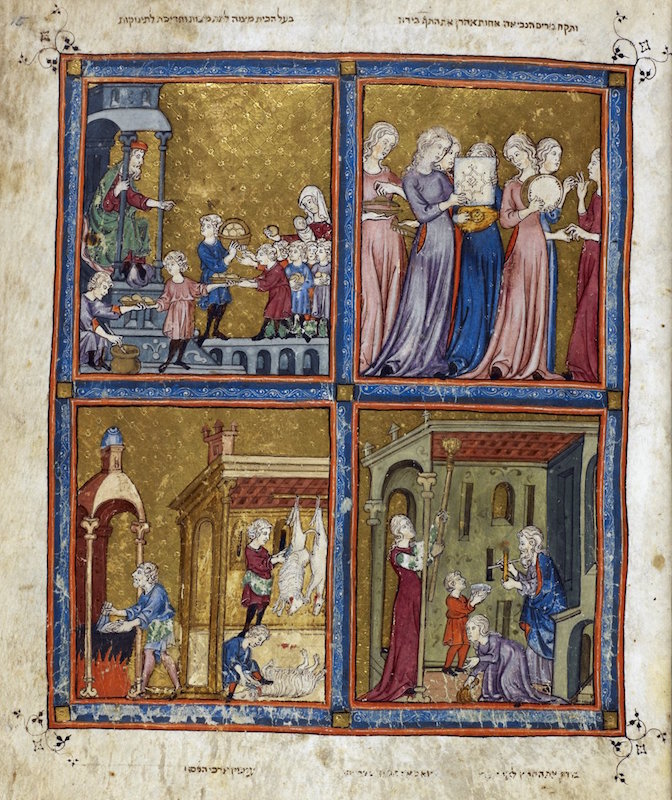
Golden Haggadah, Late medieval Spain, c.1320 CE
Form: illuminated manuscript, gold leaf on vellum, golden background, a haggadah is a book that includes prayers that would be said at the seder table at passover
Content: 56 miniature paintings, long flowing bodies, recounts the story of passover when moses led the Jews out of slavery in Egypt, figures don’t look egyptian but more french, small architecture details
Context: hebrew is read right to left, 2nd commandment in judaism forbids graven images (this is education so its ok), stylistically jewish and gothic art, stands as a testament to the impact of jewish culture in medieval spain (cross-cultural borrowing), god inflicted 10 plagues on the ancient egyptians, red mark on doors, the story of passover is recounted annually by many Jews at a seder
Function: a fine work of art used to show the wealth of its owners, tells the story of passover at seder meal, one of the most luxurious examples of a medieval illuminated manuscript
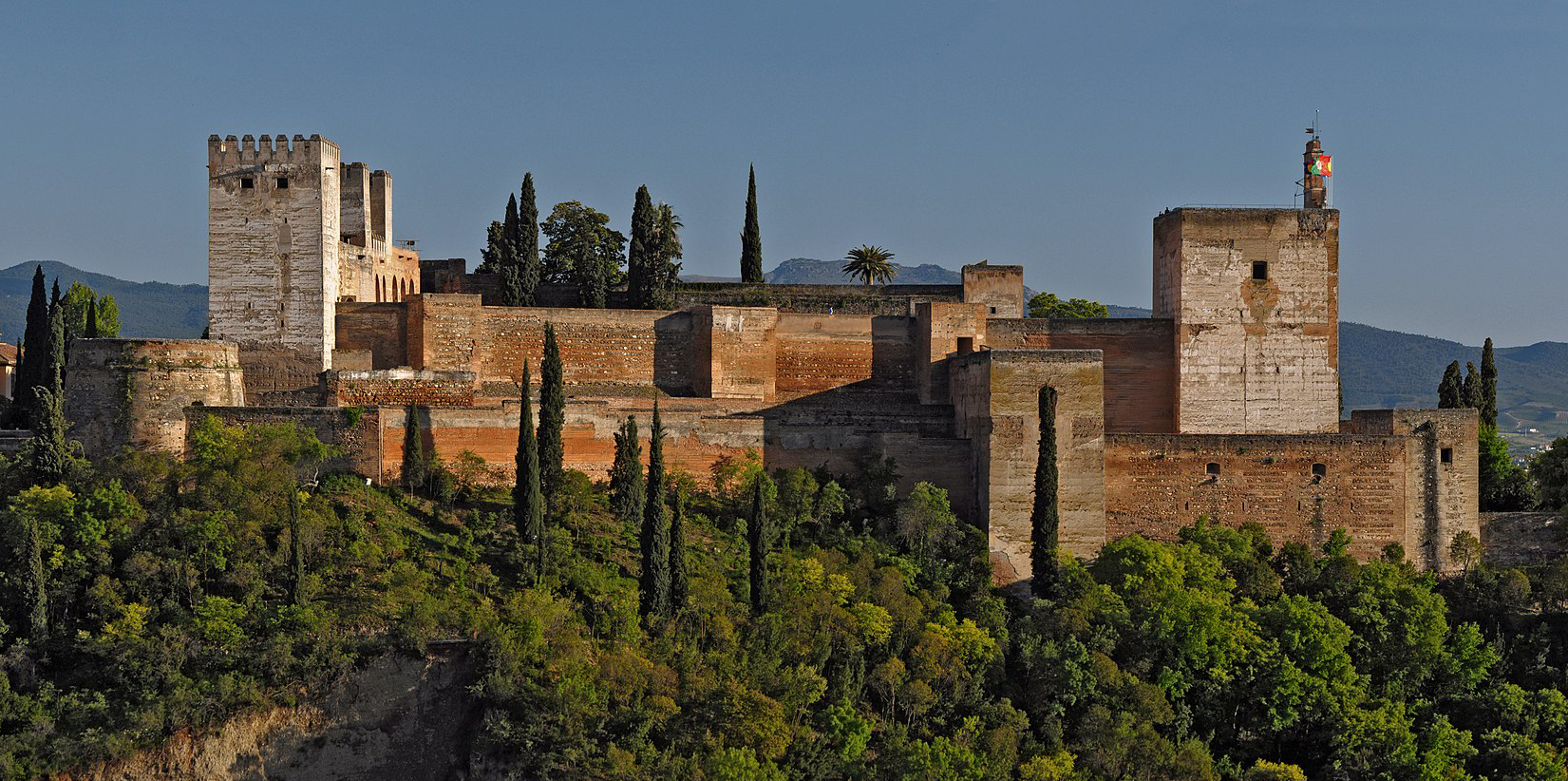
Alhambra, Granada Spain, Nasrid Dynasty, 1354-1391 CE
Form: medieval palace, one mile of walls, 30 towers, 26 arches, paths and gardens, 4 main gates, white-washed adobe, stucco, wood, tile, paint, guilding
Content: comares palace, partal palace, -palace of the lions: seperate building but later connected, arched covered patios around the fountain, built by Muhammad V, 12 carved lions (12 tribes of israel), two decorative pavilions,-Hall of two sisters: 16 windows at the top of the hall, 5,000 muqarnas (honeycomb things), used for receptions and music
Context: Jannat alafia (means paradise and by association garden or palace of cultivation), Alhambra- abbreviation for Qal’at Alhambra (red fort), built by Nasrid Dynasty (last muslims to rule spain) Muhammad I founded, the hall of the two sisters and the hall of the ambassadors were apartments, garden and water fountains,canals,and pools were common in muslim domain, a testament to the Alhambra that the catholic monarchs who besieged and took the city they left it intact
Function: served 3 functions (residence for ruler and family, citadel-barracks for elite guards, medina- where court officials lived and worked), completed for the ruler and court
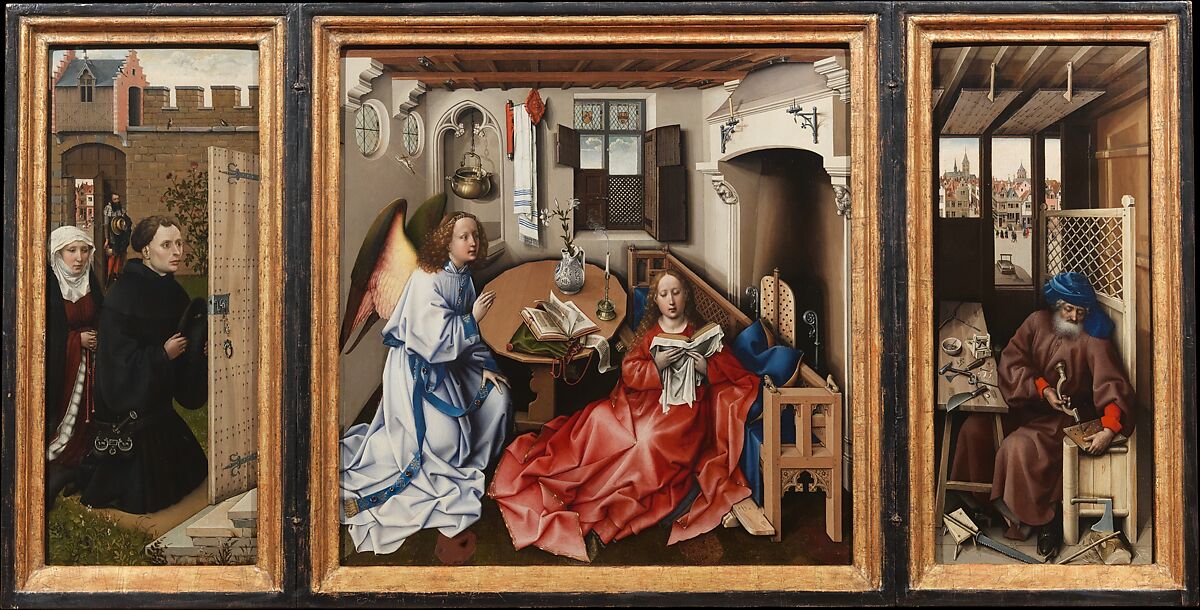
Annunciation Triptych, workshop of Robert Campin, c.1427-1432 CE
Form: Triptych, altar piece, personal, 2ft tall, could be carried, oil paint on prepared wood panels
Donors (left panel): kneeling to show they are donors (the donor was painted first and then his wife), walled garden (Mary’s purity), highly detailed (door, bolts,wood)
Archangel Gabriel and Mary: telling her she will bear christ, drapery (sharp folds, thick fabric, not realistic), very detailed with lots of items with lots of symbolism, so detailed to maintain focus, shiny pot (mary’s purity), small figure holding cross=holy spirit, space is not mathematically correct (linear perspective is new)
Joseph: mary’s husband-carpenter in the act of making, mouse traps- speaks to mercantile culture but also christ’s death, artist crafted panels-make connection to carpenters
Context: from the workshop of Robert Campin (successful painter in tornai in northern europe, wealthy place), lead to increasing interest on compassion, looks like it’s taking place in Flemish household(feels closer to us), annunciation was painted first as a spec in hopes someone would but it then customize it), northern renaissance (details!, birds, bolts, rust, city, artists pay attention to everything, interest in light, oil paint!), the naturalism of the renaissance serving that mercantile culture an their interest in things and to aid devotion
Function: devotions and prayers, use at home
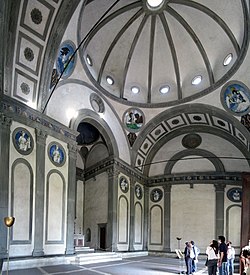
Pazzi Chapel, Florence Italy, c.1429-1461 CE
Form: mostly centrally planned, connected to Basilica Santa Croce, pieta serena (grayish green stone), terracotta with glazes
Content: images of 4 evangelists, interior decorating orderly and rational, geometric shaped rather than organic, fluted pilasters, long walls, hemispherical dome with oculus, windows on side, dome is on triangular pendentives, roundrels
Context: early renaissance example, commissioned by Pazzi family (its also a burial site), brunelleschi started it (1st modern engineer, developed linear perspective), based on roman temples, political power was in the hands of the middle class merchants, florence citizens interpreted the military victories of early 1400s as a sign of god, considered them the heir of ancient rome, civic pride through the arts, central plan and geometric shapes, the Robbia workshop made the roundels, world veiw focused on human beings, florence= new athens
Function: chapter house ( meeting room for monks), power and devotion of the Pazzi family
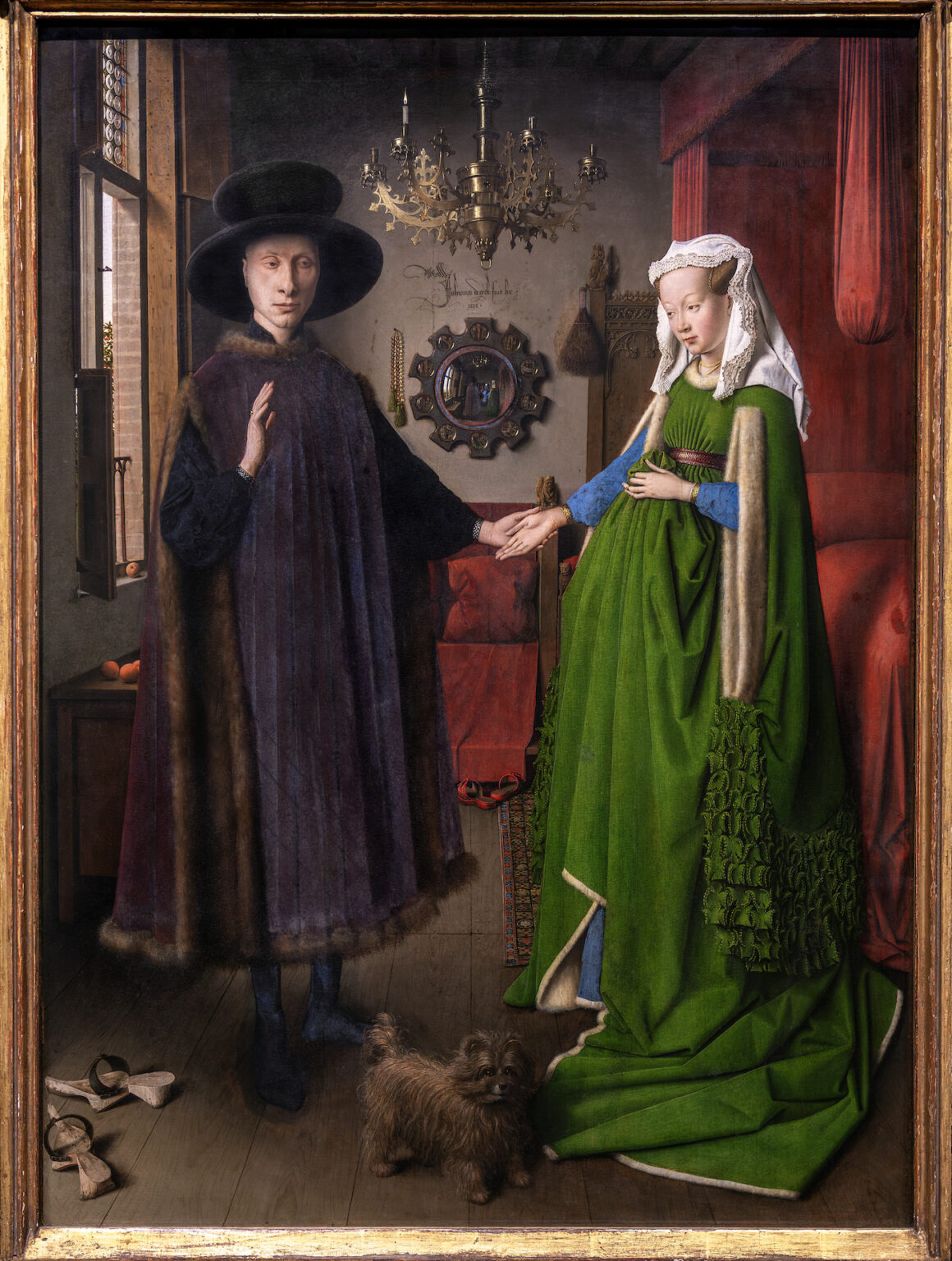
The Arnolfini Portrait, Jan van Eyck, c.1434 CE
Form: oil painting on wood panel, done with many thin layers to create depth, perspective is not accurate
Content: married couple, fancy clothes, shoes off, gathered dress, mirror with people in it, “Johannes Jan Eyck was here”, scenes from passion of Christ, dog, fruit-oranges, in bedroom/living room, laces
Context: Northern renaissance-love of texture, oil paint, attention to detail but not prescriptively correct, Giovanni di Nicolao Arnolfini-merchant from Bruges, could be memorial portrait of the wife (costanza) who possibly died in childbirth, clothes show wealth, not pregnant but soon to be, green-fertility/spring, wooden statue of saint margaret (childbirth), did not paint women pregnant, shoes off-sacred event, dog-fidelity, oranges-wealth, furs-weasel=pregnancy, bedroom-at the time a place to receive guests, love of light, Jan van Eyck-master of the northern renaissance
Function: commissioned painting, rise of merchant class allows more people access to art, a period when there’s tremendous importance put on symbolism
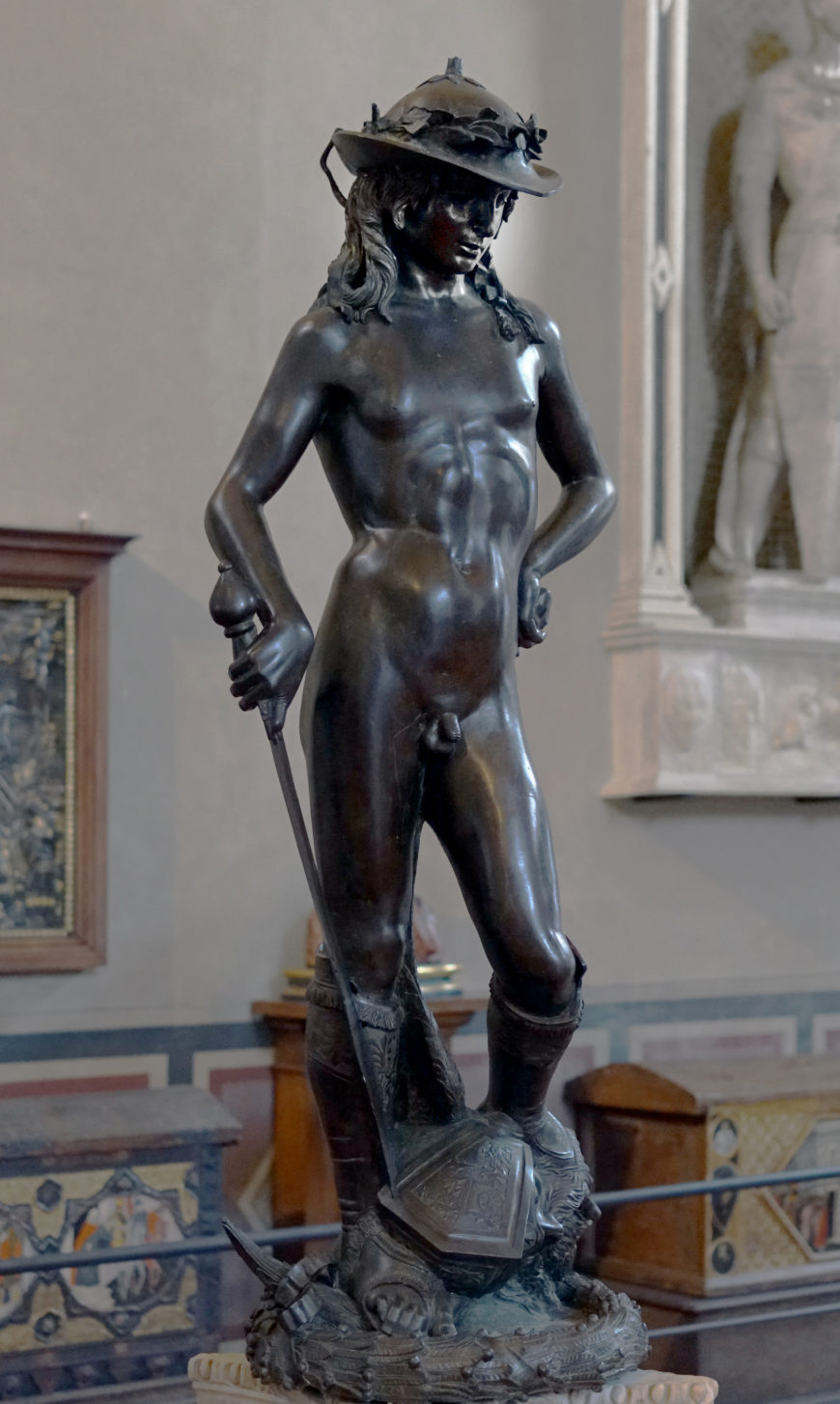
David, Donatello, c.1440-1460 CE
Form: all’antica form (in the manner of the antique), Bronze (lost bronze casting, expensive), 5 feet tall
Content: David (hero of the hebrew bible, slayed goliath as a boy, freed the israelites from the tyranny of the Philistines, youth contrasts with that of the age of goliath, shephard’s hat with victory laurels and sandals,contrapposto, nude (vulnerable and bared before god, unprecedented for bible figures, body was seen as a path to destruction)
Context: at the home of business of cosimo de’medici (most powerful man in florence), earliest known freestanding nude sculpture since antiquity, depicts david as a successor through god, earlier marble version was made with clothes, humanism (fascination with the classical world), originally on a column, men=good/superior, Florentine obsession with youthful male body
Function: david represents triumph of christianity over pagan antiquity, Medici emblem as well as a florentine one (anti-tyrannical, they are defenders of liberty), embodies desirability (he is beloved by god)
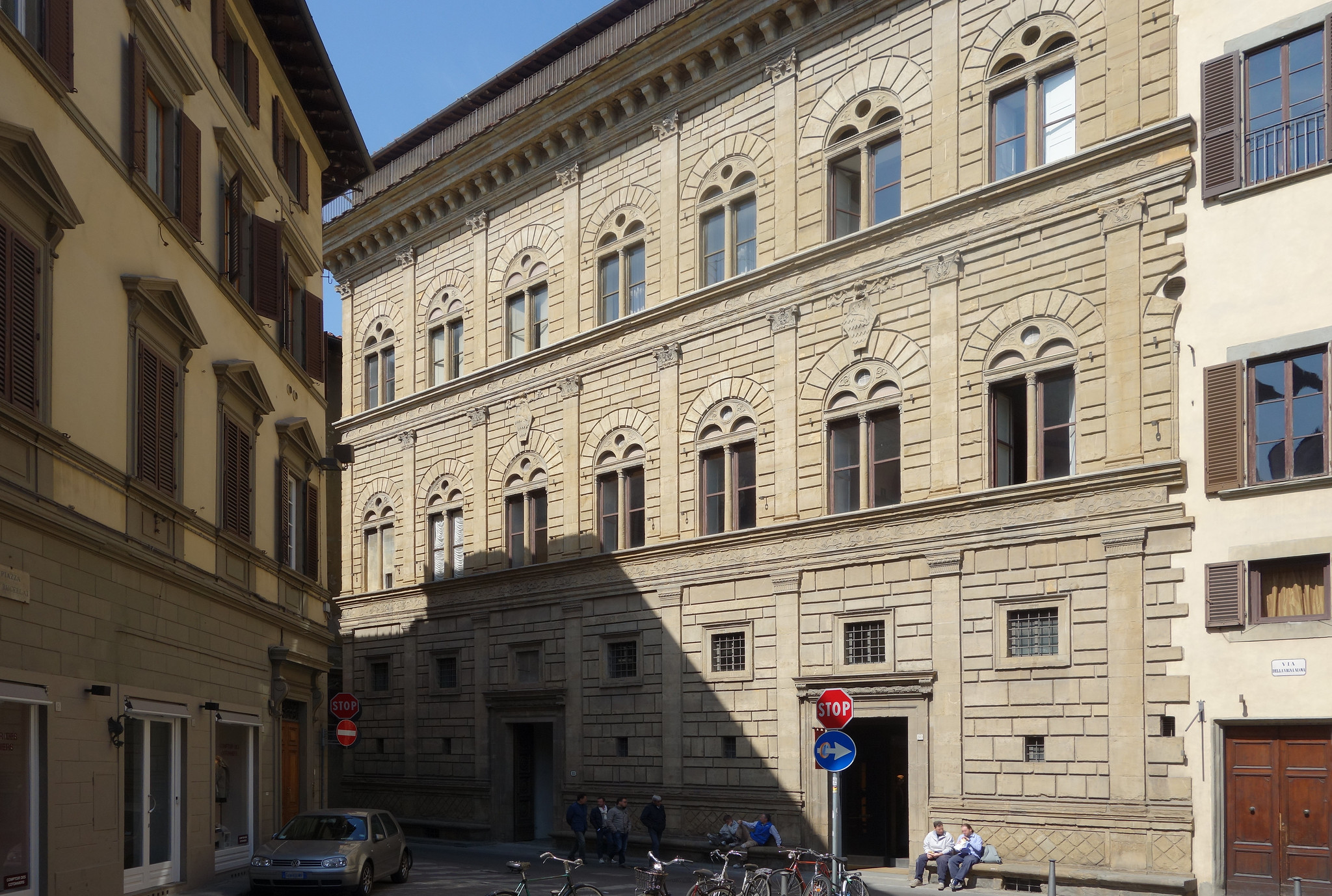
Palazzo Rucellai, Florence Italy, Alberti, c.1450 CE
Form: stone, used ashlar masonry-cut stone with very little mortar
Content: structural elements of ancient rome are replicated in the arches, pilasters, and entablatures (flat pilasters (decorative columns), entablatures define each story), large cornice on top to frame the building, surface is uniform and subtle, lines creates rhythm and unity, a palazzo (palace), long stone benches run the length of the facade
Context: Leon Battista Alberti wrote “on painting” and “on architecture”, he also designed the facade, one of the first to fully express the spirit of the 15th century humanism in residential architecture, the horizontal stuff is called “trabeated” architecture which he thought was fitting fore residential buildings, decorative architectural designs, different columns for each layer (like the colosseum), loggia-open space for the public
Function: first floor uses tuscan columns, second and third use smaller stones to give the feeling of lightness, 2nd story is the main living area, third story was private quarters, 4th hidden story was the servants quarters
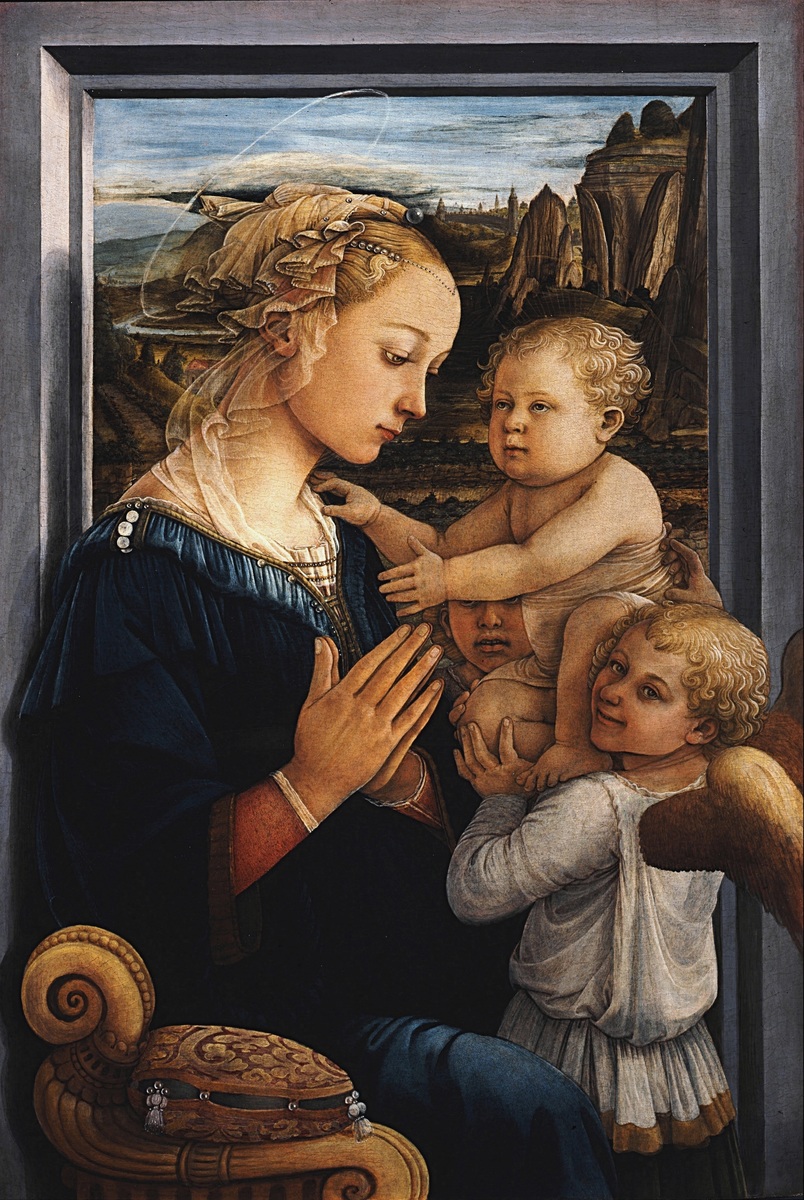
Madonna and Child with Two Angels, Fra Filippo Lippi, c.1465 CE
Form: tempera on wood, about 3’x2’, atmospheric perspective
Content: earthly/natural, landscape through a window frame, mary’s expression could show her foreknowledge of the fate of her child, figures look more life like, children are more playful than past depiction of this theme, halo is faint, mary’s hands are clasped in prayer, translucent vail, earthly space, she inhabits our world
Context: art is beginning to be thought of not just as something made by skilled workers, represents mary and child in a more human way, not focused on their spirituality like before, seems to take place in a wealthy florentine home, they do not look solemn, one angel is ,mischievous, used live models, Lippi was not a very good monk, model for mary was a young nun that left the nunnery for him, christ is their child, the Medici’s helped him escape scrutiny, Fra means Monk, influenced by masaccio, according to vasari he was very lustful, he led a colorful life, the patron was the medici family, botticelli is his student
Function: to show piety and wealth, decorative, to be reminded of christs story, wanted a humanist image for people to be able to relate to mary and christ
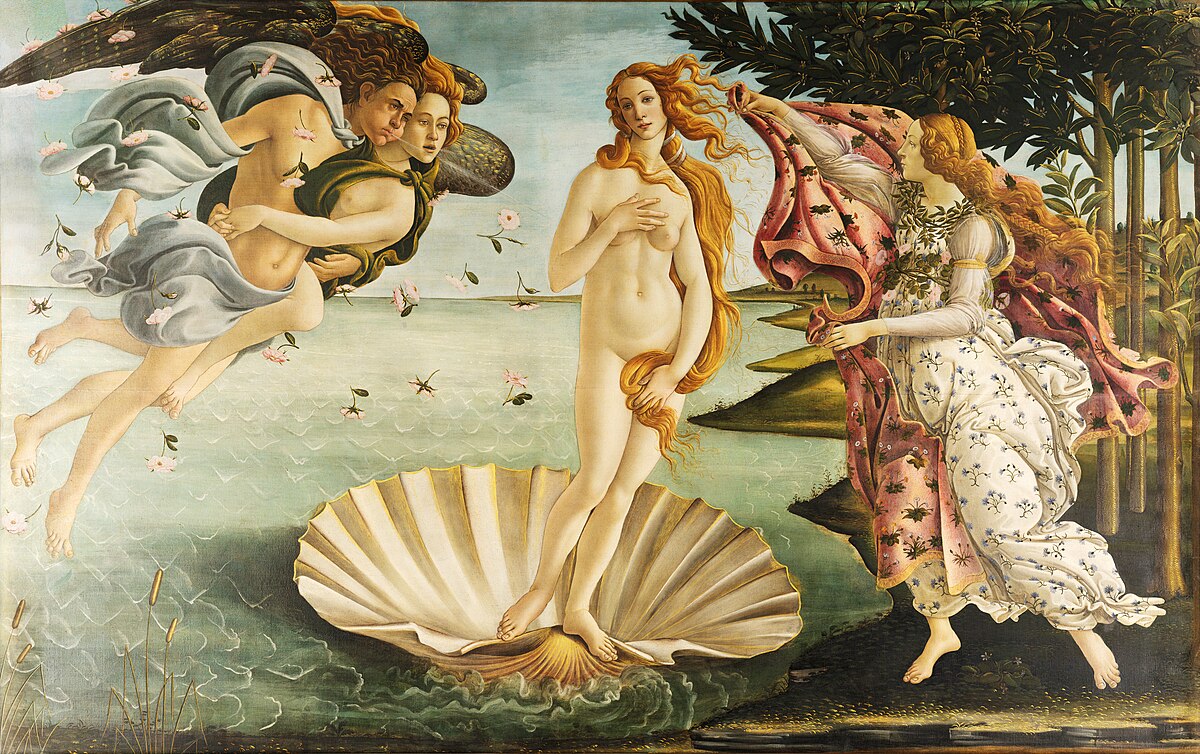
Birth of Venus, Sandro Botticelli, c.1484-1486
Form: 6ft x 9ft, tempera (long lasting, made of egg yolk, permanent, fast drying), painted on canvas (new for the time)
Content: linear style to define form, stylized waves, gold used to highlight (wealth), ignored perspective and human proportions (more interested in beauty, weightless, idealized), tempera is difficult for blending
Context: is not religious or christian in theme, Patron is the Medici family, based off a poem by a humanist poet, neoplatonic interpretation (using beauty as a way to connect with the divine, classical learning and christian ideology, venus looks like mary), starts a new era in art-allegorical painting, at the time christian subjects were depicted in the nude but its a sign of shame, here venus is modest but not shamed, model for venus (Simonetta Cattaneo de Vespucci), medici is the patron, lapis
Function: exploration of human form, celebration of classical art form, not religious, based on a roman goddess
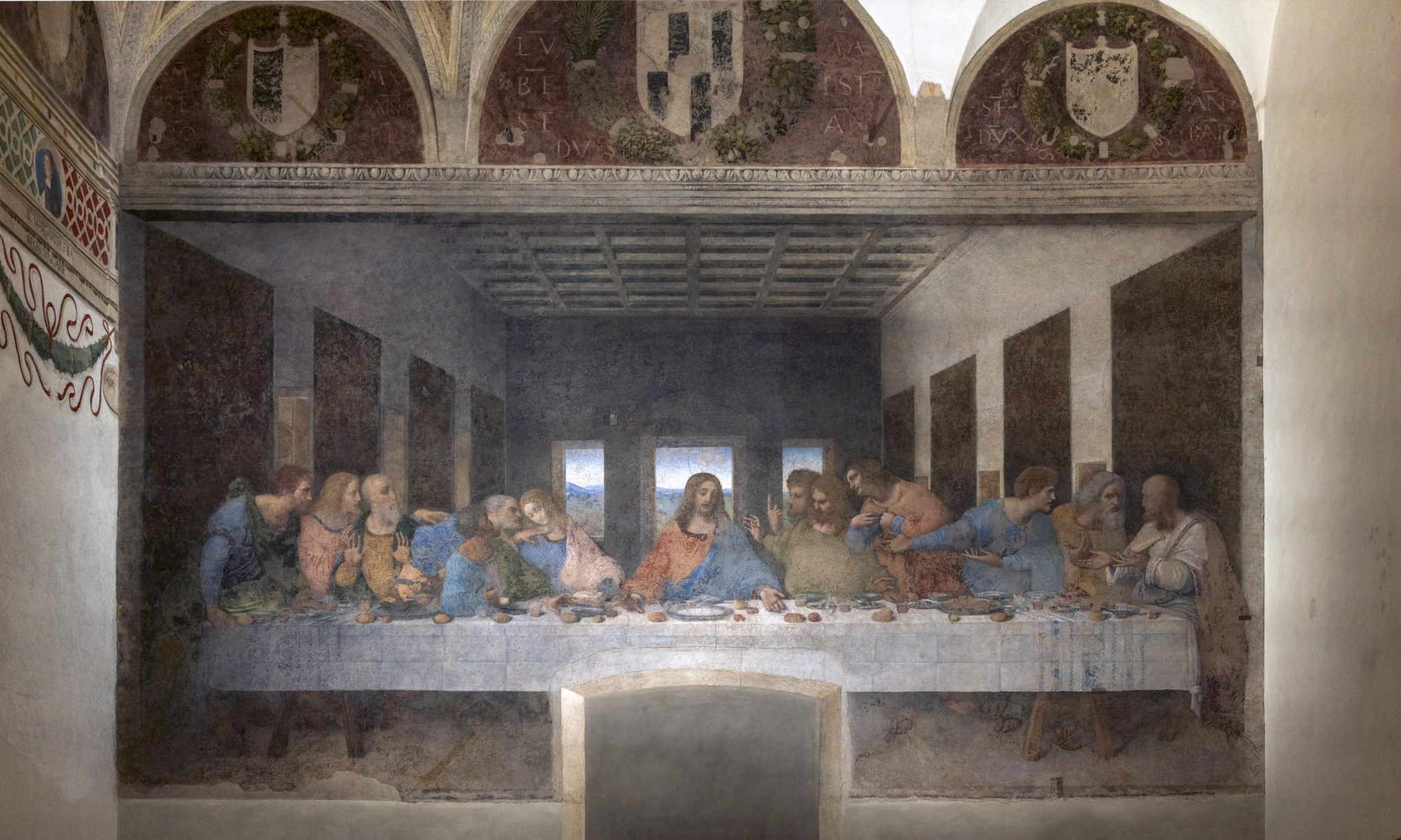
The Last Supper, Leonardo da Vinci, c.1494-1498 CE
Form: oil and tempera, plaster walls, sfumato, painting technique for softening the transition between colors
Content: light source is like real like (only judas is in shadow), no halos, utilizes both atmospheric and linear perspectives, the tapestries on the wall in perspective add depth, each figure is individualized reflecting their pwn personality
Context: Patron is the Duke of Milan, located in a refractory, in poor condition, experimental technique (not an original fresco, double layer of dried plaster, did not adhere to the wall), undercoat of lead white to enhance the brightness, the painting is on a thin exterior wall, humidity, 7 documented attempts to repair it, only surviving work of his in the original place, it got bombed and flooded, leo believed painters should paint man and the intention of his soul, observed people to vividly express emotions in his art, wanted to depict precise anatomical details and real human emotions
Function: monks ate in this room and would look at it, illustrates unity between the mortal and eternal
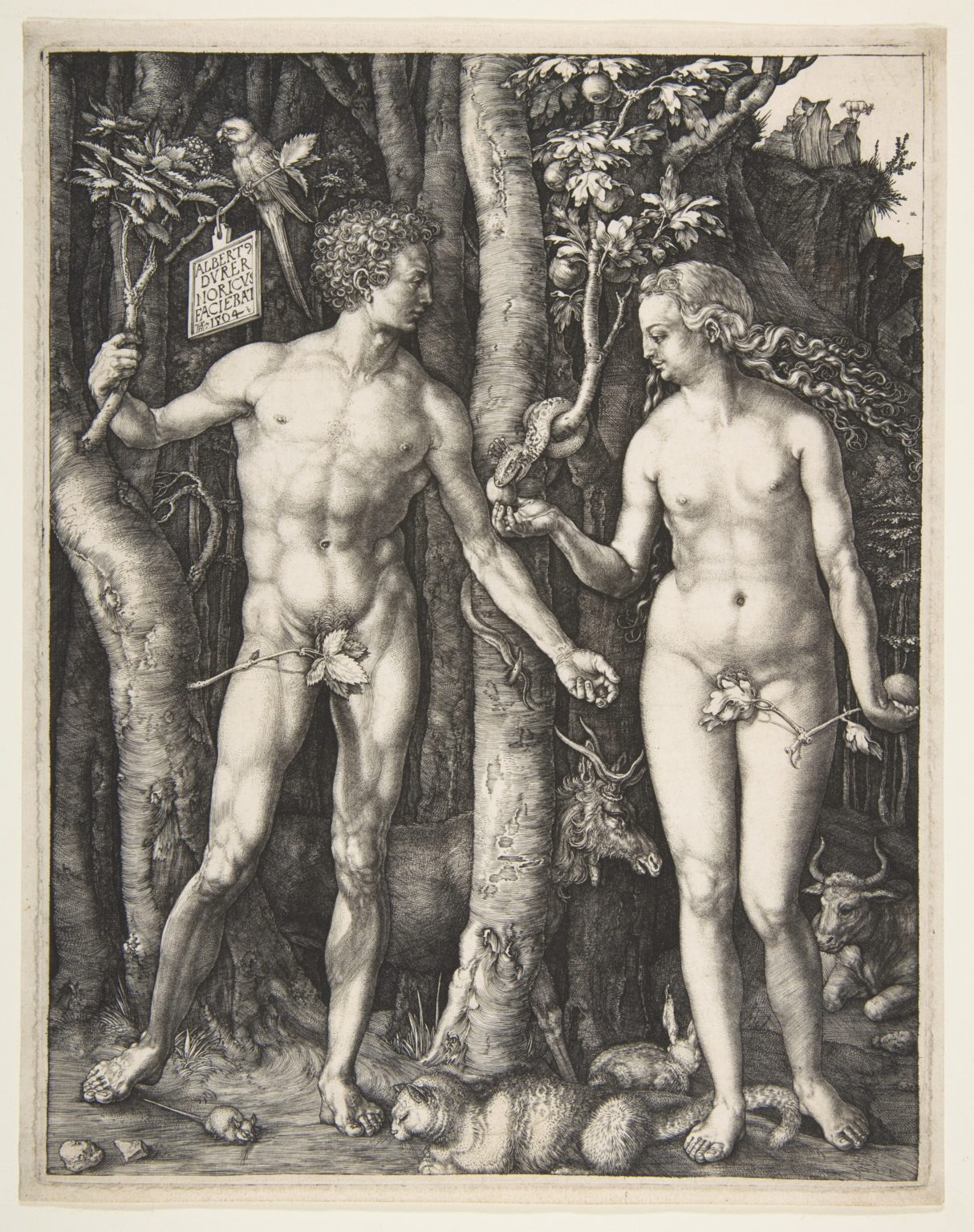
Adam and Eve, Albrecht Dürer, 1504CE
Form: Engraving, focus on mathematical proportions not natural, about 8×10”, more life like drawing, what you carve is what you see, metal plate, use a sharp tool, light and shadow, ink, go through the printing press, much harder on metal plate
Content: Adam and Eve in the garden of eden forest, cliffs in the background, contrapposto, eve reaches for the apple, snake around the tree, adam holds a branch, variety of animals, adam and eve are in a balance, before the fall of man, artist put his name in it
Context: Dürer not only experienced the transformation from gothic to renaissance he was an agent of the change, after traveling to venice he incorporated the italian renaissance principles like linear perspective into his work, portable, worked on this print for 4 years, dürer was scientific minded, the poses show off dürer’s knowledge of proportions, the elk,ox,rabbit, and cat exemplify the four humours, shows a moment of perfection in the garden
Function: story telling of the story of adam and eve from the bible, dürer used his prints for profit and recognition
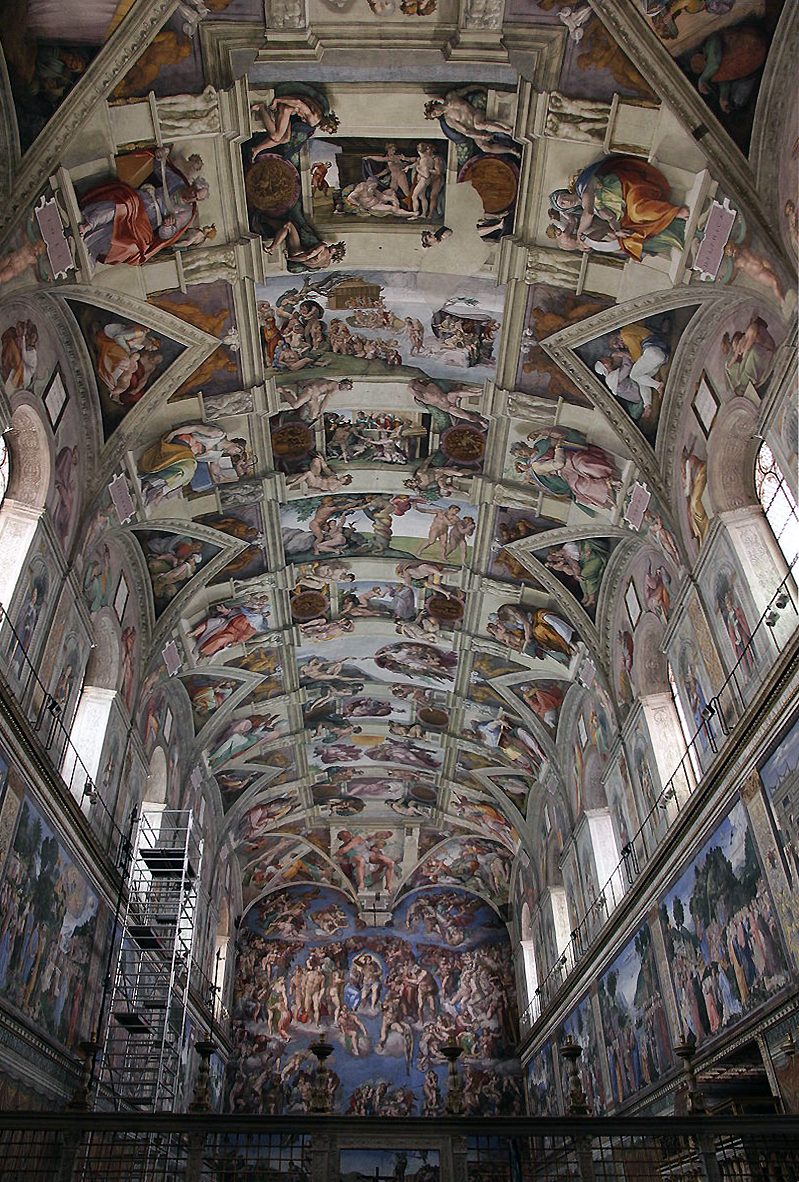
Sistine Chapel ceiling and altar wall frescoes, Venice Italy, Michelangelo, c.1508-1512
Form: stone, frescoes, the ceiling was originally blue and covered in golden stars, in 1508 Pope Julius II commissioned it
Michelangelo: The Italian Renaissance Painter, sculptor, architects, and poet, he was called the divine one, his art was in high demand, he was emulated by artists, celebrated by humanists, and patronized by 9 Popes
Sistine Chapel Ceiling: The narrative begins at the altar( divided into three sections telling the story of genesis, the creation of the heavens and the earth, the creation of adam and eve and the expulsion from the garden, the story of noah and the great flood), sibyls-ancient seers who foretold the coming of christ, addition stories from the bible, four years to paint the ceiling
The Delphic Sibyl: has a circular composition of the body, knee and elbow come into view, sculptural elements to the figures, used male models for women figures, completed sketches first, transition in style from Delphic to Libyan, holding a scroll with a prophecy, use of visual illusion to make it seem 3D
The Flood: Complex narratives with lots of emotion, not easily seen from the floor, used physical space of the water and the sky to separate 4 parts of the painting(left-people climb to a mountain to escape the rising water, Middle-small boat is capsizing, Right-people huddle under a makeshift covering, Back-men are working to build an ark)
Context: in 1510 Michelangelo took a year off and the paintings look different after it, color is a jewel-like palette, use of light and dark, architecturally hard to paint, he wasn’t that experienced in fresco painting, nudity-humanism, frescoes on the wall by Botticelli, Ghirlandaio, and Perugino
Function: since 1492 it has been the chapel where the new pope is elected, the use of bright colors and larger than life images gives it the religious sentiment
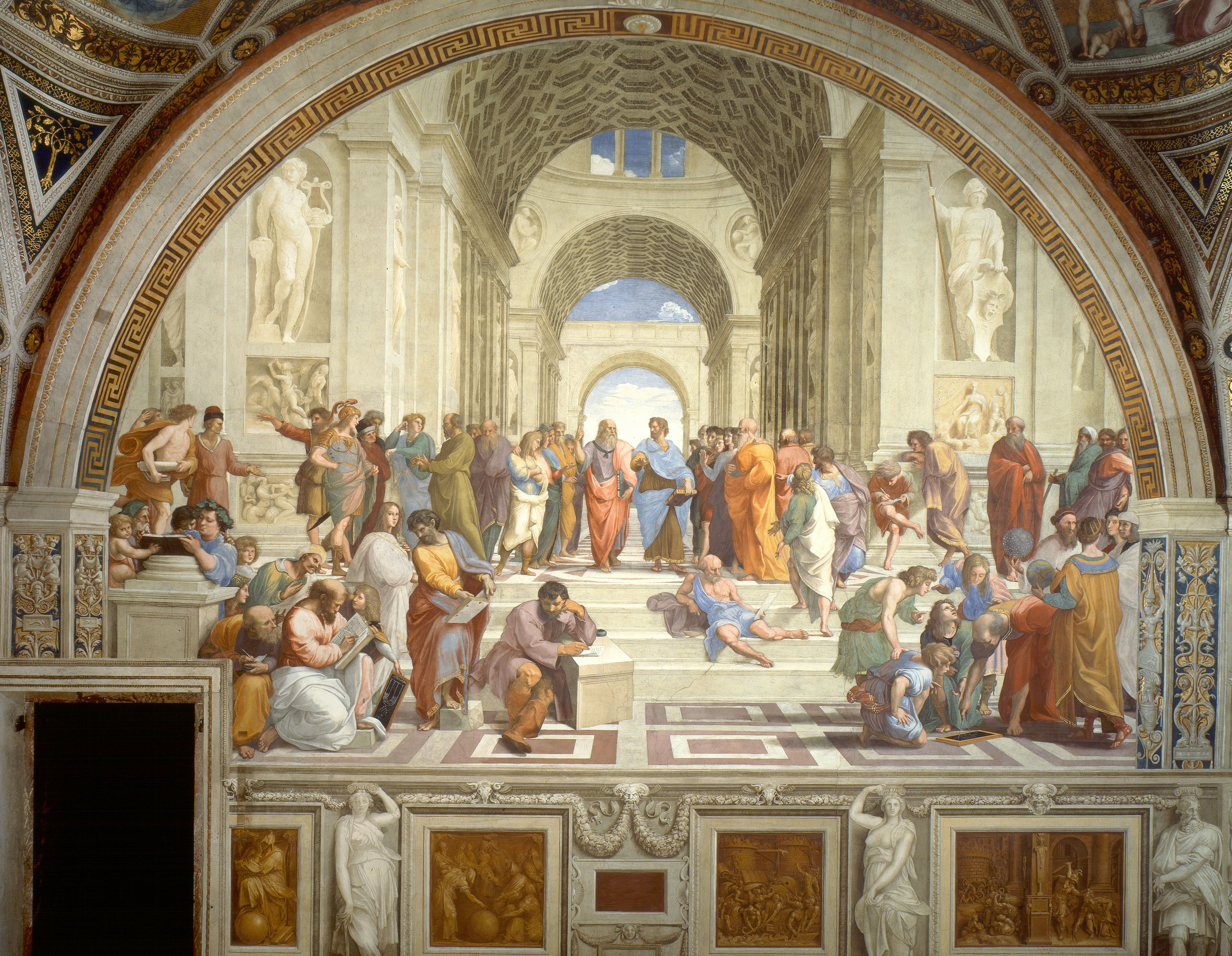
School of Athens, Raphael, c.1509-1511
